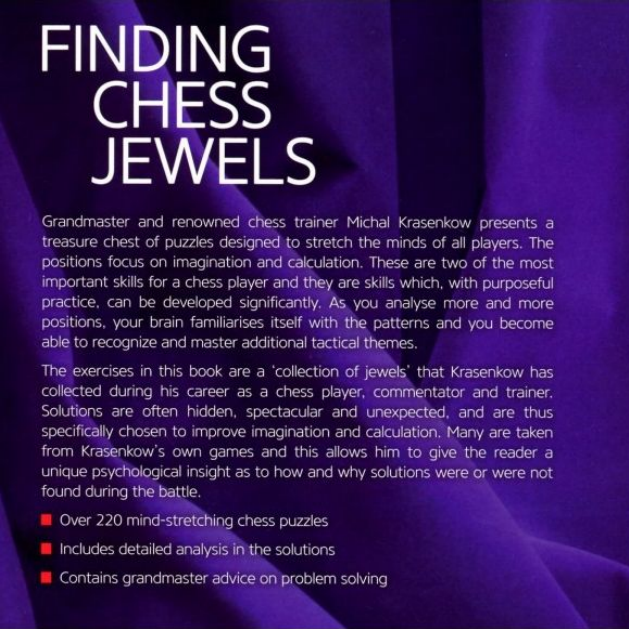


MICHAL KRASENKOW
FINDING
CHESS
JEWELS
improve your imagination and calculation

About the Author
Michal Krasenkow is a Grandmaster, a multiple international tournament
winner, a former World top-ten player who reached the 2700 rating, and a
two-time Polish Champion. He's a FIDE Senior Trainer, has worked with
many top players including Vishy Anand, and has been the national coach
of Poland since 2010. He's made numerous major contributions to opening
theory, and has written books on the Open Spanish and the Sveshnikov
Sicilian.

Contents
About the Author
4
Contents
5
Introduction
6
1 Jewels
14
Jewels: Solutions
77
2 Brooches
100
Brooches: Solutions
172
3 Necklaces
207
Necklaces: Solutions
299

Introduction
In general I consider that in chess everything rests on tactics. If one thinks
of strategy as a block of marble, then tactics are the chisel with which a
master operates, in creating works of chess art.
Tigran Petrosian
I am sure this is not the first workbook of chess tactics you hold in your
hands. However, it is a bit different from the collections of exercises based
on the principle of competition, in which you collect points and then proudly
count yourself amongst experts or, regretfully, amongst dullards. Here,
however, you will enjoy every exercise, whether you find its solution or
have to look back after seemingly fruitless efforts. That’s because the
solutions are always hidden, unexpected and spectacular – that was the
criteria of selection.
There are two kinds of beauty in chess: the ‘beauty of paradox’, where the
Gordian knot of problems is cut with a tactical strike or a subtle, hidden
manoeuvre; and the ‘beauty of logic’, where a player, using his opponent’s
minor inaccuracies, consistently imposing more and more strokes, paints
the canvas of victory. This book deals with the first kind of beauty. Pay
attention to the fact that I have not said anything about sacrifices. Indeed, a
sacrifice, a break from the routine notion of material relations, always
causes fascination, but it is by no means a compulsory condition of
brilliancy.

Imagination is one of the most important qualities of a chess player. Partly,
of course, predetermined by a player’s innate abilities, it can, however, be
significantly developed. The room for progress is vast. In fact, most of
possibilities hidden in the multitude of chess positions could hardly be
discovered before we obtained tools possessing perfect imagination: chess
programs. For an inanimate computer, all moves, obvious or phenomenal,
are equivalent, and when you analyse with a chess engine, you can only
wonder what huge reservoirs of niceties remain out of human sight. So, the
unattainable ideal is with us; the only problem is how to approach it. There
is no other way than training your brain: solving numerous tactical
exercises, tackling endgame studies, and analyzing games without
computer assistance. The more positions you solve and analyze, the better
your brain works, the greater the pool of tactical methods you master, and
the easier you can find the right way in a number of similar situations.
What signals suggest a possible tactical solution? A poor position of the
king is probably the most common of them. Far advanced passed pawns
often create tactical possibilities too. However, the most important thing is
to detect so-called tactical weaknesses: pieces and pawns which can be
attacked or captured. In many books you can find a formal definition: a
tactical weakness is a piece or pawn which is unprotected or protected as
many, or less than the number of, times as it is attacked. That is true, but
not completely true. A piece (or pawn) can be protected twice or thrice, but
all those defences can be delusionary. Such weaknesses are difficult to
detect, and the capture of such pieces or pawns is usually hard to find and
spectacular. The other kind of tactics, the most difficult for many players, is
placing your own pieces (without making a capture) on squares attacked by

enemy pawns. Such moves are relatively easy to find in attack, but very
hard in other circumstances. Only training and experience can help here.
Calculation
The other important issue related to chess tactics is how to calculate
variations. A number of theories have been created on this matter by
various authors, from Alexander Kotov to Valeri Beim. However, I agree
with Mark Dvoretsky, who said: “A human is not a machine, hence there is
no ideal algorithm of calculation.” Some tips are indisputable: you should
calculate in sharp, critical positions and stop if the position can be
evaluated without further calculation or when the calculation doesn’t impact
your choice of a move. Here are some others, based on my own
experience and practice:
i. I recommend that before you start calculating, you set up a target,
adequate to the evaluation of the current position. It can be, for instance, a
win, an advantage, but also, for instance, the way of putting up the most
stubborn resistance in a poor position. If you have a lot of time, you can set
up a more ambitious target; under approaching time pressure it can be
more modest. It often happens that you must choose between a simple
move, easy to evaluate and not requiring extra calculation, and a
complicated continuation, which demands deep immersion. In that case the
target of calculation is clear: to get more than the simple continuation
promises. Knowing what you want to achieve will help you to accept or
decline particular moves and variations. It will be your guide in looking for
your or your opponent’s ‘candidate moves’ (i.e. those which can help you to
achieve your goal or to prevent that, respectively).

ii. Don’t move too fast into the variations: it is more important not to miss
anything, to take into consideration as many candidate moves as possible,
especially at the beginning of each line. It is less essential at the end of
variations, when you are approaching your target and just need to find one
of the ways, such as how to deliver a mate or to reach a draw.
iii. Regarding the order of variations to examine, there are two main criteria:
effectiveness and simplicity. Start with the variations which are most likely
to lead to the target (or for your opponent, to prevent his target), and,
ceteris paribus, the apparently easiest to calculate, the simplest and most
forcing.
iv. When you find a way to reach the target, you can either stop the
calculation, picking the continuation you have just found and skipping the
remaining options (a final check, including the ‘Blumenfeld test’, is still
needed – see below) or, if you have a lot of time and feel that you have
‘made a bad bargain’, try to find something better: raise your target, correct
your set of candidate moves accordingly, and go on.
v. It is much worse if you have apparently examined all possibilities and
have not found a way to reach the target. Then everything depends on your
feeling and the time on your clock. If it is running out, lower your target,
adjust your candidate moves accordingly and continue your calculation
within the new framework. It must be easier now; one of the variations you
have already found may fit the new target. If, however, the moment is
crucial, you have a lot of time and feel that your target should be reachable,
try to find new ideas, new candidate moves at some points of your variation
tree, and continue calculating.

vi. Of course, there can be various situations during the calculation phase.
Although normally you should try to calculate every variation to the final
conclusion (first of all, whether it suits you or not), you can, however,
abandon it if you feel that you are going in a wrong direction (the line is too
complicated and hardly right); at other times a new idea may cross your
mind, and if it is really crucial, you sometimes have to switch to it
immediately.
Additionally, Mark Dvoretsky has formulated several methods, which work
in particular situations:
i. Exclusion: when one of the moves (difficult to calculate) is definitely not
worse than all the others (for example, all the others lose, or they lead to a
draw while the move in question, being also good for a draw, may give
some winning chances), it can be made without calculation.
ii. Comparison: if one of the moves is definitely worse than another (for
instance, it simply loses a tempo), then you needn’t calculate it.
iii. ‘The emergency exit’: in the middle of a promising variation you have a
simple way that doesn’t completely satisfy you, but minimizes your losses.
It could be, say, a perpetual check or an opportunity to keep a small
advantage. Then you can go for that line, reach the critical point, and look
for a way to reach your target from a shorter distance without risking too
much in case that way doesn’t exist.
It often happens, however, that a promising variation is too complicated to
calculate and that you don’t see an emergency exit either. If there is no
other line leading to the target, experienced players often take a risk and go
for complications, trusting ther intuition. Alas, their intuition occasionally
betrays them, causing spectacular disasters.

Finally, there is a rule formulated by the Russian master and psychologist
Benjamin Blumenfeld. When you have picked a move, don’t make it
immediately. First, take a short break (Blumenfeld recommended writing
down the intended move on the scoresheet, but, unfortunately, that is not
allowed under the present rules). Now cast a fresh look at the position and
check whether that move is not just a blunder meeting a simple refutation.
If it is not, you can make it, but if you suddenly discover an oversight, it is a
worrying sign: something is probably wrong with your mental shape that
day. Of course, you should renew your calculation, but it is recommended
to lower your target and aim for simplifications, if possible.
You can accept these tips or prefer the advice of other authors, but tactical
training is the most important thing in any case.
The Exercises
The exercises collected in this book are taken from my own games and
from the grandmaster practice of recent decades. In fact, it is a collection of
jewels I have met on my road as a player and chess commentator. Most of
them are probably unknown to you. Indeed, game continuations don’t
always coincide with solutions. Alas, grandmasters are humans too and
their imagination is not perfect. You will, of course, have the advantage of
knowing that the position contains something unusual; still, it will not always
be easy to find the hidden point.
The whole set of exercises consists of three parts. The first one (‘Jewels’)
contains a number of relatively easy positions with single, although

beautiful tactical blows. The second part (‘Brooches’) contains small
combinations, where tactical niceties are more covert. The third part
(‘Necklaces’) is a selection of wonderful, often difficult combinations (or
sometimes ‘forced manoeuvres’, according to Botvinnik’s classification,
when they don’t contain sacrifices), requiring more or less deep calculation
of variations or/and evaluation of the position, with beautiful ideas emerging
at the most unexpected moments. Of course, this division is very subjective
since every player has his own feeling of difficulty.
The last part of each chapter contains solutions and plenty of analysis. In
many cases, especially regarding the fragments of my own games, I can
explain the psychological context: how and why the solutions were or were
not found. Mental barriers and cues, preventing or helping to find the right
way, will be considered there. The exercises in each part are placed in
order of increasing difficulty (according, of course, to the author’s
judgement). Each position is accompanied by an indication of which side is
to move, with some featuring clarifying questions, but mostly you should
decide yourself what you should aim for (a win, a draw, the advantage, how
best to continue the defender’s resistance, etc).
Although I assume that you are familiar with the terminology of chess
tactics (deflection, decoy, interference, etc), I give some classifying
comments in the final section of each chapter, especially regarding the
exercises from the first chapter. Of course, though, during a game you will
hardly bother yourself with the exact type of the tactical blow you are going
to strike.
Michal Krasenkow,
Warsaw, Poland, December 2013


Finding Chess Jewels - 1. Jewels
1
XIIIIIIIIY
9-+r+r+k+0{
9+p+-+-zp-0
9p+-+-+-+0
9+-+P+-+Q0
9-zP-+-+-+0
9+-sNq+-+-0
9-zP-+RzPP+0
9+-+-+K+-0
xiiiiiiiiy

Finding Chess Jewels - 1. Jewels
2
XIIIIIIIIY
9-+-+r+-+0{
9zpp+-tr-mk-0
9-+-wQ-zpp+0
9+-+-+-sn-0
9-+-zP-+PtR0
9+-+-+q+-0
9P+-+-zP-+0
9+-tR-+LmK-0
xiiiiiiiiy

Finding Chess Jewels - 1. Jewels
3
XIIIIIIIIY
9-+-+-tR-+0
9+p+-+-mkp0
9r+-zp-+-+0
9zP-zpPwq-tr-0
9-+-+-wQ-+0
9+-+-+RzP-0
9-+-+-+-+0
9+-+-+-mK-0[
xiiiiiiiiy

Finding Chess Jewels - 1. Jewels
4
XIIIIIIIIY
9-+-+L+k+0{
9zp-+-+pzp-0
9-zp-+-wqnzp0
9+-vlR+-+-0
9Q+-+-+-+0
9+-+-+PzP-0
9-+-+r+-zP0
9+-+-+R+K0
xiiiiiiiiy

Finding Chess Jewels - 1. Jewels
5
XIIIIIIIIY
9r+-+-+-+0{
9+-+-+-+p0
9-+-wQ-+pmk0
9+-zp-+p+-0
9-+-+p+qzP0
9+-+n+PsN-0
9Ptr-+-+P+0
9+-+R+RmK-0
xiiiiiiiiy

Finding Chess Jewels - 1. Jewels
6
XIIIIIIIIY
9-+-+-mk-+0{
9+-+-tR-+p0
9-+-zp-+p+0
9+p+P+p+-0
9-zPr+-+-+0
9+-zP-wQ-mKP0
9-+-+-tRP+0
9+-+-+-wqr0
xiiiiiiiiy

Finding Chess Jewels - 1. Jewels
7
XIIIIIIIIY
9-+rtr-+-mk0
9+p+q+-+-0
9p+-+-vl-zp0
9zP-zPPzppzp-0
9-zPQ+-+-sn0
9+-+-+-sN-0
9-+-tR-+PzP0
9+-+-+RvLK0[
xiiiiiiiiy

Finding Chess Jewels - 1. Jewels
8
XIIIIIIIIY
9r+-wq-tr-+0
9zp-+-snpmkp0
9-zplzp-+p+0
9+N+p+-+-0
9-+-zPn+-+0
9zPQ+-zPN+-0
9-zP-+LzPPzP0
9tR-tR-+-mK-0[
xiiiiiiiiy

Finding Chess Jewels - 1. Jewels
9
XIIIIIIIIY
9-+-wq-+k+0
9zp-trl+pzpp0
9-zp-wQr+-+0
9+-+-zp-+-0
9-+-+-+-+0
9+-+-+-zP-0
9PzP-tRPzPLzP0
9+-+R+-mK-0[
xiiiiiiiiy

Finding Chess Jewels - 1. Jewels
10
XIIIIIIIIY
9-+-+-+k+0
9zpp+-+pzpp0
9-vl-+-+-+0
9+-+-+-zP-0
9-+-zpPzP-+0
9zPQ+-+NzP-0
9-zP-+-+K+0
9+q+-+-+-0[
xiiiiiiiiy

Finding Chess Jewels - 1. Jewels
11
XIIIIIIIIY
9r+-+-trk+0{
9+lwq-+pzpp0
9pzP-+p+-+0
9+-vl-+-+-0
9-+P+-zP-+0
9+N+LwQ-+-0
9-zP-+-+PzP0
9tR-+-+R+K0
xiiiiiiiiy

Finding Chess Jewels - 1. Jewels
12
XIIIIIIIIY
9-+r+-+-+0
9+-+-+kzpp0
9p+-+p+-+0
9+-zpl+p+-0
9q+-+-+-+0
9+-+-wQP+P0
9-+-+-+P+0
9+R+R+-mK-0[
xiiiiiiiiy

Finding Chess Jewels - 1. Jewels
13
XIIIIIIIIY
9r+-wqkvl-tr0
9+-zp-+p+p0
9p+-+pzPp+0
9+p+-+-+-0
9-+-+-+l+0
9+PsN-+N+-0
9PvLKzPQzP-zP0
9+-+-+L+R0[
xiiiiiiiiy

Finding Chess Jewels - 1. Jewels
14
XIIIIIIIIY
9r+lwqkvlntr0
9+-zpp+pzpp0
9p+-+-+-+0
9snp+-zP-+-0
9-+-zp-+-+0
9+L+-+N+-0
9PzPP+-zPPzP0
9tRNvLQ+RmK-0[
xiiiiiiiiy

Finding Chess Jewels - 1. Jewels
15
XIIIIIIIIY
9-+-trk+-tr0{
9+-zpq+pzpp0
9pzp-+l+n+0
9snPvl-zP-+-0
9Q+Pzp-+-zP0
9zP-+-+NzP-0
9-vL-sNPzPL+0
9+-tR-mK-+R0
xiiiiiiiiy

Finding Chess Jewels - 1. Jewels
16
XIIIIIIIIY
9r+-+r+k+0
9zppwq-+p+p0
9-+-+-+pvL0
9+-+p+-sN-0
9-+-zP-vlP+0
9+-+-+Q+-0
9P+l+-zP-zP0
9+RtR-+-mK-0[
xiiiiiiiiy

Finding Chess Jewels - 1. Jewels
17
XIIIIIIIIY
9-+-+rtrk+0{
9+-+-+-+-0
9-zp-+-sn-zp0
9zpPzpP+-zp-0
9-+P+-+P+0
9zP-+R+-sNK0
9-+-+-+L+0
9+-+-+-+-0
xiiiiiiiiy

Finding Chess Jewels - 1. Jewels
18
XIIIIIIIIY
9r+-tr-+k+0{
9+-zp-+pzp-0
9pvlP+-+-zp0
9+p+-zP-+l0
9-+-+-wq-+0
9+Q+-+N+P0
9-zP-sNRzPP+0
9tR-+-+K+-0
xiiiiiiiiy

Finding Chess Jewels - 1. Jewels
19
XIIIIIIIIY
9r+lwqr+k+0{
9+p+nvlpzp-0
9p+p+-sn-zp0
9+-+p+-+-0
9-+-zP-vL-+0
9+-sNLzPN+-0
9PzPQ+-zPPzP0
9+-+-tRRmK-0
xiiiiiiiiy

Finding Chess Jewels - 1. Jewels
20
XIIIIIIIIY
9-tR-vl-+-tr0{
9+-+-+pmk-0
9-+-zp-+-+0
9+-zpPzpqzp-0
9P+P+n+p+0
9+-+-vL-zP-0
9-+-+-zP-+0
9+-tR-+QmK-0
xiiiiiiiiy

Finding Chess Jewels - 1. Jewels
21
XIIIIIIIIY
9-+-wq-mkntr0
9+Qzp-+pzpp0
9-+-vlp+-+0
9+L+-+-+-0
9-+-+-+Psn0
9+-sN-+-+-0
9-zP-+-zP-zP0
9+-vLR+-mK-0[
xiiiiiiiiy

Finding Chess Jewels - 1. Jewels
22
XIIIIIIIIY
9-snr+l+k+0
9+-+-+-+p0
9r+-+p+p+0
9+p+PsNp+-0
9pwq-+-+-+0
9+-+L+-+-0
9PzP-+QzPPzP0
9+-+RtR-mK-0[
xiiiiiiiiy

Finding Chess Jewels - 1. Jewels
23
XIIIIIIIIY
9r+l+r+k+0
9+p+q+pzpp0
9-zp-+-+-+0
9+-zppzP-+-0
9-+-+-vLnwQ0
9+-+-+-zP-0
9PzPP+-zPLzP0
9tR-+-tR-mK-0[
xiiiiiiiiy

Finding Chess Jewels - 1. Jewels
24
XIIIIIIIIY
9-+-+-+-+0
9+r+n+pmk-0
9-+-wqp+p+0
9tR-zp-sN-+-0
9-+-+-+-+0
9+-zP-wQ-+P0
9-+-+-zPP+0
9+-+-+-mK-0[
xiiiiiiiiy

Finding Chess Jewels - 1. Jewels
25
XIIIIIIIIY
9-+-+-trk+0{
9tRN+-+pzpp0
9-+-+p+-+0
9+-+-+-+-0
9-+-sn-+n+0
9+-+-+-zP-0
9-tr-+-zPLzP0
9+-+-+RmK-0
xiiiiiiiiy

Finding Chess Jewels - 1. Jewels
26
XIIIIIIIIY
9-+-+-+-+0
9zpQ+-+-vlk0
9-zp-+-+pzp0
9+-zp-+q+-0
9-+-+N+-zP0
9tr-+-+P+-0
9-+-+-zP-+0
9+-+R+-mK-0[
xiiiiiiiiy

Finding Chess Jewels - 1. Jewels
27
XIIIIIIIIY
9lsn-wqkvlntr0
9+-+-+pzpp0
9-+p+p+-+0
9+-+P+-+-0
9-zpp+PvL-+0
9+-sN-+N+-0
9-zP-+-zPPzP0
9+-+QmKL+R0[
xiiiiiiiiy

Finding Chess Jewels - 1. Jewels
28
XIIIIIIIIY
9r+-wq-trk+0
9+-zp-vl-zpp0
9p+n+-sn-+0
9+p+p+lsN-0
9-+-+-+-+0
9+LzP-vL-+-0
9PzP-sN-zPPzP0
9tR-+Q+RmK-0[
xiiiiiiiiy

Finding Chess Jewels - 1. Jewels
29
XIIIIIIIIY
9-+-tr-tr-mk0
9+RsNl+-+p0
9-+q+-+pvl0
9+-+-zpp+-0
9-+L+P+-+0
9+-wQ-+-+P0
9-+-+-zPP+0
9+-+R+-mK-0[
xiiiiiiiiy

Finding Chess Jewels - 1. Jewels
30
XIIIIIIIIY
9-+rtr-vl-mk0
9zp-+q+lzpp0
9-zp-+-zp-+0
9+-zp-+n+-0
9P+-+LvLR+0
9+-sNP+R+Q0
9-zP-+P+-zP0
9+-+-+-+K0[
xiiiiiiiiy

Finding Chess Jewels - 1. Jewels
31
XIIIIIIIIY
9-+r+kvlntr0
9zp-wq-+-zpp0
9lzp-zpp+-+0
9+-+-zPp+-0
9-+P+-wQ-zP0
9zPPsN-+-+-0
9-vL-+-zPP+0
9tR-+-mKL+R0[
xiiiiiiiiy

Finding Chess Jewels - 1. Jewels
32
XIIIIIIIIY
9r+-+r+k+0
9zpl+-zpp+-0
9-zpn+-vlpvL0
9+-zp-+-sN-0
9-+-+-+-wQ0
9+-zP-+-zP-0
9PzP-+q+LzP0
9tR-+-+RmK-0[
xiiiiiiiiy

Finding Chess Jewels - 1. Jewels
33
XIIIIIIIIY
9r+-tr-+k+0
9+-+-+pzpp0
9-+q+-+-+0
9zp-zPp+-+-0
9-+pwQn+-+0
9zP-+lzPL+-0
9R+-vL-zPPzP0
9+-+R+-mK-0[
xiiiiiiiiy

Finding Chess Jewels - 1. Jewels
34
XIIIIIIIIY
9r+-wqk+-tr0{
9+-+p+ptRp0
9-zplwQpsn-+0
9+-+-+-+-0
9-zpP+P+-+0
9zP-+-+P+-0
9-+-+-zP-zP0
9tR-vL-mKL+-0
xiiiiiiiiy

Finding Chess Jewels - 1. Jewels
35
XIIIIIIIIY
9r+-tr-+k+0
9zpl+-+-vlp0
9-+qzP-zpn+0
9+pzp-+-zp-0
9-+-+-+-+0
9+-zP-+NvL-0
9P+Q+LzPPzP0
9+-tRR+-mK-0[
xiiiiiiiiy

Finding Chess Jewels - 1. Jewels
36
XIIIIIIIIY
9r+-+-+k+0
9zp-+-wq-vlp0
9-+p+-+p+0
9+-+-snr+-0
9-+-+-sn-+0
9+RsN-vL-+P0
9P+P+QzPL+0
9+R+-+-mK-0[
xiiiiiiiiy

Finding Chess Jewels - 1. Jewels
37
XIIIIIIIIY
9-+-+-+k+0{
9+-+n+pzp-0
9-+-+psn-zp0
9+Pzp-+-+-0
9p+N+P+-+0
9+-+-+PzP-0
9-sN-+-+KzP0
9+-+-+-+-0
xiiiiiiiiy

Finding Chess Jewels - 1. Jewels
38
XIIIIIIIIY
9r+-wq-tr-mk0
9+-zp-+p+p0
9-+Pzp-zp-+0
9zpp+-snP+-0
9-+-+-+-wQ0
9+-+-+-+-0
9PzPP+-+PzP0
9tR-vL-tR-mK-0[
xiiiiiiiiy

Finding Chess Jewels - 1. Jewels
39
XIIIIIIIIY
9-tr-+-mk-+0
9+-+-+pvlL0
9p+p+p+-+0
9wq-zPpzP-+R0
9-+lzP-+p+0
9+-+-wQ-zP-0
9-tr-sN-zPK+0
9+-+-+-+R0[
xiiiiiiiiy

Finding Chess Jewels - 1. Jewels
40
XIIIIIIIIY
9-+-+-+-mk0{
9+-tr-+-+p0
9-+-+-wq-+0
9+-+-vlp+-0
9-zPL+p+-+0
9+-+-+-+-0
9-+-+-zPPzP0
9+-wQR+-mK-0
xiiiiiiiiy

Finding Chess Jewels - 1. Jewels
41
XIIIIIIIIY
9r+-+r+k+0{
9zp-+-+-+p0
9-snQ+-zpp+0
9+-+-+-+-0
9-+-+-zPL+0
9+-+-sn-zP-0
9q+-+-+-zP0
9vL-tR-tR-mK-0
xiiiiiiiiy

Finding Chess Jewels - 1. Jewels
42
XIIIIIIIIY
9r+-+-tr-mk0
9zpl+-+q+p0
9-zp-zp-sn-+0
9+-zpP+P+-0
9-+-+-sN-+0
9+-+-+R+L0
9PzPPwQ-+RzP0
9+-+-+-mK-0[
xiiiiiiiiy

Finding Chess Jewels - 1. Jewels
43
XIIIIIIIIY
9-+l+rtrk+0
9+p+-wq-vl-0
9p+-zp-+-+0
9zP-zpPsn-sN-0
9-+-+-zp-zp0
9+Q+-+P+-0
9-zP-vLL+PzP0
9+-+-tRR+K0[
xiiiiiiiiy

Finding Chess Jewels - 1. Jewels
44
XIIIIIIIIY
9-+-+-+-+0
9tr-+-+-+p0
9-zpntr-+-+0
9zp-+k+pzPP0
9-+-zp-zP-+0
9zPP+-+-+-0
9-vL-+R+K+0
9+-tR-+-+-0[
xiiiiiiiiy

Finding Chess Jewels - 1. Jewels
45
XIIIIIIIIY
9r+-+-+r+0
9zppzplmk-snQ0
9n+-zp-tR-+0
9+-+Pzp-zP-0
9-+P+-+q+0
9+-sNL+-+-0
9PzP-tR-zPP+0
9+-mK-+-+-0[
xiiiiiiiiy

Finding Chess Jewels - 1. Jewels
46
XIIIIIIIIY
9-+-tr-+-+0
9zpp+-+-+-0
9-vl-+-zpptr0
9snP+Lzp-mk-0
9-+-+P+P+0
9zP-tR-+-+P0
9-+-+-zP-+0
9+K+R+-sN-0[
xiiiiiiiiy

Finding Chess Jewels - 1. Jewels
47
XIIIIIIIIY
9-+-+-tr-mk0{
9+-zpl+pvlp0
9-+-zp-+-+0
9zp-+PzP-+Q0
9-+-+-tR-zP0
9+-sN-+K+-0
9P+-+-sNP+0
9+-+-+q+-0
xiiiiiiiiy

Finding Chess Jewels - 1. Jewels
48
XIIIIIIIIY
9-+r+-+-mk0
9+-zp-+-+-0
9-+-zp-+-+0
9wQ-zpPzp-+p0
9-+P+Nvllwq0
9zPR+-+-+-0
9KzPL+-zP-+0
9+-+-+-+-0[
xiiiiiiiiy

Finding Chess Jewels - 1. Jewels
49
XIIIIIIIIY
9-+-+-+-+0
9+-+n+-mk-0
9-zp-wq-trP+0
9+-+P+-+-0
9-+-+L+R+0
9+-wQ-+-+-0
9-+-+-+K+0
9+-+-+-+-0[
xiiiiiiiiy

Finding Chess Jewels - 1. Jewels
50
XIIIIIIIIY
9-+-tr-trk+0{
9+-zpq+p+p0
9p+-+-zp-vL0
9+p+-+-+-0
9-+psNl+-+0
9+-zP-+-+-0
9PzP-+-wQPzP0
9+-+-tR-mK-0
xiiiiiiiiy

Finding Chess Jewels - 1. Jewels
51
XIIIIIIIIY
9-+-+-trk+0{
9+q+P+p+-0
9-+-+-zp-zp0
9+Lzp-sn-+-0
9-zp-+-+-+0
9+-+-+P+-0
9-zP-+QzP-zP0
9+-+R+-+K0
xiiiiiiiiy

Finding Chess Jewels - 1. Jewels
52
XIIIIIIIIY
9N+-vl-+-tr0{
9+p+-+pzpp0
9-zp-mkl+-+0
9+P+p+-+-0
9P+-zP-+-+0
9tR-+-+-+-0
9-+-+-zPPzP0
9+-+R+-mK-0
xiiiiiiiiy

Finding Chess Jewels - 1. Jewels
53
XIIIIIIIIY
9-+q+-vlk+0{
9tR-+-tr-+p0
9-+-+-+p+0
9+-+nvL-+-0
9-+-+-+-+0
9+p+-+N+P0
9-+-+-zPPmK0
9wQ-+-+-+-0
xiiiiiiiiy

Finding Chess Jewels - 1. Jewels
54
XIIIIIIIIY
9-wQ-+-+-+0
9+-+-+-mkp0
9-+-+qzp-sN0
9+-+-+-+P0
9-zpr+-+PmK0
9+p+-+-+-0
9-zP-+-+-+0
9+-+-+-+-0[
xiiiiiiiiy

Finding Chess Jewels - 1. Jewels
55
XIIIIIIIIY
9-+-+-+k+0
9+-+-+pzpp0
9-+-+p+-+0
9+-+-zP-+-0
9-+L+-zP-+0
9vL-+-+-mK-0
9-+-+-+-zP0
9+-+-+-tr-0[
xiiiiiiiiy

Finding Chess Jewels - 1. Jewels
56
XIIIIIIIIY
9-+-tr-trk+0{
9zpp+-+p+p0
9-wq-vll+p+0
9+-+-+P+-0
9-+-tRP+-+0
9+-zP-+-+-0
9P+-wQL+PzP0
9+-vL-mK-+R0
xiiiiiiiiy

Finding Chess Jewels - 1. Jewels
57
XIIIIIIIIY
9-+-trr+-mk0
9zp-+-+-+p0
9-wqpvL-zppvl0
9+-+-+-+-0
9-zP-tR-sn-+0
9+-+-+N+-0
9P+-+-zPPzP0
9+-+Q+RmK-0[
xiiiiiiiiy

Finding Chess Jewels - 1. Jewels
58
XIIIIIIIIY
9-+-+-+-+0
9+-+-+-zp-0
9p+-+-+-zp0
9zP-+pmk-+P0
9LzP-zp-zp-+0
9+-+K+P+-0
9l+-+-+P+0
9+-+-+-+-0[
xiiiiiiiiy

Finding Chess Jewels - 1. Jewels
59
XIIIIIIIIY
9-+-tr-trk+0
9zpL+-wq-zpp0
9-+-+p+-+0
9+pvl-+p+-0
9-+-+-+-+0
9zP-sN-+QzP-0
9-zPn+PzP-zP0
9+-+R+RmK-0[
xiiiiiiiiy

Finding Chess Jewels - 1. Jewels
60
XIIIIIIIIY
9r+-+k+-+0{
9+-wQp+-+-0
9-+l+p+pzp0
9+-zP-zPp+-0
9-+-+-zP-zP0
9+R+-+P+-0
9-+-+-sNK+0
9+-+-wq-+-0
xiiiiiiiiy

Finding Chess Jewels - 1. Jewels
61
XIIIIIIIIY
9-+-+-tr-mk0
9+-+-+-+p0
9-+p+-tr-+0
9+-zP-+-wQ-0
9-+-+P+p+0
9+P+-zp-zPq0
9P+-+-zP-zP0
9+-+R+RmK-0[
xiiiiiiiiy

Finding Chess Jewels - 1. Jewels
62
XIIIIIIIIY
9-+-+r+k+0{
9+-+-trpzp-0
9p+-zp-+n+0
9zP-zpPvl-+p0
9-zpL+P+-zP0
9+-+Q+-zPq0
9-zP-+RzP-sN0
9+-+-tR-+K0
xiiiiiiiiy

Finding Chess Jewels - 1. Jewels
63
XIIIIIIIIY
9-+-+-+-+0
9+-+-+-mk-0
9p+-+-zp-+0
9+-+L+-vLP0
9-zp-+-+-+0
9+-+-+-+-0
9-tr-+-+P+0
9+-+-+K+-0[
xiiiiiiiiy

1.01
Plisetsky,D - Krasenkow,M Moscow 1980
27...
£b1+! deflected White's knight from the c-file. White resigned
in view of 27...
£b1+ 28.¤xb1 ¦c1+. 0:1
1.02
Zlotnik,B - Krasenkow,M Moscow 1981
34...
£xf2+! dragging White's king into the knight fork 35.¢xf2 ¤e4+
36.
¢g1 ¤xd6 and Black converted his extra pawn.
1.03
Krasenkow,M - Fedorov,A Leon 2001
44.
¦g8+! cleared f8 and forced mate; 1:0
44.
¦g8+ ¢h6 (or 44...¢xg8 45.£f8# ) 45.£h4+ ¦h5 46.¦f6+ £xf6
47.
£xf6#.
1.04
Krasenkow,M - Karpov,A Wijk aan Zee 2003
29...
¦e1! deflected White's rook. White resigned in view of 29...¦e1
30.
¢g2 (or 30.¦xe1 £xf3# ) 30...¦xf1 31.¢xf1 £xf3+. 0:1
1.05
Krasenkow,M - Strutsovsky Moscow 1978

30...
¦xg2+! destroyed the white defences. After 30...¦xg2+
31.
¢xg2 ¤f4+ White is mated or loses a queen. Therefore I resig-
ned. 0:1
1.06
Korneev,O - Krasenkow,M Moscow 1987
40...
¦xh3+! Decoyed White's king; a typical tactical blow, which is
frequently seen in similar positions. White resigned in view of
40...
¦xh3+ 41.¢xh3 £h1+ 42.¢g3 £h4+ 43.¢f3 £g4#. 0:1
1.07
Krasenkow,M - Salov,V Kislovodsk 1978
Black's unprotected f6-bishop suggests the solution: 33.
¤xf5! ¤xf5
34.
£e4. White regains the knight due to the skewer along the f-file
and ends up with an extra pawn and domination of light squares.
The game concluded:
¤d6 35.cxd6 ¢g7 36.¥c5 ¦f8 37.¦df2 ¦ce8
38.
¦f5 ¦f7 39.h4 ¦ef8 40.h5 ¢g8 41.¦5f2 ¥g7 42.£g6 ¦xf2
43.
¦xf2 ¦xf2 44.¥xf2 ¢f8 45.¥c5 e4 46.£e6 and Black resigned.
1:0
1.08
Krasenkow,M - Brglez,R Ptuj 1989

16.
¦xc6! ¤xc6 17.£xd5 (a decisive double attack) ¦e8 18.£xc6
¦c8 19.£d5 a6 20.¤c3 ¤xc3 21.bxc3 ¦xc3 22.¥xa6 and White
soon won. 1:0
1.09
Krasenkow,M - Shestakov,S Moscow 1987
25.
£xc7! But not 25.£xd7? ¦xd7 26.¦xd7, when Black saves his
queen by means of
£f8 27.¦d8 ¦e8. 25...£xc7 26.¦xd7 regained
the queen while keeping an extra bishop, so Black resigned. 1:0
1.10
Krasenkow,M - Thejkumar,M Mumbai 2008
Black's queen is far away from his king, so 30.g6! was a decisive
clearance of the g5-square: hxg6 31.
¤g5 Black has no checks and
can't protect his f7-pawn.
¢h8 32.£a4! and Black resigned. After
32.
£a4 £xb2+ 33.¢h3 , Black is back-rank mated. 1:0
1.11
Krasenkow,M - Romaniuk,S Podolsk 1978
21...
£c6? was a decisive mistake due to 22.£e4! £xe4 23.¥xe4
¥xe4 24.¤xc5 ¥c6 25.¦xa6. White had thus gained a second
pawn and his queenside pawn avalanche soon decided the game.
1:0

1.12
Krasenkow,M - Nogly,C Dortmund 1992
34.
¦xd5! Destroying the defence of Black's king. ¦c7 Or 34...exd5
35.
¦b7+ with a quick mate. 35.¦xc5 and Black resigned. 1:0
1.13
Krasenkow,M - Mikhalevski,V Saint Vincent 2000
16.
£xb5+! Black resigned in view of 16.£xb5+ axb5 17.¥xb5+ £d7
18.
¥xd7+ ¢xd7 19.¤e5+. 1:0
1.14
Krasenkow,M - Eremeev Moscow 1980
9.
¥xf7+! was a typical decoy blow followed by a double attack:
¢xf7 10.¤g5+ ¢e8 11.£f3 ¤h6 12.£xa8 ¤c6 13.e6 ¥e7 14.¦e1
and Black resigned. 1:0
1.15
Bekman - Krasenkow,M Moscow 1981
With 14...
¤xc4! Black removes the defender of the b5-pawn and
decoys White's knight into a pawn fork; a tactical trick, typical for the
Albin Counter-gambit, as was played in this game. After 15.
¤xc4
axb5 16.
¤xb6 ¥xb6, Black had no material advantage, but his

strong central pawns guaranteed him a clear plus. Subsequently,
Black won. 0:1
1.16
Krasenkow,M - Archangelsky,M Moscow 1982
White fatally exposes Black's poorly protected king by means of two
exchange sacrifices: 21.
¦xc2! £xc2 22.£xf4! £xb1+ 23.¢g2 f5
(otherwise 24 Qxf7+ or 24 Qf6) 24.
£c7 and Black resigned. 1:0
1.17
Krasenkow,M - Miton,K Polish Championship, Warsaw 2003
Black destroys his opponent's defences by means of a knight sacri-
fice: 36...
¤xg4!
White resigned in view of 36...
¤xg4 37.¢xg4 ¦f4+ 38.¢h5 ¢g7,
followed by mate on h4 or huge material losses. 1:0
1.18
Ivanov,J - Krasenkow,M Pazardzhik 1988
22...
¦xd2! Once again destruction of the defence. If 22...¦xd2
23.
¤xd2 (or 23.¦xd2 ¥xf3 ) 23...¥xe2+ 24.¢xe2 £xf2+ , etc. There-
fore White resigned. 0:1

1.19
Krasenkow,M - Frog,I Moscow 1985
After 12...
¤h5? 13.¤xd5! , White won a pawn, since cxd5? 14.¥c7
would have lead to the loss of the queen. This tactical trick has been
seen plenty of times in this so-called Carlsbad structure, but there
will always be new victims.
1.20
Krasenkow,M - Kovalev,A Blagoveshchensk 1988
32...
¤xg3! destroyed the defences of White's king and cleared the
e4- square for the black queen. 32...
£f3? 33.£g2 is ineffective, but
Black had a better option.; White resigned, since if 32...
¤xg3
33.fxg3 then
£e4, threatening both 34...Rh1+ and 34...Qxe3+. 0:1
1.21
Krasenkow,M - Westerinen,H Palma de Mallorca 1989
18.
¥g5! This deflecting double attack wins Black's poorly placed
knight on h4. f6 Alternatively, 18...
£xg5 19.£c8+ ¢e7 20.£e8+ ¢f6
21.
¤e4+; or 18...¤f3+ 19.£xf3 £xg5 20.£a8+. 19.¥xh4 h5 20.¥g3
e5 21.gxh5
¦xh5 22.¤e4 g6 23.¤xd6 cxd6 24.¦a1 and Black re-
signed. 1:0

1.22
Krasenkow,M - Steinbacher,M Ostend 1990
23.
¤c6! was a double interference motif. White is threatening both
24 Qxe6+ (if Black takes the knight with a minor piece) and (in the
event of
£d6 ) 24.¥xb5, with decisive material gains in both cases.
1:0
1.23
Krasenkow,M - Lehti,J Jyvaskyla 1991
Of course, Black's awful knight on g4 attracts White's attention:
16.e6! Another interference sacrifice.
¦xe6 17.£xg4! ¦xe1+
18.
¦xe1 and Black resigned, having lost a piece £xg4 leads to
19.
¦e8#. 1:0
1.24
Morozevich,A - Giri,A Biel (part one) 2012
Morozevich continued 33 f4? and finally lost (see also 3.89). Both
players underestimated Black's tactical weaknesses (f7 and the qu-
een on d6), and so missed a typical decoy: 33.
£h6+! ¢g8 Not
33...
¢f6?? 34.£f4+. 34.£h8+! ¢xh8 35.¤xf7+ ¢g7 36.¤xd6, win-
ning a pawn and certainly the game. 1:0

1.25
Krasenkow,M - Bacrot,E Wijk aan Zee 2008
30...
¤e2+ 31.¢h1 ¦b1! There is a similar deflection in 1.4) 32.h3 If
32.
¦xb1 ¤xf2# 32...¤xf2+ 33.¢h2 ¦xf1 34.¥xf1 ¤c3 and White
resigned.
1.26
Glek,I - Krasenkow,M Moscow 1982
34.
¦d7! £e5 35.¦xg7+! Black resigned in view of 35.¦xg7+ £xg7
36.
¤f6+ ¢h8 37.£c8+ £f8 38.£xf8#.
1.27
Krasenkow,M - Kharlov,A USSR Championship, Moscow 1991
Black's main tactical weakness is his knight on b8: 11.dxe6! White
meets the attack on his knight with a powerful counterblow. He now
wins heavy material.
£e7 Instead, 11...bxc3 12.exf7+ ¢e7
13.fxg8
¤+! is a nice underpromotion borrowed from the famous va-
riation of the Albin Countergambit; (although in this case it is not
obligatory since 13.fxg8
£ £xd1+ 14.¢xd1 ¦xg8 15.¥xb8 also
wins.); Likewise 11...fxe6 12.
£xd8+ ¢xd8 13.¥xb8 bxc3 14.bxc3 is
winning for White. 12.
¤a4 12.£a4 was equally good.; After 12.¤a4,
Black loses his ill-fated knight on b8: for example,
¤a6 (if 12...£a7
13.
¥xb8 £xb8 14.£d7# ) 13.¥xc4 fxe6 14.¥xa6. Therefore he re-

signed. This has been my quickest win against grandmaster opposi-
tion so far. 1:0
1.28
Krasenkow,M - Shabodash,B Dnepropetrovsk 1985
After 14.
¤de4! A spectacular move, exploiting the pin on Black's d-
pawn, and again a typical blow - this time for the Open Spanish;
after the deflection or exchange of the f6-knight the d-pawn will be
lost)
¥xe4 If 14...¢h8 15.¤xf6 ¥xf6 16.¥xd5 ¥xg5 17.¥xc6.
15.
¤xe4 ¢h8 16.¤xf6 ¦xf6 17.£xd5 £xd5 18.¥xd5, White went
on to convert his material advantage.
1.29
Krasenkow,M - Vovk,A Vlissingen 2009
32.
¤e6! 32.£xe5+ leads nowhere after ¥g7; the text move clears
the seventh rank, which decides the game ] 32...
£xc4 Desperation;
In view of 32...
¥xe6 33.£xe5+ ¢g8 34.¥xe6+; and 32...£xb7
33.
£xe5+ ¢g8 34.¤xd8+. 33.£xe5+ Even better than 33.£xc4
¥xe6. 33...¢g8 34.¤xd8 ¦xd8 35.£e7 £c8 36.¦bxd7 ¦xd7
37.
£xd7 £xd7 38.¦xd7 fxe4 39.¦e7 and White won quickly. 1:0
1.30
Krasenkow,M - Tukmakov,V Ostend 1990

Black's f5-knight is trembling like an autumn leaf. Therefore it is ea-
sy to find the following tactical blow: 26.
¦xg7! This clearance of the
h3-c8 diagonal is quite spectacular. Black resigned in view of
26.
¦xg7 ¥xg7 (or 26...¢xg7 ) 27.¥xf5. 1:0
1.31
Krasenkow,M - Macieja,B Polish Championship, Warsaw 2004
14.c5! A nice discovered attack followed by an intermediate move
prompted by Black's unprotected a6-bishop.
¥xf1 14...dxe5?
15.
£a4+ wins. 15.cxd6! £d7 16.¢xf1 with an extra pawn and a
winning position.
1.32
Krasenkow,M - Babu,S Calcutta 1995
17.
¥g7! A typical clearance of the h-file. 17.¦xf6!? exf6 18.¤e4 was
far less effective:
£xg2+! 19.¢xg2 ¤d4! 20.£xf6 ¤f5! with an excel-
lent position. 17...
£h5 The only defence from the deadly check on
the h-file. As shown by 17...
¥xg7? 18.£h7+ ¢f8 19.¦xf7#. 18.£xh5
gxh5 19.
¥xf6 exf6 20.¦xf6 Black is lost because White wins the
crucial f7-pawn. The game lasted only two moves:
¦e5? 21.¤xf7
¦e2 22.¤d6 and Black resigned. 1:0

1.33
Krasenkow,M - Sokolov,I Cesme 2004
Black's pieces are extremely formidable, but the weakness of his
back rank allows White to defuse the situation: 26.
¥xa5! Instead, I
played 26.
¥c3? and, after f6, quickly lost the c5-pawn and the ga-
me. 26...
¦xa5 27.¥xe4 ¥xe4 28.£xe4!, although his position is still
worse after
¦xc5 29.£d4 c3.
1.34
Krasenkow,M - Fier,A Barcelona 2009
Black is suffering a lot, but he could have relieved the pressure:
17...
¤xe4! Clearing the f6-square will be followed by a double at-
tack. Instead, my opponent didn't pay attention to White's unprotec-
ted rooks and continued 17...
£e7?, although he finally saved this
decisive game in the Sants Open thanks to White's enormous help.
18.fxe4
£f6 19.e5 £xg7 and White's compensation for the exchan-
ge is under doubt.
1.35
Jakovenko,D - Ponomariov,R Astrakhan 2010
Tactical weaknesses on the b-file attract White's attention: 22.
¥xb5!
£xb5 23.¦b1 £c6 24.£b3+ c4 25.£xb7 and White won. 1:0

1.36
Hou Yifan - Krasenkow,M Wijk aan Zee 2007
White played 22 Rb8+?, missing the motif of a double attack:
22.
¥xf4 ¦xf4 23.¤d5! cxd5 24.¥xd5+ ¢h8 25.¥xa8 and wins. 1:0
1.37
Wang Hao - Carlsen,Ma Biel 2012
46...
¤b6! A spectacular deflection. 47.¢f2 Alas, 47.¤xb6? is im-
possible due to a3, when the pawn queens, which means that Black
now blockades White's passed pawn and keeps his own strong ex-
tra pawn. 47...
¤fd7 48.¢e3 ¢f8 49.f4 f5 50.exf5 exf5 51.¢d3 ¢e7
and Black won. 0:1
1.38
Krasenkow,M - Notkin,M Moscow 1980
22.
¦e3! ¦g8 The only defence to 23 Rh3, but now a destructive qu-
een sacrifice occurs. 23.
£xh7+! ¢xh7 24.¦h3+ Black resigned in
view of 24.
¦h3+ ¢g7 25.¥h6+ ¢h7 26.¥f8#. 1:0
1.39
Krasenkow,M - Kimelfeld,R Moscow 1988
53.
¥c2! Clearing the h-file and preventing 53...Qxd2 for one decisi-
ve moment.
¥e2 Desperation. 53...¦xc2 loses to 54.£g5!, which

now threatens 55 Rh8+ - the main idea behind 53. Bc2 - and if
¢e8
55.
£xg7; instead, in the case of 53...¢e8, White can mount his de-
cisive attack in various ways: for example, 54.
£f4 (or 54.£g5 ¥f8
55.
¦h8 ¢d7 56.¦1h7 ) 54...¦xc2 55.¦h8+ ¢e7 56.£g5+ ¢d7
57.
£xg7 ] 54.£g5! ¥f3+ 55.¤xf3 gxf3+ 56.¢xf3 ¦8b3+ 57.¢g4
and Black resigned. 1:0
1.40
Sharipov,S - Krasenkow,M Samarkand 1979
How to exploit White's pinned bishop on c4? It is not difficult to find
38...e3!, clearing the fourth rank and threatening 39...Qh4. Black
obtains a strong attack. 39.
£c2? White collapses. In the case of
39.fxe3
£h4 40.g3 £e4!, Black wins the c4-bishop and obtains fair
winning chances; But not immediately 40...
£xc4? 41.¦d8+ ¢g7
42.
¦d7+! ¢g6 43.¦xc7 £xc7 44.£xc7 ¥xc7 45.¢f2, followed by
Kf3-e4 with a draw; 39.g3 is probably even worse, since Black main-
tains strong pressure after f4! 40.fxe3 fxg3 41.hxg3
£g5. You
needn't calculate all these variations when playing 38...e3, since it is
the only way to pose problems for White. It is up to him to solve
them. 39...
£h4! 40.£xf5 ¥xh2+ 41.¢h1 ¥d6+ 42.£h3 Alternative-
ly, 42.
¢g1 e2! 43.¥xe2 £h2+ 44.¢f1 £h1#. 42...¦xc4 43.fxe3 £f2
and White resigned. 0:1

1.41
Gasanov,E - Grachev,B Moscow 2010
29...
¤xg4 Instead, Black played 29...£f7? and the game finally en-
ded in a draw. 30.
¦xe8+ ¢f7!. Chess is not draughts, so capturing
is not obligatory. Due to his mating threats, Black captures the e8-
rook on the next move and ends up with an extra piece: for exam-
ple, 31.
£b7+ ¢xe8 32.¦e1+ ¢f8 33.£e7+ ¢g8.
1.42
Krasenkow,M - Astrom,G Stockholm 1989
26.
¤g6+! hxg6 27.fxg6 £g7 28.¥e6 and Black resigned, since his
collapse along the h-file is inevitable. 1:0
1.43
Tomashevsky,E - Grischuk,A Moscow 2012
27.
¤e4 is the right move, with mutual chances. Instead, Tomashev-
sky played 27.
¤e6? and after ¥xe6 28.dxe6 Black's d-pawn unex-
pectedly moved forward: d5!. Since 29.
£xd5? ¦d8 costs White a
piece, Black's central pawns suddenly became extremely dangero-
us and White was very lucky to eventually save this poor position.
1.44
Krasenkow,M - Mueller,M Erfurt 1999

With the opponent's king in the centre, even unexpected ideas can
occur: 32.
¥xd4!! ¦e7 The bishop can't be taken: 32...¤xd4
33.
¦e5#; or 32...¢xd4 33.¦d2+. 33.¦xe7 ¤xe7 34.¥f6 and Black
resigned. 1:0
1.45
Krasenkow,M - Georgiev,V Cappelle la Grande 1992
I played 25.
¦g6?!, after which Black could have resisted by means
of 25...Raf8. Instead, 25.
¦f7+!! (a decoying check from an unprotec-
ted square is never easy to find) leads to immediate mate or huge
material gains: for example,
¢xf7 (or 25...¢d8 26.£xg8+ ) 26.£g6+
¢e7 27.£f6+ ¢e8 28.¥g6#.
1.46
Gorelov,S - Krasenkow,M Moscow 1988
After 35.f4+! Blockade of the f4-square, clearance of the f-file and a
decoy - a number of tactical motifs are combined in a single move.
Instead, 35.
¤f3+ obtains nothing after ¢f4. 35...¢xf4 If 35...exf4
36.
¤f3#; 35...¢h4 is equally hopeless: for example, 36.¤f3+ ¢g3
37.
¤xe5+ ¢xf4 38.¤f7, etc. 36.¦f1+ ¢g5 37.¤f3+ ¢f4 38.¤d4+
The simplest. 38.g5!?
¦hh8 39.gxf6 is more sophisticated. 8...¢g5
39.
¤e6+ ¢h4 40.¦xf6 [ 40.¤xd8 ¥xd8 41.¦c8 ¥e7 42.¦f3 was go-

od enough too] 40...
¦d6 41.g5 ¦h5 42.¦xg6 ¥d8 43.¦f3 ¦xg5
44.
¦xg5 , Black lost on time. 1:0
1.47
Krasenkow,M - Ehlvest,J Polanica Zdroj 1997
Black took the wrong decision. After 32...
¥xe5 33.¦xf7, he had the
brilliant reply
¥g4+!!, either deflecting White's queen from the de-
fence of the rook or decoying White's king into hell: 34.
¢xg4 £xg2+
35.
¢f5 £xf2+ 36.¢e6 £xf7+ 37.£xf7 ¦xf7 38.¢xf7 ¥xc3 and
wins. Instead, Black eventually lost the game.
1.48
Krasenkow,M - Abbasov,F Barlinek 2001
37.
¤xd6! The weakness of the seventh rank is detected; it should
be cleared at any cost!
£xf2 Desperation. After 37...cxd6 38.£a7
Black is mated: for example,
¢g8 39.£h7+ ¢f8 40.¥g6 £f6 41.¦b7,
etc. 38.
¤xc8 £xc2 39.¤d6! To the same square once again! Black
resigned, in view of 39.
¤d6 cxd6 40.£d8+ ¢g7 41.¦b7+ ¢h6 (or
41...
¢g6 42.£g8+ ¢f5 43.£h7+) 42.£f8+ ¢g5 43.£e7+ ¢f5
44.
£h7+. 1:0
1.49
Krasenkow,M - Klovans,J Tashkent 1987

The g6-pawn decides the game after a nice queen sacrifice:
56.
£h3! ¤f8 57.£h7+! ¤xh7 58.gxh7+ and Black resigned. 1:0
1.50
Morozevich,A - Krasenkow,M Cappelle la Grande 1992
21...
¦fe8? was a mistake. The future super-GM replied. 21...£g4;
or 21...
¦de8 was necessary. 22.£xf6 £g4 23.¦xe4! A double de-
flection, and it turned out that the rook was untouchable as Black's
major pieces were overloaded. After
£g6 24.¦xe8+ ¦xe8
25.
£xg6+ fxg6 26.¢f2 only the insufficient technical skills of the 15-
year-old Morozevich allowed me to save the endgame.
1.51
Krasenkow,M - Tomczak,R Polish Ch-ship, Warsaw 2002
31...
¤xf3? is a huge mistake due to a rare underpromotion without
check: 32.d8
¤! with an extra piece. White can also play 32.¥a6,
and if
£c6, then (or £a8 33.d8£ ¦xd8 34.¦xd8+ £xd8 35.£xf3)
33.d8
¤! wins; not 32.d8£? ¤d4+. 1:0
1.52
Kempinski,R - Krasenkow,M Katowice 2012
By placing his rook on the unprotected a3-square, White hardly tho-
ught that it could be an important factor. However, after 27...
¥e7!

28.
¤xb6 ¢c7! , the ambush was followed by a sudden discovered
attack. After 29.
¤xd5+ ¥xd5, Black has no formal material advan-
tage, but his bishop pair should decide the game (in fact, Black won
after a lot of mutual errors).
1.53
Peng Zhaoqin - Krasenkow,M Wijk aan Zee 2002
White's pieces are overloaded: 37...b2! A double deflection once
again. 38.
£a2 Alternatively, 38.£xb2 ¦xa7; or 38.¥xb2 £b8+.
38...b1
£ 39.£xd5+ £e6 and White resigned. 0:1
1.54
Gdanski,J - Krasenkow,M Koszalin 1998
White's only chance is an unexpected stalemate idea. 55.
£a7+!!
The other attempts are absolutely in vain: 55.
¤f5+? £xf5 56.h6+
¢f7 57.£a7+ ¢e8 ;or 55.£d8? £e1+ 56.¢h3 £e3+ 57.¢h4 £g5+
58.
¢g3 ¢xh6 59.£f8+ £g7 60.g5+! fxg5 61.£d6+ ¢xh5 62.£d1+
¢g6 63.£d3+ ¢f6 64.£xc4 £e7 and Black wins. 55...¢f8
55...
¢xh6?? 56.£e3+!! £xe3 is stalemate. 56.£b8+? White has
obtained a new life, but fails to exploit it. 56.
£xh7 was possible, te-
naciously defending: for example,
¦c2 57.£h8+ ¢e7 58.¤f5+ ¢d7
59.
£g7+ ¢c8 60.¢h3 £e5 61.¤g3.; However, the best option was
the hard-to-find 56.
¢h3!!, preparing the eventual return of the knight

to f5. It is now difficult for Black to make progress. Of course, your
task was just to find 55 Qa7+, so don't worry if you didn't discover
these further niceties. 56...
¢e7 Black's king now escapes the
checks. 57.
£b7+ ¢e8 58.£b8+ £c8 59.£a7 £c6 60.£f7+ ¢d8
61.
¤f5? £h1+ 62.¢g3 £g1+ 63.¢h3 £xg4+. White resigned. 0:1
1.55
Cheparinov,I - Sjugirov,S European Championship, Plovdiv 2012
41.
¢f2? The wrong square, as Black now uses an unexpected
geometric motif, wins the f4-pawn, and obtains winning chances.
41.
¢f3!, protecting the pawn, was the correct continuation.
41...
¦a1! 42.¥e7 ¦a4! 43.¥e2 ¦xf4+ 44.¥f3 ¦a4. Of course, White
can put up resistance here, but the Bulgarian Grandmaster, taken
aback, eventually failed to hold his ground.
1.56
Ivanov,S - Greenfeld,A Bugojno 1999
19...Bc8?! is too passive. Fortunately, Black has an excellent alter-
native: 19...
¥c5! 20.¦xd8 20.fxe6 ¦xd4! 21.cxd4 ¥b4 reveals the
point behind 19...Bc5 ;also bad is 20.
¥b2 ¦xd4! 21.cxd4 ¥b4
22.
¥c3 ¥xc3 23.£xc3 £b1+ 24.¥d1 £xe4+ ;or 20.¦d3 ¥c4
20...
¦xd8 By seizing the d-file, Black obtains a strong attack against
White's uncastled king. 21.
£b2 To avoid being mated, White liqui-

dates to an endgame, which, however, is equally poor. That said,
21.
£c2 ¥g1 ;and 21.£g5 ¥xa2 were scarcely better alternatives.
21...
¥f2+ 22.¢f1 gxf5 23.£xb6 ¥xb6 24.¥g5 ¦c8 25.exf5 ¥xf5
26.
¥d2 ¥e6. With two weak pawns and his rook out of play, White
has no chances to survive. Black won in just more ten moves. 0:1
1.57
Yakovich,Y - Smikovski,I Russian Championship, Samara 2000
30.
¥e7? White commits a typical mistake in an attempt to obtain a
non-existing advantage. He should have played 30.
¥xf4; or 30.¥c5.
30...
£xd4! Queen sacrifices are often missed, even by grandmas-
ters. Yuri Yakovich probably expected 30...
¦xd4? 31.¥xf6+ ¥g7
32.
¥xg7+ ¢xg7 33.£xd4+ £xd4 34.¤xd4. 31.¥xd8?? Losing a
piece, but even after 31.
¤xd4 ¦xe7, it is very difficult to escape the
pin and save material; amazingly, though, White can solve his prob-
lems by means of 32.
¢h1!!: for example, ¦e4 (or 32...¤e2 33.¦e1!
¦xd4 34.£xd4 ¤xd4 35.¦xe7 and White's rook is not worse than
Black's minor pieces) 33.
£c1!! ¦dxd4 34.g3 ¦c4 35.£d2 ¦ed4
36.
£e3 and White is okay. 31...£xd8. White resigned. 0:1
1.58
Anastasian,A - Krasenkow,M Moscow 1989

As was mentioned in the Introduction, some of the most difficult mo-
ves in chess are those which place your own pieces under attack by
enemy pawns. Once this psychological barrier has been overcome,
a lot of brilliant tactical possibilities become available. Here after
42.
¥b5!!, The bishop is untouchable. (Black can't stop White's a-
pawn), and so White wins the a6-pawn and subsequently the game.
Instead, 42.b5?
¥c4+ 43.¢d2 ¢d6 44.b6 merely leads to a draw.
1:0
1.59
Krasenkow,M - Abdulla,AR Mumbai 2008
To 20.
¤xb5?!, Black replied with an amazing capture of a triplepro-
tected pawn: Instead, White had a good possibility in 20.b4
¤d4 (if
20...
¥b6 21.¤xb5 and ¥xf2+ doesn't work due to 22.¢xf2) 21.£g2
¥b6 22.e3 with favourable complications. 20...¥xf2+!! Double de-
flection and a decoy, regaining the material. As a result, he traded
his weak b5-pawn for White's important f2-pawn. After 21.
£xf2
21.
¢xf2?! £c5+ 22.e3 £xb5 is even worse for White. 21...£xb7
22.
¤xa7 £xb2? Correct was 22...¦xd1 23.¦xd1 £xb2 24.£c5
£xa3!, and it is Black who wins a pawn. 23.¦xd8 ¦xd8 24.¤c6,
Black was still fine, but then he lost his way and the game.

1.60
Pirisi,G - Krasenkow,M Balatonbereny 1988
36...
¦a2?? was a grave error: Black should have played 36...£e2
with a clear advantage. 37.
¦b8+ ¢f7 38.¦f8+!!, and Black had to
resign himself to a draw; Due to the perpetual: 38.
¦f8+ ¢g7 (¢xf8
39.
£d8+ ¢f7 40.£f6+ ¢e8 41.£h8+) 39.¦g8+! ¢h7 40.¦h8+!, etc.
A similar accident happened in V.Smyslov-M.Tal Zagreb 1959.
1.61
Urban,K - Krasenkow,M Polish Championship, Warsaw 2001
35.
¦d7?? falls directly into a beautiful trap: Instead, White should
have played 35.
¦d8 . In that case the pinned rook could not deliver
mate, and the queen sacrifice only leads to perpetual check.
35...exf2+ 36.
¦xf2 £xh2+!! There was also a second solution in
36...
£g2+!!. 37.¢xh2 Or 37.¦xh2 ¦f1+ 38.¢g2 ¦8f2#. 37...¦xf2+
38.
¢g1 ¦f1+ 39.¢g2 ¦8f2#.
1.62
Krasenkow,M - Tregubov,P Nancy 2009
26...
¥c3!! A clearance of the e5-square by placing the bishop under
the attack of the opponent's pawn, but as I said above, such moves
are always difficult to find. Instead, 26...
¥xb2?? 27.¦xb2 ¤e5 didn't
work due to 28.
£f1; and 26...¥d4? was actually played in the game,

where White parried all the threats with 27.f4 and eventually won.
27.bxc3 Otherwise White loses an Exchange.
¤e5 and wins. After
27...
¤e5, White's queen can't retreat in view of 28...Nf3 or, in the
case of 28.
£e3, then ¤g4. 0:1
1.63
Krasenkow,M - Koneru,H Mumbai 2008
After 39.h6+
¢g6 40.¥c1!!, Black's rook is suddenly trapped. If
40.
¥c1 ¦b1 , then (or 40...¦c2 ) 41.¥e4+. In the game White failed
to find 40 Bc1, played 40.
¥e4+, and the fight continued after f5.

Finding Chess Jewels - 2. Brooches
1
XIIIIIIIIY
9r+-tr-+k+0
9zpR+l+pvl-0
9-+n+-+p+0
9+-wqN+-vL-0
9-+LzpP+-+0
9+-+-+P+-0
9-+-+-+P+0
9+-+Q+K+R0[
xiiiiiiiiy

Finding Chess Jewels - 2. Brooches
2
XIIIIIIIIY
9-+-+-+k+0{
9+psn-+p+-0
9-+r+-+-+0
9+p+-+r+p0
9-tR-zP-+pzP0
9+RsN-+-zP-0
9-+-+-zPK+0
9+-+-+-+-0
xiiiiiiiiy

Finding Chess Jewels - 2. Brooches
3
XIIIIIIIIY
9l+-+-trk+0
9+-+-+pvl-0
9p+-zpr+q+0
9+PsnNzp-sn-0
9-+-+P+N+0
9+P+-+-+Q0
9PvL-+-+RtR0
9+-+-+L+K0[
xiiiiiiiiy

Finding Chess Jewels - 2. Brooches
4
XIIIIIIIIY
9-+ktr-+-tr0
9+lwqnvlpzpp0
9pzpn+p+-+0
9+-zp-zP-+-0
9-+P+-vL-+0
9+-sN-+NzP-0
9PzP-+QzPLzP0
9tR-+R+-mK-0[
xiiiiiiiiy

Finding Chess Jewels - 2. Brooches
5
XIIIIIIIIY
9r+-+-+k+0{
9zp-+R+p+-0
9-+-+-+pzp0
9+-+-+-+-0
9-+-+-zPLvL0
9+-vl-zP-+-0
9P+rsN-+PzP0
9+-+-mK-+-0
xiiiiiiiiy

Finding Chess Jewels - 2. Brooches
6
XIIIIIIIIY
9-+-tr-+n+0
9zpp+qtrlmkp0
9-+-+-zpp+0
9sn-+p+-+-0
9-+-zP-wQP+0
9+PzP-sN-+P0
9-+-vLRzPL+0
9+-+-tR-mK-0[
xiiiiiiiiy

Finding Chess Jewels - 2. Brooches
7
XIIIIIIIIY
9-+-+-trk+0
9tR-+-zppvl-0
9-+p+q+p+0
9+-vL-sNn+p0
9-+-zP-zP-+0
9+r+-zP-zP-0
9Q+-+-mK-zP0
9+-tR-+-+-0[
xiiiiiiiiy

Finding Chess Jewels - 2. Brooches
8
XIIIIIIIIY
9-wq-+rsnk+0{
9+ltr-vlpzpp0
9-sNnzpp+-+0
9+L+-+PzP-0
9-+-+P+-+0
9zPN+-vL-+Q0
9-zP-+-+-zP0
9+-+R+RmK-0
xiiiiiiiiy

Finding Chess Jewels - 2. Brooches
9
XIIIIIIIIY
9-+r+-+k+0{
9zp-+q+p+p0
9-+-+-+-+0
9+pvLPtr-zP-0
9-+-+-+-+0
9+-+P+Q+P0
9PvlR+-+-+0
9+-+-+R+K0
xiiiiiiiiy

Finding Chess Jewels - 2. Brooches
10
XIIIIIIIIY
9-+-tr-+k+0{
9+-zp-+-+p0
9p+n+p+p+0
9+p+-zPr+-0
9-+-+QvL-+0
9+-wq-+-+-0
9P+P+-zPPzP0
9+-+RtR-mK-0
xiiiiiiiiy

Finding Chess Jewels - 2. Brooches
11
XIIIIIIIIY
9-+-+r+k+0
9+-+p+r+-0
9-+-zp-+-+0
9zpp+-+-+-0
9-wq-vL-+-+0
9+P+Q+-+-0
9P+-+-zPPzP0
9+-+-+RmK-0[
xiiiiiiiiy

Finding Chess Jewels - 2. Brooches
12
XIIIIIIIIY
9-+-+-+k+0{
9+-+-+pzpp0
9-+-+p+-+0
9+-vl-+-+-0
9-+-+NvLn+0
9+-+r+qzP-0
9-zP-+-zP-zP0
9+-+-wQRmK-0
xiiiiiiiiy

Finding Chess Jewels - 2. Brooches
13
XIIIIIIIIY
9r+-+-trk+0
9+lzp-vl-zpp0
9-zp-+-+-+0
9+-+q+p+-0
9-+-zPnzP-+0
9+P+-zPL+-0
9-vLQsN-+-zP0
9+-mKR+-tR-0[
xiiiiiiiiy

Finding Chess Jewels - 2. Brooches
14
XIIIIIIIIY
9-+-tr-+-tr0
9zp-wq-+pmk-0
9-+pvlpsnp+0
9+p+-+-vLp0
9-+-zP-+-zP0
9+-zP-tR-zP-0
9PzPL+QzP-+0
9+-+-tR-mK-0[
xiiiiiiiiy

Finding Chess Jewels - 2. Brooches
15
XIIIIIIIIY
9-+-+-trk+0{
9+l+-+-zpp0
9p+-+r+-+0
9+pvl-+p+-0
9-+-zpPzP-wq0
9+-+L+-+R0
9PzPNwQ-+PzP0
9+-+-tR-+K0
xiiiiiiiiy

Finding Chess Jewels - 2. Brooches
16
XIIIIIIIIY
9r+-wq-trk+0
9zpl+-vlpzp-0
9-+p+n+-zp0
9+-snpzP-+-0
9-+-sN-+-+0
9+-sNLzP-vL-0
9P+-+-zPPzP0
9+R+Q+RmK-0[
xiiiiiiiiy

Finding Chess Jewels - 2. Brooches
17
XIIIIIIIIY
9-+-+-+-+0
9+-+r+-zpk0
9-zpr+-+-zp0
9zp-+-+p+-0
9-+-+qzP-+0
9+-wQnzPNtRP0
9PzP-+-zP-mK0
9+-+R+-+-0[
xiiiiiiiiy

Finding Chess Jewels - 2. Brooches
18
XIIIIIIIIY
9-+-+-tr-+0
9zp-+-+-mk-0
9-zp-tR-+p+0
9snq+-zp-+-0
9-+-+P+-+0
9+-+-+-+-0
9-+-+NzPP+0
9+-+Q+-mK-0[
xiiiiiiiiy

Finding Chess Jewels - 2. Brooches
19
XIIIIIIIIY
9-+-+-+k+0
9wq-+-+pzp-0
9-zp-tr-+-zp0
9+-+-zp-+-0
9-zpLvlP+-zP0
9+P+-+QzP-0
9-+-tR-zPK+0
9+-+-+-+-0[
xiiiiiiiiy

Finding Chess Jewels - 2. Brooches
20
XIIIIIIIIY
9-+-tr-trk+0
9zppwqlvlp+p0
9-+n+p+p+0
9+-+-zP-sN-0
9-+-+-+-+0
9+-zPL+-+-0
9P+-vLQzPPzP0
9+R+-tR-mK-0[
xiiiiiiiiy

Finding Chess Jewels - 2. Brooches
21
XIIIIIIIIY
9-+-tr-tr-+0
9zppwql+pmk-0
9-+-vlpsNp+0
9+-+-sn-+-0
9-+-+-vL-+0
9+-zPL+-+-0
9P+-+QzPPzP0
9+R+-tR-mK-0[
xiiiiiiiiy

Finding Chess Jewels - 2. Brooches
22
XIIIIIIIIY
9-tr-wQ-+ntr0
9zp-+R+-+p0
9nzpp+kzpp+0
9+-+-zp-+-0
9-+-+-+-+0
9+-vL-+L+-0
9qzP-+NzPPzP0
9+-mK-+-+-0[
xiiiiiiiiy

Finding Chess Jewels - 2. Brooches
23
XIIIIIIIIY
9-+-+-+-tr0
9+p+-+-mk-0
9-+-zp-trp+0
9+-snPzp-+-0
9p+-+P+R+0
9zP-sN-zPq+-0
9-zP-wQ-+-+0
9+K+-+-tR-0[
xiiiiiiiiy

Finding Chess Jewels - 2. Brooches
24
XIIIIIIIIY
9r+-+-tr-mk0
9zp-zp-+-+p0
9-+-zp-snl+0
9+p+Pwq-+-0
9-+P+-+-zP0
9+NzPpvLP+-0
9P+-mK-+Q+0
9tR-+-+-tR-0[
xiiiiiiiiy

Finding Chess Jewels - 2. Brooches
25
XIIIIIIIIY
9-+-+-+-+0
9zp-+-zp-+-0
9-+P+-vl-zp0
9+-+-wq-+-0
9-+-+Qzp-mk0
9+-+-+P+-0
9-+-+-+KzP0
9+L+-+-+-0[
xiiiiiiiiy

Finding Chess Jewels - 2. Brooches
26
XIIIIIIIIY
9-+r+-+-+0
9+p+-tR-+p0
9-+lwQ-zpk+0
9+-+-+q+-0
9-+pzP-+pzP0
9+-zP-+-+-0
9P+-vL-zP-zP0
9+-+-+-mK-0[
xiiiiiiiiy

Finding Chess Jewels - 2. Brooches
27
XIIIIIIIIY
9-+-tr-+-mk0
9vlpzpqsn-+-0
9p+-+-zppzP0
9+-+-zp-+-0
9-+-+P+-zP0
9+-zP-+NtR-0
9PzP-+QzP-mK0
9tR-vLr+-+-0[
xiiiiiiiiy

Finding Chess Jewels - 2. Brooches
28
XIIIIIIIIY
9-+-tr-+-+0{
9+r+-+-mk-0
9p+-snQzp-+0
9+-zpP+-zpq0
9-+-+-+-+0
9+PsN-zP-zPp0
9P+-+RzP-zP0
9+-+R+-mK-0
xiiiiiiiiy

Finding Chess Jewels - 2. Brooches
29
XIIIIIIIIY
9-+-tr-+k+0
9+-wqr+p+p0
9lzp-+nsnpvl0
9zp-zp-zp-+-0
9P+N+P+-+0
9+PzPLsNPzP-0
9-+-+Q+-zP0
9+-vLRtR-mK-0[
xiiiiiiiiy

Finding Chess Jewels - 2. Brooches
30
XIIIIIIIIY
9-+n+-trk+0
9zpp+qzpp+p0
9-+-+-+pvl0
9+-trP+-+-0
9-+-sN-+P+0
9+P+-+-zPL0
9P+-+QzP-+0
9+-+RtR-mK-0[
xiiiiiiiiy

Finding Chess Jewels - 2. Brooches
31
XIIIIIIIIY
9-+-+-vlk+0
9+-+r+-zpp0
9R+-+p+-+0
9+p+-+q+-0
9-zPn+-zP-+0
9zP-sN-+-+P0
9-+-+Q+PmK0
9+-+-vL-+-0[
xiiiiiiiiy

Finding Chess Jewels - 2. Brooches
32
XIIIIIIIIY
9-+-+r+-+0
9+-+-+p+k0
9-+-wQ-zp-zp0
9zp-+-+-+P0
9-+-+-+R+0
9+-+-+-zP-0
9-+-+-zP-mK0
9wq-+-+-+-0[
xiiiiiiiiy

Finding Chess Jewels - 2. Brooches
33
XIIIIIIIIY
9-+r+-trk+0
9+-+lzpp+p0
9pwqnzp-+p+0
9+-+-+-+-0
9-+R+-zP-+0
9zPPsN-zP-zPP0
9-wQ-+-+L+0
9+-+R+-mK-0[
xiiiiiiiiy

Finding Chess Jewels - 2. Brooches
34
XIIIIIIIIY
9q+-+-+k+0{
9+-+R+-vlp0
9p+-+-+p+0
9+p+n+p+-0
9-+-+-zP-+0
9+P+-tr-+-0
9P+-+-+QzP0
9+-+R+-mK-0
xiiiiiiiiy

Finding Chess Jewels - 2. Brooches
35
XIIIIIIIIY
9-+-+-+-mk0{
9zp-+-+-wqr0
9-zp-zpLsn-sn0
9+-zpP+-+-0
9-+P+pzP-+0
9+P+-sN-+-0
9P+-+-+-tR0
9wQ-+-+-+K0
xiiiiiiiiy

Finding Chess Jewels - 2. Brooches
36
XIIIIIIIIY
9-+r+-+ntr0
9+p+-mkpvl-0
9psn-+p+p+0
9+-+p+-zPp0
9-zP-zP-zP-+0
9+-sNLvL-+-0
9P+-mK-zP-zP0
9tR-tR-+-+-0[
xiiiiiiiiy

Finding Chess Jewels - 2. Brooches
37
XIIIIIIIIY
9-+-+-vlk+0
9zpR+r+N+p0
9-+-+-zpp+0
9+-+-zP-+-0
9-+-wq-+-+0
9+-+-+Q+P0
9-+-+-zPPmK0
9+-+-+-+-0[
xiiiiiiiiy

Finding Chess Jewels - 2. Brooches
38
XIIIIIIIIY
9-+r+-trk+0
9+-zPR+p+-0
9-+-+-+p+0
9+-+-wQ-+p0
9-+-+-+-+0
9+p+-+-+-0
9-+-tR-zPPmK0
9+-wq-+-+-0[
xiiiiiiiiy

Finding Chess Jewels - 2. Brooches
39
XIIIIIIIIY
9r+q+-+k+0{
9vlp+-+pzp-0
9p+-zp-+nzp0
9+-zp-+l+-0
9-+-+r+-+0
9+-zPQvLN+P0
9PzPL+-zPP+0
9+-+R+RmK-0
xiiiiiiiiy

Finding Chess Jewels - 2. Brooches
40
XIIIIIIIIY
9-wqr+-+k+0
9zpp+lzpp+p0
9-tr-+-+p+0
9+-wQPtRn+-0
9-zP-+-+-zP0
9+-sNL+-zP-0
9-zP-+-zP-+0
9+-+-tR-mK-0[
xiiiiiiiiy

Finding Chess Jewels - 2. Brooches
41
XIIIIIIIIY
9-+-+-+r+0
9zp-+-zpk+p0
9-zp-+Nvlq+0
9sn-+P+-+-0
9-+-+-+-+0
9+-+-+-+Q0
9P+-+-+PzP0
9+-vL-+RmK-0[
xiiiiiiiiy

Finding Chess Jewels - 2. Brooches
42
XIIIIIIIIY
9-+r+-mk-+0{
9zpp+-+p+p0
9-+-+p+-+0
9wq-zP-zPpwQ-0
9-+-tr-+-+0
9+-+-+-+P0
9P+-+-zPP+0
9+-tR-+RmK-0
xiiiiiiiiy

Finding Chess Jewels - 2. Brooches
43
XIIIIIIIIY
9-+-+-vlk+0{
9+-+-+p+-0
9-+-+-+p+0
9zp-+-tr-zP-0
9Q+-+-+K+0
9+-+-+-zP-0
9-+-+-+-+0
9+-+-+-+-0
xiiiiiiiiy

Finding Chess Jewels - 2. Brooches
44
XIIIIIIIIY
9-+-+-tr-+0
9+RtR-wQpmkp0
9q+-+p+p+0
9zp-+-+-+-0
9r+-zpn+-+0
9+N+-+-zP-0
9-zP-+PzP-zP0
9+-+-+-mK-0[
xiiiiiiiiy

Finding Chess Jewels - 2. Brooches
45
XIIIIIIIIY
9r+lmk-vl-tr0
9zp-+p+Q+p0
9-+q+-zp-+0
9+p+-zp-+-0
9-+N+-+-+0
9+-zPP+-+-0
9P+-+-zPPzP0
9tR-vL-tR-mK-0[
xiiiiiiiiy

Finding Chess Jewels - 2. Brooches
46
XIIIIIIIIY
9r+l+k+-tr0{
9zpp+pzppvlp0
9-+n+-snp+0
9wq-+-+-+-0
9-+PsNP+-+0
9+-sN-vL-+-0
9PzP-wQ-zPPzP0
9tR-+-mKL+R0
xiiiiiiiiy

Finding Chess Jewels - 2. Brooches
47
XIIIIIIIIY
9-+r+-+k+0{
9zpp+-+q+p0
9-+-sn-+p+0
9+-zpP+-+-0
9P+P+-+-+0
9+-vL-+-wQ-0
9-+-+-+PzP0
9+-+-tR-mK-0
xiiiiiiiiy

Finding Chess Jewels - 2. Brooches
48
XIIIIIIIIY
9r+l+-+k+0
9zpp+p+p+p0
9-+nwQ-vLp+0
9+q+-+-+-0
9-+-+-+-+0
9zP-+-+NzP-0
9-+-+-zPLzP0
9+-+-+-mK-0[
xiiiiiiiiy

Finding Chess Jewels - 2. Brooches
49
XIIIIIIIIY
9-+-+-+rmk0
9zp-zp-+-zp-0
9-zp-vlr+qzp0
9+-+P+p+-0
9-+P+-+-+0
9+-+-+-+Q0
9P+-+-zPPzP0
9+-vL-tR-mK-0[
xiiiiiiiiy

Finding Chess Jewels - 2. Brooches
50
XIIIIIIIIY
9r+-wq-trk+0{
9+pzp-+-vl-0
9-+-zp-+Pzp0
9zp-+PzplsnQ0
9-snP+-+-+0
9+-sN-vL-zP-0
9PzP-sN-zP-+0
9+-mKR+L+R0
xiiiiiiiiy

Finding Chess Jewels - 2. Brooches
51
XIIIIIIIIY
9-+-+r+k+0{
9+-zp-+pvl-0
9p+-zp-+pzp0
9+p+P+-+-0
9-+q+-zp-+0
9zP-zP-+N+P0
9-zPQtRrzPP+0
9+-+R+-mK-0
xiiiiiiiiy

Finding Chess Jewels - 2. Brooches
52
XIIIIIIIIY
9-+-trqvl-tr0{
9+k+-+Lzpp0
9p+l+-+-+0
9+p+-vL-+-0
9-+-zP-+-+0
9+Q+-zp-+-0
9PzP-+-zP-zP0
9+-mKR+-+R0
xiiiiiiiiy

Finding Chess Jewels - 2. Brooches
53
XIIIIIIIIY
9-+-vl-+-+0{
9+-+-+-+p0
9-+-+Ksnp+0
9zPkzp-+p+-0
9-+N+-zP-zP0
9+-+-+-zP-0
9-+-+-+-+0
9+-+-vL-+-0
xiiiiiiiiy

Finding Chess Jewels - 2. Brooches
54
XIIIIIIIIY
9-+-+-+-+0
9zpr+-+k+-0
9-+p+-zp-+0
9+q+p+-+-0
9-+-+-+P+0
9tr-+-+-+-0
9-zPP+-+-zP0
9+KwQ-tRR+-0[
xiiiiiiiiy

Finding Chess Jewels - 2. Brooches
55
XIIIIIIIIY
9r+-tr-mk-+0
9zpp+lzp-vlp0
9-+-+-+p+0
9sn-+P+-vL-0
9-+-+L+-+0
9+-+-+N+-0
9P+-+KzPPzP0
9+-tR-+-+R0[
xiiiiiiiiy

Finding Chess Jewels - 2. Brooches
56
XIIIIIIIIY
9r+l+-+-+0{
9zpp+-zpkvlp0
9-+-+n+p+0
9+-+Q+-+-0
9-+R+-vL-+0
9+-+-zP-+-0
9Pwq-+-zPPzP0
9+-tR-+-mK-0
xiiiiiiiiy

Finding Chess Jewels - 2. Brooches
57
XIIIIIIIIY
9r+-wq-+k+0{
9zp-tr-+-vlp0
9-+-+l+p+0
9wQ-vL-zpp+-0
9-+-snP+-+0
9+-sNL+-+-0
9P+-+-zPPzP0
9+-+R+RmK-0
xiiiiiiiiy

Finding Chess Jewels - 2. Brooches
58
XIIIIIIIIY
9-+-+-+-+0
9zp-+-+p+p0
9-+-+-+pmk0
9+-+PwQ-+-0
9-+-+-+-+0
9zPp+-+PmK-0
9-+pwq-+PzP0
9+-+-+-+R0[
xiiiiiiiiy

Finding Chess Jewels - 2. Brooches
59
XIIIIIIIIY
9-+r+k+-tr0
9zppwq-+pzpp0
9-+-+-+-+0
9+-+Rzp-+-0
9-+-vlP+Q+0
9+-+-+-+-0
9PzP-+-zPPzP0
9+RvL-+-mK-0[
xiiiiiiiiy

Finding Chess Jewels - 2. Brooches
60
XIIIIIIIIY
9-+-+-tr-+0
9zppvl-+-zpk0
9-+-+-+nzp0
9+-+P+p+N0
9-+-+-+-+0
9+-zPQ+N+P0
9Pwq-+-+P+0
9+-+-tR-+K0[
xiiiiiiiiy

Finding Chess Jewels - 2. Brooches
61
XIIIIIIIIY
9-sn-+l+k+0
9tr-+-+p+p0
9-+p+-+p+0
9+-+-tr-+-0
9pzP-sN-+-+0
9tR-+-zP-zP-0
9-+-+-zPLzP0
9+-tR-+-mK-0[
xiiiiiiiiy

Finding Chess Jewels - 2. Brooches
62
XIIIIIIIIY
9-+-tr-+k+0{
9+lwq-+pzpp0
9p+p+-sn-+0
9zP-zP-zp-+-0
9-+L+P+-+0
9+QsN-+-+-0
9-+-+-zPPzP0
9+R+-+-mK-0
xiiiiiiiiy

Finding Chess Jewels - 2. Brooches
63
XIIIIIIIIY
9-+-+-+k+0{
9+-+-+-vlp0
9pwq-+p+-+0
9+p+pzP-zp-0
9-+-zP-trPsn0
9+-sNQ+-+P0
9PzP-+L+-+0
9+-+R+-+K0
xiiiiiiiiy

Finding Chess Jewels - 2. Brooches
64
XIIIIIIIIY
9l+-tr-snk+0{
9+-+-+pzp-0
9R+-+p+-zp0
9+-wq-+-+-0
9P+-+pzP-+0
9+-+-wQ-zPP0
9-+NtRLmK-+0
9+-tr-+-+-0
xiiiiiiiiy

Finding Chess Jewels - 2. Brooches
65
XIIIIIIIIY
9-+-+-tr-+0{
9+p+n+-mkp0
9-+-+Q+p+0
9tRP+p+-+-0
9-zP-+-+-+0
9+-zP-+-wqP0
9-+-+-trP+0
9+-+-tRLmK-0
xiiiiiiiiy

Finding Chess Jewels - 2. Brooches
66
XIIIIIIIIY
9-+-+-mk-+0
9zpr+-tr-zp-0
9-zp-tRl+-zp0
9+L+-zPp+-0
9-+-+pzP-zP0
9+P+-zP-+-0
9P+-+-+-+0
9+-tR-+-mK-0[
xiiiiiiiiy

Finding Chess Jewels - 2. Brooches
67
XIIIIIIIIY
9-+-tr-+k+0{
9zp-wq-+p+p0
9-+n+l+p+0
9+-+-zp-+-0
9-+-+P+-+0
9+-+L+-+-0
9P+Q+NzPPzP0
9+-tR-+-mK-0
xiiiiiiiiy

Finding Chess Jewels - 2. Brooches
68
XIIIIIIIIY
9-+q+-+-+0
9+-+-+-mk-0
9-+-+-+p+0
9+-+p+-+-0
9-+-+-+-+0
9+-+-+-+p0
9-+-+-+-zP0
9+-+-+-wQK0[
xiiiiiiiiy

Finding Chess Jewels - 2. Brooches
69
XIIIIIIIIY
9-+-tr-tr-mk0
9+-+-vlp+p0
9p+-+-zp-+0
9wqnzpp+-+Q0
9-+-+NvL-+0
9+-+P+-+P0
9LzP-+-+PmK0
9tR-+-+-+-0[
xiiiiiiiiy

Finding Chess Jewels - 2. Brooches
70
XIIIIIIIIY
9-tr-+-+-mk0
9+p+-+-+p0
9p+n+r+p+0
9+-+-wq-+-0
9-+-+N+-+0
9+-tR-+-+P0
9PwQ-+-zPP+0
9+R+-+-mK-0[
xiiiiiiiiy

Finding Chess Jewels - 2. Brooches
71
XIIIIIIIIY
9-tr-+-+k+0
9tr-+-+pvl-0
9-wqn+-+p+0
9+-zpQ+-vL-0
9-+L+PzP-+0
9+-+-+-+-0
9Pzp-tR-+-+0
9+K+-+-+R0[
xiiiiiiiiy

Finding Chess Jewels - 2. Brooches
72
XIIIIIIIIY
9-+-+R+-+0{
9+-+-+-+k0
9-zp-+rvlp+0
9zp-+lzp-+p0
9-+-+N+-+0
9+-+-+-+-0
9-+-+-zPP+0
9+-tR-+-mK-0
xiiiiiiiiy

2.01
Krasenkow,M - Schmidt,Wl Lubniewice 1994
After 23.
¤f6+ ¢f8 24.¤h7+ ¢g8 or ...¢e8 25.¥xf7+! ¢xf7
26.
£b3+, Black resigned; In view of 26.£b3+ ¢e8 27.£g8+ ¥f8
28.
£xg6#.
2.02
Umansky,V - Krasenkow,M Moscow 1980
34...
¤a6! 35.¦xb5 ¦xc3! The typical 'four-rook dance' wins a piece.
36.
¦xb7 ¦c2 37.¦b1 ¦fxf2+ 38.¢g1 ¦g2+ 39.¢h1 ¦xg3. White
resigned.
2.03
Krasenkow,M - Markowski,T Polish Championship, Warsaw 2004
White's pieces are concentrated formidably against Black's king, so
it's time to look for a final blow: 39.
¤gf6+! ¥xf6 40.¦xg5!. A double
deflection. Black resigned, as capturing the rook leads to mate on
h7 or h8.
2.04
Chekhov,V - Krasenkow,M Lubniewice 1994
Following 14.
¤d5! A typical tactic in this and similar structures.
exd5 15.cxd5
¤b4 White will regain the piece with a huge advanta-

ge in any case, but it was probably best not to yield him the bishop
pair. 15...
¤cxe5 16.¤xe5 ¤xe5 17.¥xe5 ¥d6 does just that; altho-
ugh, of course, after 18.
¥xg7, Black has little chance to survive
anyway. 16.d6
¥xd6 17.¦xd6 ¤f8 18.¥h3+ ¤e6 19.¤g5 ¦xd6
20.exd6
£c6 21.f3 ¢b8 22.¥xe6 fxe6 23.¤f7, Black soon resig-
ned.
2.05
Gaprindashvili,V - Lupulescu,C European Ch-ship, Warsaw 2005
23...g5! Obtaining a material plus. Since 23...
¦xd2 24.¦xd2 ¦d8??
doesn't work due to 25.
¥xd8, the solution comes easily. 24.fxg5
24.
¢d1 ¦xd2+ 25.¦xd2 ¥xd2 26.¢xd2 (and 26.¥xg5 ¥xe3 27.¥xh6
¦d8+ 28.¢e2 ¥c1 should be winning too) 26...gxh4 must be winning
for Black in the long term. 24...
¦xd2 25.¦xd2 ¦d8 26.¢f1 ¦xd2
27.
¥e1 ¦c2 28.¥d1 Or 28.¥xc3 ¦xc3 29.¥d1 hxg5 30.¢e2 ¢g7.
28...
¦c1 29.¥xc3 ¦xd1+ 30.¢e2 ¦g1 31.¢f3 hxg5 and Black gra-
dually won.
2.06
Krasenkow,M - Ivanov,SA Moscow 1981
Black's king is the target: 26.
¤f5+! gxf5 27.¦xe7 ¤xe7 28.£h6+
¢g8 29.£xf6 Threatening both 30 Rxe7 and 30 Bh6) £d6 30.£xe7

£xe7 31.¦xe7 fxg4 32.hxg4 ¤xb3 33.¥g5 ¦c8 34.¦xb7 ¦xc3
35.
¥h6 ¦c8 36.¦xb3 and Black resigned.
2.07
Abramovic,B - Djukic,N Serbian Championship, Pancevo 2006
Another missed tactic: 29.d5! A nice decoy followed by a deflection.
29.
¦a3? was played instead in the game. 29...£xd5 30.e4! wins the
knight.
2.08
Krasenkow,M - Gdanski,J Polish Championship, Warsaw 2010
White's attack looks deadly, but his tactical weaknesses along the
b- file suggest the right defence: 22...
¥xg5! 23.¥xg5 After 23.¦xd6
¥xe3+ 24.£xe3 ¦d8 , Black keeps good compensation for the mis-
sing pawn since White's position is very loose. 23...
¥a6! 24.¥xa6
£xb6+ 25.£e3 £xa6 26.¦xd6 exf5 27.¦xf5 £c8 and Black obtai-
ned an excellent position. Despite his extra pawn, White failed to
protect his numerous weaknesses and eventually lost.
2.09
Krasenkow,M - Sorin Riga 1978
Can Black play 29...Rxd5 - ?

29...
¦xd5? creates yet another tactical weakness (the d5-rook) in
addition to the existing ones (the bishop on b2, the f7-pawn and,
more surprisingly, the rook on c8). This can be exploited by means
of a nice bishop move combining file clearance, interference and
deflection: 30.
¥e7! ¦e8 Black can't protect everything and all at-
tempts at counterplay also fail: 30...
¥g7 31.£xf7+ ¢h8 32.¦xc8+
£xc8 33.£xd5 £xh3+ 34.¢g1 £g3+ 35.£g2 ¥d4+ 36.¢h1 £h4+
37.
£h2; or 30...¦f8 31.¥xf8 ¦xd3 32.£f5, and White wins in both
cases. 31.
£xf7+ ¢h8 32.¦xb2 £xh3+ If 32...£xe7 33.£xd5 - the
consequence of 29...Rxd5. 33.
¦h2. Black resigned.
2.10
Naumkin,I - Krasenkow,M Novogorsk 1982
Surprisingly, White's e1-rook is insufficiently protected: 21...
¦d4!
22.
¦xd4? 22.£e3! was the only defence, although the endgame
after
¦c4 23.g3 £xe3 24.¥xe3 ¦xc2 is difficult for White. 22...¦xf4!
A second deflection. White resigned.
2.11
Krasenkow,M - Schneider,A Wattens 1989
28.a3! and Black resigned. If 28.
£g6+ ¢f8 29.£h6+ ¢e7 30.¦e1+,
there is no decisive blow as 30 Re1+ is impossible. Thus the idea of
deflection arises.; If 28.a3
£xa3 29.£g6+ ¢f8 30.£h6+ ¢e7

31.
£h4+ (even better than 31.¦e1+) ¢f8 32.£h8+ ¢e7 33.¦e1+
and wins.
2.12
Grabarczyk,M - Krasenkow,M Lubniewice 1998
22...
¤xf2! 23.¤xf2 ¦d1! White resigned. 24.£xd1 ¥xf2+ 25.¦xf2
£xd1+ 26.¢g2 f6 leads to a completely winning endgame for Black.
2.13
Krasenkow,M - Levi,V Zhitomir 1977
Geometric motifs enable a simple but beautiful combination based
on two decoys and the motif of interference: 22.
¤xe4! fxe4
23.
¥xe4! £xe4 24.¦xg7+! ¢h8 After 24...¢xg7 25.d5+, Black lo-
ses his queen. 25.
£xe4 ¥xe4 26.¦xe7 ¥d5 27.e4 ¦f7 28.¦xf7
¥xf7 29.¦g1 and Black resigned. This was my first combination that
went around the Soviet chess press in those times.
2.14
Krasenkow,M - Sabani,A Kusadasi 1990
30.
¦xe6! is not a difficult destructive blow. In the game Black deci-
ded to give up an exchange with. 30.
¥xf6+ ¢xf6 31.¦xe6+ is less
effective as Black can get away a pawn down after
¢g7. 30...¤g4
and soon lost. In the case of 30...fxe6 he would have come under a

mating attack: 31.
¥xf6+ ¢xf6 32.£xe6+ ¢g7 33.£xg6+ ¢f8 34.¥b3
with inevitable mate; Or, if you wish to finish it off with checks,
34.
£f6+ ¢g8 35.¥b3+ ¢h7 36.£f5+ ¢g7 37.£g5+ and mate in one
or two moves.
2.15
Liashenko,A - Krasenkow,M Moscow 1985
23...
£xh3! This queen sacrifice destroys the defences of White's
king. 24.gxh3 fxe4 25.
¢g1 In the case of 25.¥xe4, the simplest
way to win is
¦xe4! (Here 25...¥xe4+ 26.¦xe4 ¦xe4 is quite enough
too) 26.
¦xe4 ¥xe4+ 27.¢g1 d3+ 28.¤e3 ¦e8! 29.¢f1 ¥xe3
30.
£xe3 ¥g2+. 25...¦g6+ 26.¢f1 e3 27.¤xe3 ¦xf4+ and White
resigned.
2.16
Krasenkow,M - Ahlander,B Cesme 2004
17.
¦xb7! ¤xb7 Or ...¤xd4 18.¦xe7! and with this intermediate mo-
ve - the so-called desperado motif as a doomed piece sells its life
dearly - White obtains two pieces for the rook. 18.
¤xc6 £e8
19.
¤xd5! White's material advantage is symbolic, but his pieces
dominate the board.
¥g5 20.¥b5 ¢h8 21.¤xa7 £d8 22.¤c6 £d7
23.h4
¤bd8 24.hxg5 ¤xc6 25.gxh6 ¦xa2 26.¥xc6 £xc6 27.¤b4.
Black resigned.

2.17
Krasenkow,M - Keitlinghaus,L Dortmund 1992
White's queen is attacked and the first impulse is to retreat. Don't
hurry, though! Black's pieces are overloaded and White can strike a
powerful counterblow followed by a quick mating attack: 32.
¦xd3!
Here Black resigned in view of
¦xc3 33.¦xd7 ¦c8 34.¦gxg7+ ¢h8
35.
¤e5.
2.18
Krasenkow,M - Dvoirys,S Rostov on Don 1993
28.
¤d4! I was concerned about the poor position of my knight so
this blow was easy to find despite the psychological barrier mentio-
ned in the Introduction. exd4 29.
£xd4+ ¢h6 30.¦d7 Threatening
both 31 Qg7+ and 31 Qe3+; Black has no defence.
£b1+ 31.¢h2
¦xf2 32.£e3+ g5 33.£h3+ ¢g6 34.£h7+ ¢f6 35.£g7+ ¢e6
36.
£e7#.
2.19
Krasenkow,M - Rahman,Zia Dhaka 1995
By deflecting Black's overloaded queen, White's rook enters the
game with some effect: 42.
¦a2! £e7 ...£xa2 leads to a forced ma-
te: 43.
£xf7+ ¢h7 44.£g8+ ¢g6 45.£e8+! ¢h7 46.¥g8+ ¢h8
47.
¥f7+ ¢h7 48.£g8#; Instead, 42...£d7! was the best way to put

up resistance, but after 43.
¥xf7+! ¢h7 44.h5, White keeps a decisi-
ve positional advantage. 43.
¦a8+ ¢h7 43...¦d8 loses to 44.£xf7+!
44.
£f5+ g6 45.£c8 and Black resigned.
2.20
Janovsky,S - Krasenkow,M Voskresensk (part one) 1992
18.
¤xh7! A typical destructive combination. ¤xe5 White wins after
18...
¢xh7 19.£h5+ ¢g7 20.£h6+ ¢g8 21.¥xg6! fxg6 22.£xg6+
¢h8 23.¦e3 ¦f4 24.£h6+ ¢g8 25.¦g3+; Instead, 18...¦fe8 was
probably the best way to keep on fighting, although hardly for too
long, a pawn down with a weak king, after, say, 19.
¤f6+ ¥xf6
20.exf6. 19.
¥f4 White could have simply taken the f8-rook - 19.¤xf8
¤xd3 20.¤xg6! fxg6 21.£xd3 - but he preferred to continue his at-
tack. 19...
¥d6 20.¤f6+ ¢g7 and we've reached the next position.
2.21
Janovsky,S - Krasenkow,M Voskresensk (part two) 1992
21.
¦xb7!! There is no immediate mate after this deflection, but
White's threats along the a1-h8 diagonal prove decisive.
¤xd3
Desperation. In the case of 21...
£xb7 22.¥xe5 ¥xe5 23.£xe5,
Black is helpless. 22.
£xd3! Of course, it was quite possible to take
the queen: 22.
¦xc7 ¤xf4 23.£d1 ¥xc7 24.¤xd7, but White's choice
is more consistent and convincing. 22...
£xb7 23.¥xd6 Threatening

24 Qd4 and 24 Be5, rather than 24 Bxf8+. e5 Of course, after
23...
¢xf6 Black's king quickly perishes: for example, 24.£d4+ ¢g5
25.
£f4+ ¢h5 26.g4+ ¢h4 27.£h6+ ¢xg4 28.h3+ ¢f5 29.£f4#.
24.
¥xe5 ¥f5 25.¤e8+. Black resigned.
brooch 2.22
Van Wely,L - Krasenkow,M Istanbul Olympiad 2000
23.
¥g4+! It is essential not to let Black's king to f5. f5 24.¦d6+ An
unimportant repetition of moves occurs here and again later on.
¢f7
25.
¦d7+ ¢e6 26.¤f4+! This knight sacrifice clears the long diago-
nal to enable the decisive check on f6. exf4 27.
¦d6+ ¢f7 28.¦d7+
¢e6 29.¦d6+ ¢f7 30.£d7+ ¤e7 31.¦f6+ ¢g7 Or ...¢g8 32.£xe7
£a1+ 33.¢d2 with inevitable mate. 32.£xe7+ ¢h6 33.¦xg6+! and
with mate coming next move, Black resigned.
2.23
Howell,D - Vachier Lagrave,M Biel 2010
White's position is quite gloomy, but he can obtain sufficient coun-
terplay by sacrificing a knight: 31.
¤xa4! David Howell missed this
rescue and was gradually crushed after 31.
¢a2? ¦h1. 31...¤xa4
32.
£a5. Now in the case of ¤c5 If Black doesn't with draw his
knight - 32...
¦h2 or 32...Rh1 - then after 33.£xa4, White has not-
hing to worry about. 33.
£c7+ ¢f8 34.£d8+, it is Black who should

secure a draw by means of
¢f7! 35.£xh8 £e2: for example,
36.
¦h4 ¦f1+ 37.¦xf1+ £xf1+ 38.¢a2 £c4+.
2.24
Krasenkow,M - Sutovsky,E Pamplona 1998
Black's redoubts on the g-file and the a1-h8 diagonal are flimsy. In-
deed, a small pawn kick is enough to destroy them: 24.h5!
£xh5
Otherwise, 24...
¥xh5 25.£g7#; or 24...¤xh5 25.¥d4; while ¦ae8
25.
¦ae1 doesn't change anything. 25.¦h1 Now Black loses his light-
squared bishop.
£e5 Or 25...£f5 26.¤d4 £e5 27.£xg6 ¦g8
28.
£xd3 ¦g2+ 29.¤e2. 26.£xg6 bxc4 26...¦g8 doesn't obtain co-
unterplay due to 27.
£xf6+! £xf6 28.¥d4. 27.¦xh7+! ¤xh7 28.¦h1
£xe3+ If 28...£g7 29.¥d4. 29.¢xe3 ¦ae8+ 30.¢d2. Black resig-
ned.
2.25
Krasenkow,M - Svidler,P Polanica Zdroj 2000
After 40.c7! An obvious deflection, but the point only becomes clear
on move 43.
£xc7 41.£e1+, Black resigned; Foreseeing the finale:
41.
£e1+ ¢g5 (if 41...¢h5 42.£e6!) 42.h4+! (42.£e6 is premature
due to h5!; that said, White wins anyway by means of 43.h4+!
¢xh4
44.
¥g6! ¥a1 45.£h3+ ¢g5 46.£xh5+ ¢f6 47.£f5+ ¢g7 48.£f7+

¢h6 49.¥e4 £d6 50.¢h3! with the decisive threat 51 Qh7+ Kg5 52
Qh4#, and if
¥g7 then 51.£f5) 42...¢h5 43.£e6! and mate on g4.
2.26
Shaboian,V - Krasenkow,M Baku 1985
34.h5+! Just as in 2.24, the little h-pawn destroys Black's house of
cards, albeit not totally this time as White only ends up with substan-
tial positional gains. 34.
¦e5 is harmless due to £d7. However, the
situation changes after a double decoy. 34...
£xh5 Or 34...¢xh5
35.
¦e5! fxe5 36.£h6#. 35.¦e5 £h3 35...¦d8!? is interesting, but
White keeps a huge advantage due to his strong passed pawn and
the complete disarray of Black's pieces after 36.
£xd8 fxe5 37.d5
¥a4 38.£g8+ ¢f6 39.£e6+ ¢g7 40.¥e3! 36.d5 h6? 36...g3!
37.fxg3
£d7 was the only way to keep on fighting, but White should
convert his powerful extra pawn after 38.
£xd7 ¥xd7 39.¦e7. 37.¦e3
£h5 38.dxc6. Black resigned.
2.27
Smagin,S - Krasenkow,M Moscow 1982
Can White start a counterattack with 27 Bg5 fxg5 28 Nxe5 - ?
White can't start a counterattack. To 27.
¥g5 fxg5 28.¤xe5, Black
replied with a counterblow:
¦d2! White's concept would work per-
fectly after 28...
£d2? 29.¦xd1!: for example, £xe2 (or 29...£xd1

30.
£f3! £xf3 31.¦xf3 with a clear advantage) 30.¦xd8+ ¢h7 Or
here 30...
¤g8 31.¤f7+ ¢h7 32.¤xg5+ ¢xh6 33.¦f8, and if ¥xf2
then 34.
¦g2) 31.¦f3 ¢xh6 32.¦f7! and wins. 29.£c4 Black wins too
after 29.
£f3 ¦xf2+ 30.£xf2 ¥xf2 31.¤xd7 ¥xg3+ 32.¢xg3 gxh4+
33.
¢xh4 ¦xd7. ¦xf2+ 30.¢h1 £d2 31.¤f7+ ¢h7 32.¤xg5+ ¢xh6
33.
¤f3 £f4 and White resigned.
2.28
Markowski,T - Krasenkow,M Polanica Zdroj 1995
White's knight is protecting his rooks and the deflecting 30...Nb5
springs to mind. However, it doesn't work due to 31 g4!. Therefore,
first an intermediate move: 30...
£f3! 31.£xh3 and only now ¤b5!.
A 'boar blow' is a good Russian saying for such moves. Following
32.
¦d3 If 32.¤xb5 £xe2 33.¤c3 £c2 32...¤xc3 33.¦e1 ¤xd5
34.
¦ed1 ¦bd7 35.£e6 ¦d6 36.£h3 ¤f4! 37.gxf4 £xh3, White re-
signed.
2.29
Krasenkow,M - Blokh,M Moscow 1985
With 23.
¤d5! This discovered attack suggests itself, but some va-
riations have to be calculated.
¤xd5 24.exd5 ¤g5 24...¥xc1 was,
of course, the main response; White wins a pawn anyway after
25.dxe6 fxe6 26.
¤xe5 ¥xd3 27.¤xd3 ¥h6 28.£xe6+. 25.d6 £b7

26.
¥xg5 26.¤xe5! was even stronger, planning ¥xd3 27.¦xd3 ¦xd6
28.
¤g4! ¦xd3 29.¤xh6+ ¢g7 30.¥xg5. 26...¥xg5 27.£xe5, White
won a pawn and consequently the game.
2.30
Krasenkow,M - Dvoirys,S Podolsk 1993
24.
¤e6! It is not difficult to find this if you think how to push g4-g5
and bring your h3-bishop into play. Black resigned in view of the
following variations: 24.
¤e6 fxe6 (or 24...¦xd5 25.g5) 25.g5! £c7
26.
¥xe6+ ¢h8 (or 26...¢g7 27.£b2+ ) 27.gxh6.
2.31
Morozevich,A - Jakovenko,D Pamplona 2006
White has a tactical opportunity to eliminate Black's important b-
pawn: 37.
¤xb5! Instead, 37.£xe6+? £xe6 38.¦xe6 ¤xa3; or
37.
¦xe6? ¤xa3 gives Black good drawing chances. 37...¤d6 A sad
necessity. The point of White's idea is revealed by 37...
£xb5
38.
£xe6+ ¦f7 39.a4! £f5 40.£xc4 , regaining the knight with an
easy win; and 37...
£xf4+ 38.¥g3 ¦d2 39.£xe6+ is hopeless too.
38.
¤c3 38.¤xd6 ¥xd6 39.g3 is equally good. 38...£xf4+ 39.¥g3.
White has not increased his material advantage, but now, with two
connected passed pawns, his victory seems certain. Amazingly,

though, at the end Alexander Morozevich failed to win with queen
against rook.
2.32
Krasenkow,M - Cvitan,O European Team Ch-hip, Pula 1997
47.
£d3+ White has several ways to win, but all of them are based
on the same tactical idea; the game continuation is the simplest, but
White could also have played, say, 47.
£d7 ¦f8 48.£f5+ ¢h8
49.
£f4 ¢h7 50.¦g6!, etc. 47...¢h8 48.£d2! ¢h7 49.¦g6! Clearing
the seventh rank. fxg6 50.
£d7+ Black resigned in view of 50.£d7+
¢g8 51.£xe8+ ¢g7 52.£e7+ ¢g8 53.hxg6.
2.33
Lalic,B - Krasenkow,M Neum 2000
24.
¦xd6! Another example of tactics serving a positional purpose:
Black will regain the pawn on e3, but White's pressure along the
open files becomes unbearable. 24.
¤d5 was not so strong due to
£d8 Or 24...£a7 24...£xe3+ 24...exd6 25.¤d5 wins. 25.¢h2 ¤e5?
25...exd6 again loses to 26.
¤d5 ;and 25...¦fd8 was the only move
to maintain the material balance, but White keeps a decisive advan-
tage after 26.
¤d5! (or 26.¦d1, but you would probably appreciate a
nicer solution) 26...
£a7 27.f5! exd6 (or 27...gxf5 28.¦h6 with a deci-
sive attack) 28.
¤f6+ ¢f8 29.¤xh7+ ¢g8 30.¤f6+ ¢f8 31.¤xd7+

£xd7 32.£h8+ ¢e7 33.£h4+ ¢e8 34.¥xc6 ¦xc6 35.¦e4+. 26.¦xc8
If 26.
¦xc8 ¦xc8, then (or 26...¥xc8) 27.¤d5.
2.34
Krasenkow,M - Jobava,Ba European Championship, Rijeka 2010
33...
¥d4! 34.¦xd4 34.¢f1 (or 34 Kh1) is hopeless due to ¦e4: for
example, 35.
£xe4 fxe4 36.¦xd4 £f8 37.¦4xd5 £xf4+, etc.
34...
¦e1+ 35.£f1?? 35.¢f2 ¦e2+! 36.¢xe2 ¤xf4+ was Black's ma-
in idea; still, this was the only way for White to fight on, with 37.
¦xf4
£xg2+ 38.¦f2 , although he should not survive in the long term.
35...
¤e3! Exactly! But not 35...¦xf1+ 36.¢xf1 ¤e3+ 37.¢e2 £g2+
38.
¢xe3 , when White regains the knight and keeps more counter-
play than in the above line with 35 Kf2.; After 35...
¤e3, White gets
mated by 36.
¦d8+ ¢g7 37.¦4d7+ ¢h6 (the checks are over)
38.
£xe1 (or 38.¦xa8 ¦xf1# ) 38...£g2#, so I resigned.
2.35
Landa,K - Nevednichy,V Khanty-Mansiysk 2007
45...
¤f5!! A bolt from the blue; White's unprotected queen plays a
pernicious role. 46.
¦xh7+ Otherwise, 46.¥xf5 ¦xh2+ 47.¢xh2
¤g4+ and 48. ..Qxa1 is Black's main idea; and 46.¤g4!? doesn't
help due to
¦xh2+ 47.¤xh2 ¤g3+ 48.¢g2 ¤e2+ 49.¢h1 ¤xf4 with
an easy win. 46...
£xh7+ 47.¢g1 £g7+ 48.¤g2 ¤d4 Black's once

poor h6-knight has taken up a powerful central role; White's king is
helpless against Black's attacking pieces. 49.
£f1 If 49.¢f1 ¤h5,
etc. 49...e3 50.
£d3 ¤f3+ 51.¢f1 £xg2+. White resigned.
2.36
Krasenkow,M - Gagunashvili,M European Ch-ship, Batumi 2002
18.
¤a4! was the way to exploit White's development advantage. If
¦xc1 The lesser evil for Black is now to concede a pawn by means
of 18...
¤c4+ 19.¥xc4 dxc4 (or 19...¦xc4 20.¦xc4 dxc4 21.¤c5)
20.
¤b6 ¦c6 21.¤xc4. 19.¦xc1 ¤xa4, then after 20.¦c7+ ¢e8
21.
¦xb7, Black can't bring his rook into play and stop White's que-
enside pawns: for example,
¤b2 22.¥xa6 ¤c4+ 23.¥xc4 dxc4
24.a4, etc. Amazingly, I had planned this tactical operation before
Black made his previous move (17...Rac8??), but then started me-
diating on his other options and completely forgot about my main
idea. Instead of 18 Na4!, I continued 18 Nd1?? and went on to lose.
2.37
Naumkin,I - Krasenkow,M Moscow 1985
After 26.
£xf6! ¦xb7 27.£h8+ ¢xf7 28.e6+ ¢xe6 29.£xd4, White
had good winning chances, although the game ended in a draw on
move 78. This combination can be difficult to see for players with a

'corner blindness', who often miss moves to corner squares and fur-
ther actions of such pieces in their calculations.
2.38
Kozul,Z - Predojevic,B Sarajevo 2005
36.
¦xf7! 36.¦2d6?! was played in the game, to which Black could
have offered resistance by means of the continuation
£h6! 37.¦b6
£g7. 36...¦xf7 37.¦d8+ ¦f8 38.£e6+ ¢g7 39.£e7+! ¦f7 40.£e5+
A nice pirouette, which White certainly overlooked in his calcula-
tions.
¢h6 41.¦xc8 and White is winning; for example, 41.¦xc8 b2
42.
¦h8+ ¦h7 43.c8£! £xc8 44.£f4+! ¢g7 45.¦xc8 b1£ 46.£f8#.
2.39
Charbonneau,P - Krasenkow,M Bled Olympiad 2002
White's f3-knight is the target: 20...
¦f4! 21.£d2 If 21.£e2 ¥xc2
22.
£xc2 ¦xf3! 23.gxf3 £xh3 with the deadly threat of 24...Nh4.
21...
¦xf3! and White resigned. 21...¥xc2 is now harmless due to
22.
¥xf4 ¥xd1 23.¦xd1; However, after the text move, 21...¦xf3
22.gxf3
¥xc2 Besides which Black can play the move 22...¤h4 di-
rectly. 23.
£xc2 £xh3 leads to the 21 Qe2 line, above.
2.40
Bocharov,D Kamsky,G Khanty-Mansiysk 2005

29.
¥xf5! leads to a big advantage for White: Instead, Dmitry Bocha-
rov played 29.
£a5?, and after ¤d4 the initiative passed to Black. It
is hard to say whether White missed 29 Bxf5 altogether or didn't like
something in the line. 29...
¦xc5 If 29...¥xf5 30.£xe7. 30.bxc5 ¥xf5
Or 30...gxf5 31.cxb6 e6 32.dxe6
¥xe6 33.bxa7 £xa7 34.¤e2 35
followed by Nf4. 31.cxb6 axb6 Or 31...e6 32.bxa7
£xa7 33.d6!
32.
¦xe7 with a clear pull.
2.41
Seirawan,Y - Yermolinsky,A US Championship, Seattle 2000
White wins after 34.
¤g5+! 34.¦xf6+?! exf6 35.¤g5+ is the wrong
move order due to
¢e7! 36.£e6+ ¢d8!; Unfortunately Seirawan
missed this chance, playing 34.
¥g5?. 34...¢g7 After 34...¢f8
35.
¦xf6+! exf6 White has several ways to win, the simplest being
36.
£c8+ £e8 (note that 36...¢g7 37.£d7+ would transpose to
34
…Kg7) 37.¥a3+ ¢g7 38.£c7+ ¢g6 39.£xh7+ ¢xg5 40.¥c1+
¢g4 41.£h3#. 35.¦xf6! exf6 White wins too after both 35...£xf6
36.
£xh7+ ¢f8 37.¤e6+; and 35...¢xf6 36.£e6+ ¢g7 37.£xe7+
¢h6 38.¤f3+. 36.£d7+ ¢h8 37.¤f7+ ¢g7 38.¤e5+ .
2.42
Krasenkow,M - Olafsson,H Reykjavik 2004
Can Black play 25...Rxc5 - ?

The Icelandic GM fell into a nice trap. 25...
¦xc5? 26.¦xc5 £xc5
27.
¦c1 ¦c4 Seemingly White has nothing better than a perpetual as
28
¦d1 is harmless due to ¦d4. However: 28.£d8+! ¢g7 29.¦d1!!
This quiet move is easy to miss. Black immediately resigned. After
29.
¦d1, ¦d4 is impossible and Black can't prevent the return of
White's queen with 30 Qg5+ and 31 Rd8#; (for example, 29...h6 (or
29...Kg6) 30.
£f6+; or 29...¦c1 30.£g5+, winning the rook.)
2.43
Brynell,S - Braun,A German League 2006
Black would be glad to capture White's g-pawn, thereby increasing
his winning chances, but how? 52...
¥h6!! Another example of a dif-
ficult move 'under the opponent's pawn', and again missed. White
can't play. If 52...
¥e7 then 53.£e8+ ¢g7 54.¢h3.; In the game Arik
Braun continued manoeuvring with 52...
¦d5 and finally tricked his
opponent. However, the problem could have been solved immedia-
tely. 53.gxh6? in view of
¦e4+! 54.£xe4 f5+ 55.£xf5 gxf5+
56.
¢xf5 a4 and the pawn promotes. Therefore the crucial g-pawn
must fall.
2.44
Votava,J - Krasenkow,M German League 2004

Under time pressure White played the obvious 28.
£xf8+? and offe-
red a draw, which Black gladly accepted. Even after 28.
£xf8+, in-
stead of giving perpetual check, White could have kept some chan-
ces by means of
¢xf8 29.¦xf7+ ¢g8 30.¦g7+ ¢f8 31.¦bf7+ (but not
31.
¦xh7 ¤f6 32.¦bf7+ ¢g8) 31...¢e8 32.¦c7! ¢f8 33.¦gf7+ ¢g8 (if
33...
¢e8 34.¦xh7 ¢d8 35.¦a7) 34.¦fd7! £a8 35.¦g7+ ¢f8 36.¦xh7
¢g8 37.¦cg7+ ¢f8 38.¦a7 £xa7 39.¦xa7.; Let's look for other po-
ssibilities. The deflecting 28.
¦b8 comes in mind, but Black has a
satisfactory defence:
£d6.; The solution is now easy to find: another
deflection is required! 28.
¤c5! ¤xc5 (or 28...£xe2 29.¤xe6+)
29.
¦b8!. Now 29...Qd6 is impossible and ¦xb8 leads to a quick ma-
te after 30.
£xf7+: for instance, ¢h6 31.£xh7+ ¢g5 32.£h4+ ¢f5
33.
£f4#.
2.45
Pedzich,D - Krasenkow,M Polish Championship, Sopot 1997
Black plans 18...Qe6 so White should hurry: 18.
¥g5!! fxg5 19.¤xe5
£d6 Or 19...£b6 20.£d5 ] 20.£f3! Threatening both 21 Nf7+ and
21 Qxa8)
¢c7 21.£xa8 ¥b7 22.£xa7 with a winning position.
2.46
Maciejewski,M - Krasenkow,M Lubniewice 1993

After 8...
¤xe4! 9.¤xc6 £xc3!! The point, as Black now wins a
pawn in all variations; this combination was first seen in a similar
position in one of Szymon Winawer's games back in 1880 and has
occurred dozens of times since then. 10.
£xc3 10.bxc3 ¤xd2
11.
¤xe7? doesn't work due to ¤xf1 12.¤xc8 ¤xe3. ¥xc3+ 11.bxc3
dxc6 12.
¥d3 ¤d6 13.c5 ¤f5 14.¥xf5 ¥xf5, Black converted his
material advantage.
2.47
Krasenkow,M - Svetushkin,D Calvia Olympiad 2004
Black feels extremely uncomfortable: his d6-knight is hanging and
26 Qe5 threatened. However, he finds a move that consolidates his
position completely: 25...
¦f8! But not 25...¤xc4? 26.£h4! ¤d6
27.
¦e7 ¤f5 28.¦xf7 ¤xh4 29.¦g7+ ¢f8 30.¦xh7. 26.h3 26.£xd6? is
impossible due to
£f2+, so White must make some luft, but doing
so leads to simplification. 26...
£f4! 27.£xf4 ¦xf4 28.¦e6 To
28.
¥e5, Black replies ¦e4!. 28...¦xc4! 29.¥e5 ¦c1+ 30.¢h2 ¤c4
and Black is not worse. The game ended in a draw 12 moves later.
2.48
Miroshnichenko,E - Krasenkow,M European Ch-ship, Belek 2004
Black's queenside is frozen, so it is hardly surprising that he can't
defend his king. However, the tactical motif which brings White vic-

tory is quite lovely: 20.
¤g5! Obviously threatening 21 Bd5, but not
only that as the knight aims at h7!.
£b1+ Or 20...h6 21.¤h7!! ¢xh7
22.
£f8 with mate; the same idea works in other variations. 21.¥f1
Now threatening 22 Qd5, such as after 21...b6.
£e1 21...h6 again
runs into 22.
¤h7!; the text move prevents an immediate mate, but
not for long. 22.
¤xh7! £e8 Or 22...¤e7 23.¥e5! ¢xh7 24.£xe7.
23.
£f4! ¤e7 24.¥c3 Black resigned in view of 24.¥c3 ¤d5 (if ¢xh7
25.
£h4+ ¢g8 26.£h8#) 25.¤f6+ ¤xf6 26.£xf6 ¢f8 27.£h8+ ¢e7
28.
¥f6+.
2.49
Kasimdzhanov,R - Gelfand,B Elista Candidates 2007
Which recapture would you prefer: 25 Rxe6 or 25 dxe6 - ?
Tactics can be widely used even in a positional fight. White is in tro-
uble here due to the poor position of his queen on h3 and 25 dxe6
Re8 is hardly attractive as the e6-pawn will be very weak. 25.
¦xe6
is more natural but Black replies with a counterblow:
¦e8!. However,
the Gordian knot can be cut tactically: 26.
¥xh6! If instead 26.¦xe8+
£xe8 27.£e3 (the only way to cover the e-file), then Black's queen
invades White's camp through d1:
£h5 28.g3 £d1+ 29.¢g2 £c2.
That said, deep analysis shows that White can hold his ground by
means of 30.
£e6! ¥c5 31.¥xh6!! £xf2+ 32.¢h3 (threatening 33
Bxg7+ with a perpetual)
¥d4 33.¥f4 £f1+ 34.¢h4 ¥f6+ 35.¢h5

£h3+ 36.¢g6 £h7+ 37.¢f7 and it is now Black who must give per-
petual check with
£g8+ 38.¢g6 £h7+.; Instead, 26.£e3?! doesn't
solve White's problems due to
¦xe6 27.£xe6 (or 27.dxe6 f4 28.£e1
f3 29.g3
£c2 with advantage to Black) 27...£xe6 28.dxe6 ¢g8
when his e6-pawn is in danger. 26...
¦xe6 26...gxh6? loses a queen
due to the intermediate 27.
£c3+. 27.¥d2+ ¢g8 28.dxe6 £xe6
29.
£d3. This fully consolidates White's position. However, in the
game Rustam Kasimdzhanov didn't notice 26 Bxh6! and reluctantly
played 25 dxe6.
2.50
Ellers,H - Lauber,A Leipzig 1995
17...
£d7! With two threats, one of them being 18...Bg4. Instead,
17...
£f6? was played in the game, which ended in a draw; and
17...
£e8 is less accurate than 17...Qd7 as White can defend by
means of 18.
¤db1 ¥xg6 19.£e2. 18.¥xg5 18.¤db1 now leads to a
completely hopeless position after
¥g4 19.£h2 ¤f3 20.£g2 £f5
21.
¤a3 ¤d4 , etc ] 18...£a4! This was the second threat. In fact,
18...
¤xa2+! 19.¤xa2 £a4 is less spectacular but equally good.
19.
¤b3 Or 19.¤xa4 ¤xa2#. 19...¤xa2+ 20.¤xa2 £xb3 and Black
wins.

2.51
Krasenkow,M - Yuldashev,S Istanbul Olympiad 2000
White's defences break down after Black's spectacular bishop mo-
ve: 25...
¥d4!! Alexander Alekhine was a big lover of such blows
and we can see them in some of his famous games. Totally shoc-
ked, I immediately resigned. Not prematurely in fact, as after the
only defence 25...
¥d4 26.¦f1 (both 26.cxd4; and 26.¦xd4 lose an
exchange to
¦xc2 27.¦xc4 bxc4 ;while 26.¤xd4 leads to mate after
¦e1+ 27.¦xe1 ¦xe1+ 28.¢h2 £f1) 26...¥b6, threatening 27.-- ¦xd2
28.
£xd2 ¦e2, White can't avoid further material losses.
2.52
Dautov,R - Krasenkow,M Essen 2002
Some consolation for the previous game occurred not too long after.
Here White has just played 22 Bc4-f7, certainly expecting 22...Qe7
23 fxe3 Bxh1 24 Rxh1 or 22...Qd7 23 Be6 with good counterplay.
However, his hopes proved in vain. 22...
¥e4!! 23.¦d3 23.¥xe8 le-
ads to a wellknown mate albeit in an unusual arrangement, with
¦c8+ 24.£c3 (or 24.£c2 ¦xc2+) 24...¦xc3+ 25.bxc3 ¥a3#; while
23.fxe3
£c6+ loses the h1-rook. The text move is the most stub-
born, but still won't save the game. 23...
£e7 24.¦c3?! 24.¦xe3!? is
better, but Black still wins after
¥xh1: for example, 25.f3 £g5
26.
¥d5+ ¢a7 27.£c3 ¥d6! 28.f4 (or 28.¥xd6 £xd5 ) £g1+ 29.¦e1

£g6 30.¥xh1 ¦c8 31.¥c6 ¥b4! 32.£xb4 ¦xc6+ 33.¢d2 ¦c2+
34.
¢e3 £g2. 24...¥xh1 25.¦c7+ £xc7+ 26.¥xc7 exf2! and White
resigned.
2.53
Krasenkow,M - Kristjansson,S European Ch-hip, Belek 2004
Should Black take the knight?
Black should not believe his opponent. Indeed, White's a-pawn can
be stopped with a neat manoeuvre: 42...
¢xc4! Instead, the Icelan-
dic player chose 42...
¤h5?? and eventually lost. 43.a6 ¤d5! 44.a7
¥b6!! 45.a8£ 45.a8¤ ¥d8 is equally hopeless. 45...¤c7+ and wins.
2.54
Spoelman,W - Krasenkow,M Hilversum 2009
White could have prepared a rook sacrifice with 32.
¦e5!!, after
which Black has no defence. For example: My opponent played the
immediate 32.
¦xf6+?, but after ¢xf6 it turned out that White had
nothing better than perpetual. He found one more idea: 33.
£h6+
¢f7 34.£h7+ ¢f8 35.£h8+ ¢f7 36.£e8+ ¢g7 37.¦e7+ ¦xe7
38.
£xe7+ ¢g6 39.£xa3, but then Black forced perpetual: £f1+
40.
¢a2 £c4+ 41.¢b1 £f1+ 42.¢a2 £c4+ 43.£b3 £a6+ 44.£a3.
32...
£a6 In the case of 32...¦a1+!? 33.¢xa1 £a6+ 34.¢b1 ¦xb2+
35.
¢xb2 £b5+ 36.¢c3, White's king easily escapes the checks.

33.
¦xf6+! ¢xf6 34.£f4+ ¢g7 35.¦g5+ ¢h7 36.£f5+ ¢h8 37.£f6+
¢h7 38.£g6+ ¢h8 39.£g8#.
2.55
Piket,Je Ftacnik,L Lisbon 2001
19.
¦c5! 19.d6? is premature due to ¥b5+. b6 20.d6!! exd6 White
wins too after 20...bxc5 21.dxe7+
¢e8 22.exd8£+ ¦xd8 23.¥xd8;
20...
¦dc8 was the only way to avoid the loss of the exchange, but
was hardly a good option as after Piket's suggestion 21.dxe7+
¢e8
22.
¦d5!, threatening 23 Rhd1, Black is completely paralysed.
21.
¥xd8 ¦xd8 22.¦c7. With a material advantage and such an acti-
ve rook, White eventually scored a convincing victory.
2.56
Beliavsky,A - Gavrikov,V USSR Championship, Moscow 1988
How can Black save his light-squared bishop? 19...
¥d7!! 19...£xa2
doesn't help as after 20.
¥g5 (or 20.¥g3), threatening 21 Rf4+ and
21 Qf3+, the problem persists. 20.h3 It turns out that after 20.
£xd7
¦d8 21.£a4 b5, White loses a rook and ends up a piece down.
20...
¦d8 was found. Here 20...¥c6 was even stronger, and if
21.
¦xc6 bxc6 22.¦xc6 then £b1+ 23.¢h2 £f5. However, the text
move was good enough to keep a decisive material advantage,
which Black eventually converted.

It is curious that Viktor Gavrikov scored two victories with this trap. A
month before the Soviet Championship, he had ensnared Peter Lu-
kacs at the Barcza Memorial in Budapest. In those times, though,
we had no databases and information travelled much slower than
nowadays.
2.57
Zueger,B - Kindermann,S Munich 1989
It is far from easy to notice that Black can trap White's queen in the
middle of the board. Bravo, Stefan Kindermann! 20...
¦xc5!!
21.
£xc5 ¥f8! 22.£xe5 ¥d6! 23.£xd4 ¥xh2+ 24.¢xh2 £xd4 and
Black won.
2.58
Harika,D - Volokitin,A Moscow 2007
32.h4!! The game saw 32.d6? b2! 33.
£xb2 £g5+ 34.¢f2 £d2+
35.
¢g3 £g5+ with a draw by perpetual. The Indian player was pro-
bably content with such a result against a strong grandmaster. Ho-
wever, she could have done even better had she found the hidden
possibility to exploit the position of Black's king. 32...f5 White's main
idea is 32...c1
£ 33.£g5+!! £xg5+ (or 33...¢g7 34.¦xc1) 34.hxg5+
¢xg5 35.¦xc1 and wins; while in the case of 32...£d1, White stops
her opponent's pawns by means of 33.
£e3+ ¢g7 34.£c3+ ¢h6

35.
¢h2.; Finally, 32...f6 also loses due to 33.£xf6 £xd5 34.£f8+
¢h5 35.¢h3. 33.d6 33.£b2 is too passive. After the text move
Black has no perpetual anymore and White's d-pawn queens first.
33...c1
£ 34.¦xc1 £xc1 35.d7 b2 36.d8£ b1£ White has no forced
mate, but after 37.
£de7 Black has no queen checks and must play
f4+, when the endgame after 38.
£xf4+ Or even 38.¢g4!? £c8+
39.
¢xf4 £bf5+ 40.£xf5 £xf5+ 41.¢g3. 38...£xf4+ 39.¢xf4 should
be winning for White.
2.59
Krasenkow,M - Laketic,G Belgorod 1990
Black is threatening back-rank mate and to castle. White should
thus exploit this single moment of tension and, fortunately, he has a
way: 20.
¥e3! Here 20.h4?! 0-0 21.¥h6 is insufficient due to f5!
22.exf5
£f7 with full consolidation and the threat of 23...Kh8; the f5-
pawn will subsequently be captured. 20...
¥xe3 In the case of 20...0-
0 21.
¥xd4 exd4 22.¦xd4 White wins a pawn, although that could be
the best outcome for Black ;instead, 20...
£c2 is too crazy: 21.£d7+
¢f8 22.£d6+ ¢e8 23.¦e1 with a decisive attack for White.
21.
£xg7! Of course, resignation was premature, but Black had no
back-rank mate anymore; after 21.
£xg7 ¥d4 ( 21...£c1+ 22.¦d1)
22.
¦xd4! exd4 23.£xh8+ ¢e7 24.£xd4 £c1+ 25.£d1 £xd1+

26.
¦xd1 ¦c2 27.¦b1, White keeps two extra pawns and should win
in the long run despite Black's active king and rook.
2.60
Nakamura,H - Krasenkow,M Le Port Marly 2009
Both players had overlooked a brilliant mating idea: 30.
£d4!! Inste-
ad, Hikaru Nakamura played 30.d6?!, to which Black could have put
up stubborn resistance by means of
¥a5. 30...¦f7 Or 30...¦g8.
31.
£xg7+!! ¦xg7 32.¤f6+ ¢h8 33.¦e8+ ¤f8 34.¦xf8+ ¦g8
35.
¦xg8#.
2.61
Wojtkiewicz,A - Krasenkow,M Palma de Mallorca 1989
Instead of capturing the c-pawn (with a drawn rook ending), White
deflects it: 27.b5!! 27.
¤xc6 ¤xc6 28.¥xc6 leads to a theoretical
draw after
¦c7 29.¦ac3 ¥xc6 30.¦xc6 ¦xc6 31.¦xc6 ¦b5 32.¦c4 h5
33.
¢f1 a3 34.¦c3 ¦xb4 35.¦xa3. 27...cxb5 In the case of 27...c5
28.f4 White wins the c-pawn without trading minor pieces,
¦h5?
29.g4
¦h4 30.¦xc5 being obviously bad for Black. 28.¦c8 b4
29.
¦a1 ¤d7 Or 29...¤a6 30.¤c6. 30.¤c6 This is White's main idea;
he wins a rook and successfully stops Black's pawns.
¤b6 31.¦b8
¦e6 32.¤xa7 b3 33.¤c6 b2 34.¦f1 ¤c4 35.¥d5 ¤d2 36.¥xe6.
Black resigned.

2.62
Krasenkow,M - Hickl,J Jakarta 1996
Can Black play 21...Qxa5 - ?
My opponent was happy to trade his poor light-squared bishop for
White's knight. However, it was just a trap: 21...
£xa5? 22.£xb7
£xc3 23.£c7! Instead of capturing the f7-pawn, White made a
'quiet' move. Black doesn't fear either 23.
£xf7+ ¢h8; or 23.¥xf7+
¢h8. 23...£d4 It turns out that Black's rook has no place to hide:
23...
¦e8 loses to 24.¥xf7+; and 23...¦f8 to 24.£xf7+!. 24.¥d5! was
a decisive interference, so Black resigned.
2.63
Bohlke,C - Krasenkow,M Copenhagen 2003
Can Black force a win?
This position is a 'spoiler'. The apparently decisive 29...
¥xe5? is
somewhat inferior due to an intermediate move. Instead, Black sho-
uld play quietly: 29...
£c6!, threatening both 30...Bxe5 and 30...b4,
when White can't avoid the loss of material: for example, 30.
¦f1 (or
30.
£e3 b4 31.¤b1 £c2) 30...¥xe5! 31.¦xf4 ¥xf4 and Black should
eventually win. 30.
¤xd5! 30.dxe5? £f2 happened in the game, and
after 31.
¥f1 ¤f3 32.¥g2 £g3 my opponent resigned. 30...exd5
31.dxe5 d4! 31...
£f2 is now harmless due to 32.£xd5+ ¢g7
33.
£b7+ ¦f7 (or here 33...¢h6 34.¥f1 ¤f3?? 35.¦d6+ and it is

Black who gets mated) 34.
£e4 when White protects everything.
32.
£b3+ ¢g7 33.£d5. Black is still better, but the game is far from
over.
2.64
Krasenkow,M - Jakovenko,D European Ch-ship, Warsaw 2005
40...
¦xd2! Of course, White was ready for 40...£xe3+?! 41.¢xe3
with a satisfactory position in which it is difficult for Black to convert
his extra pawn. 41.
£xc5 ¥d5!! The star point; now Black will collect
the c2-knight on the next move, obtaining a decisive attack. Where-
as 41...
¦cxc2? 42.£xc2 ¦xc2 43.¦xa8 would again have given Whi-
te decent counterplay. 42.
¦d6 ¦cxc2 43.£b5 If 43.£e3 ¦d3.
43...
¦c3! Black is threatening 44...e3+ followed by 44...Rc1+
(43...
¦d3 was possible also; but it was again too early to win mate-
rial: 43...
¦xe2+ 44.£xe2 ¦xe2+ 45.¢xe2 and White's a-pawn will
cost Black a piece) 44.
£b1 Neither is White saved by 44.g4 ¥c4!
45.
¦xd2 e3+; or 44.¢g2 e3+ 45.¢h2 ¦cc2. 44...e3+ 45.¢f1 ¦dc2
46.
¦xd5 Desperation; Black now gains another strong pawn, which
can't be stopped) exd5 47.
£b5 d4. White resigned.
2.65
Schmaltz,R - Krasenkow,M Reykjavik 2004

For mysterious reasons, the solution of this position proves to be
very difficult even for strong players. Here Black could have played
33...
¦d2! and, surprisingly, White can't parry the simple threat of
34...Rxf1+. In the game Black opted for the simple 33...
£xc3? and,
after 34.
¦aa1? (however, things are not so clear in the case of
34.
£xd7+ ¦8f7 35.£e6 ¦xf1+ 36.¦xf1 £d4+ 37.¢h2 ¦xf1 38.¦a3
when White can put up resistance ) 34...
£d4 35.¢h1 ¤f6, obtained
a winning attack. ; 33...
¤f6 is not decisive, either, due to 34.¦aa1.
34.
£xd7+ Of if 34.¦e2, then ¦d1. 34...¢h6 doesn't help. When two
rooks are doubled on a file, such a sideways switch may look illogi-
cal and perhaps there is a subconscious block that the 'head' rook
can step aside, clearing the way for the 'tail' rook.
2.66
Krasenkow,M - Gleizerov,E Lubniewice 1993
33.
¦d8+ ¢f7 34.¥c6 looks quite obvious, but what if ¦ec7, planning
...a5 and ...Ra7 - ? 34...
¦bc7 now loses to 35.¥e8+. 35.¦dd1! The
point. Such long backward moves are quite difficult to find. The c1-
rook is now protected, so Black loses an exchange in view of
35.
¦dd1 ¦b8 36.¥e8+, and therefore he resigned.
2.67
Van Wely,L - Shirov,A Foros 2008

The d3-bishop is suddenly trapped due to the weakness of White's
first rank: 24...
£d6!! 25.£xc6 and now Black should have played
the simple. Black wins too after 25.
¥b5 ¤b4 26.£a4 (or here
26.
£b1 ¥xa2 27.£a1 ¤c2 ) 26...a6! 27.¥e8 £d2. 25...£xd3!, threa-
tening both 26...Qxe2 and 26...Rc8, when White can't avoid decisive
material losses: Instead, Alexei Shirov chose 25...
£xc6? 26.¦xc6
¦xd3 and now 27.f3 (instead of the suicidal 27.f4?! as played by
Van Wely) 27...
¥xa2 28.¦c5 would have given White fair drawing
chances. 26.
¤g3 26.¤c3 ¦c8 loses a piece. 26...¦c8 27.£xc8+
¥xc8 28.¦xc8+ ¢g7, winning the a2-pawn and the game.
2.68
Kuczynski,R - Krasenkow,M Polish Championship, Sopot 1997
Stalemate motifs are in the air, but the right solution has nothing to
do with the g1-a7 diagonal as it might seem and, indeed, seemed to
Black: 55.
£d4+! In the case of 55.£c5?, Black can simply reply £f5
56.
£e7+ £f7 57.£e5+ £f6 58.£c7+ ¢h6 and the checks are over;
or 55.
£a7+? ¢h6 56.£e3+ g5 57.£b6+ ¢h5. 55...¢h7 56.£h4+
¢g8 57.£g5!! A bolt from the blue. If Black protects his g-pawn with
his queen, with, say, 57.
£g5 £f5, White continues 58.£xg6+!! £xg6
and it's stalemate; 57.
£h6 is possible too, although less accurate in
view of
¢f7 58.£h7+ ¢f6 ] 57...¢f7 57...¢g7 58.£e7+ ¢h8
59.
£h4+ ¢g8 60.£g5 is just a repetition. 58.£xd5+ ¢g7 59.£d4+

¢h7 60.£h4+ ¢g8 61.£g5! again protected the c1-square, where-
upon a draw was agreed.
2.69
Topalov,V - Ponomariov,R Sofia 2006
It is not easy to see that the b1-h7 diagonal plays the key role here:
32.
¤xf6!! ¥xf6 33.d4!! White is threatening 34 Bb1 and Black has
no other defence than giving up his queen.
£xa2 34.¦xa2 ¤xd4
35.b4!
¤e6 Not 35...cxb4? 36.¥e5!. 36.¥e5 ¥g7 37.bxc5 and Whi-
te converted his advantage.
2.70
Sakaev,K - McShane,L German League 2003
The pin along the b-file allied to the diagonal battery enables hidden
tactics based on the themes of decoy, diagonal clearance and in-
termediate check: 34.
¤g5! ¦f6 In the game Black just left his knight
unprotected and resigned after 34...
¦e7?? 35.¤f3 £f6 36.¦xc6
£xb2 37.¦xb2 ¦d8 38.¦cb6. 35.¤xh7!! ¢xh7 Or 35...¦f5 36.¦xc6.
36.
¦xc6! £xb2 37.¦c7+. White wins a pawn and due to his two-
pawn advantage on the kingside, should be able to convert it.
2.71
Sheldon,R - Rowson,J Southend 1999

All Black's activation attempts are based on knight moves (...Nc6-
b4, or d4, or a5). White, however, can paralyze that knight, and the-
refore Black's pieces in general, using a tactical motif: 31.
¦dh2!! If
now. In the game Ruth Sheldon missed her chance, playing 31.e5?
and after
¤a5 Black started his counterplay and eventually won the
game. 31...
¤b4? Or ... Nd4, ...Na5, then 32.£e5!! ¥xe5 33.fxe5
with inevitable mate. Otherwise White plays 32 e5, or first 32 Rh7,
and her attack easily decides.
2.72
Kobalia,M - Vakhidov,T Abu Dhabi 2004
How can Black unravel the position without material loss? There is
only one way: 32...
¥d8!! Tahir Vakhidov failed to find this amazing
move; he gave up two bishops for a rook with 32...
¥e7? 33.¦xe7+
¦xe7 34.¤f6+ ¢g7 35.¤xd5 ¦b7 39, when Black's position was still
defensible, but he lost on time on move. 33.
¤g5+! Otherwise Black
keeps three pawns for the exchange: 33.
¦xd8 ¥xe4; or 33.¦xe6
¥xe6 34.¦d1 ¥e7. 33...¥xg5 34.¦c7+ ¥e7 35.¦cxe7+ ¦xe7
36.
¦xe7+ ¢h6 37.¦xe5 ¥c4 and with two connected passed
pawns, Black keeps fair winning chances.

Finding Chess Jewels - 3. Necklaces
1
XIIIIIIIIY
9r+-+-+-tr0{
9+l+nmkpzpp0
9-+-wq-+-+0
9zp-+Pzp-+-0
9QzpP+-+L+0
9+N+-zP-+-0
9-+-+-zPPzP0
9tR-+-mK-+R0
xiiiiiiiiy

Finding Chess Jewels - 3. Necklaces
2
XIIIIIIIIY
9-+l+r+-+0
9tr-+n+pmk-0
9p+-vL-+-zp0
9wqp+L+-zp-0
9ntRpzP-+-+0
9+-zP-zP-+-0
9R+Q+-zPPzP0
9+N+-+-mK-0[
xiiiiiiiiy

Finding Chess Jewels - 3. Necklaces
3
XIIIIIIIIY
9-+-+-+k+0{
9zp-wq-+-+-0
9-zp-+p+Pzp0
9+-+-+-+P0
9-+-+-zpQ+0
9zP-+-+-+-0
9-zP-tR-+PmK0
9+-+-tr-+-0
xiiiiiiiiy

Finding Chess Jewels - 3. Necklaces
4
XIIIIIIIIY
9-+-+-+-+0
9+p+-+-+p0
9p+-zp-mkpzP0
9+-+P+p+-0
9n+-+-wQL+0
9wq-zP-+-+-0
9-+-+-zPPmK0
9+-+-+-+-0[
xiiiiiiiiy

Finding Chess Jewels - 3. Necklaces
5
XIIIIIIIIY
9-+-+-+k+0{
9+-zp-+-+p0
9p+-+p+p+0
9+p+rsn-+r0
9-+-+QvL-+0
9+Pwq-+-+-0
9P+P+RzPP+0
9+-+-+RmK-0
xiiiiiiiiy

Finding Chess Jewels - 3. Necklaces
6
XIIIIIIIIY
9-+r+-trk+0{
9zp-+qzppvlp0
9-+-zp-+p+0
9+-+PsnP+-0
9-+PvL-tR-+0
9+-+-+-+R0
9P+-+-+PzP0
9+L+Q+-mK-0
xiiiiiiiiy

Finding Chess Jewels - 3. Necklaces
7
XIIIIIIIIY
9-+-+-+k+0{
9+N+-+-zpp0
9-+P+l+-+0
9+-+-wq-+-0
9-+-+-+-+0
9+-+-+-+-0
9-+-+L+PzP0
9+-+-snQ+K0
xiiiiiiiiy

Finding Chess Jewels - 3. Necklaces
8
XIIIIIIIIY
9r+-+-+-mk0
9zp-+-+rvl-0
9-zp-+-wq-+0
9sn-+Pzp-+p0
9-+p+Pzp-+0
9+-zP-+P+l0
9P+LvLNwQ-zP0
9+-tR-+-tRK0[
xiiiiiiiiy

Finding Chess Jewels - 3. Necklaces
9
XIIIIIIIIY
9-+rwqr+k+0
9+-+-+pzp-0
9-zp-zPpsn-zp0
9zp-+-sNP+-0
9P+-+-+-+0
9+-+-+-+-0
9-zP-+QzPlzP0
9+-+RtR-mK-0[
xiiiiiiiiy

Finding Chess Jewels - 3. Necklaces
10
XIIIIIIIIY
9r+-+-+-+0
9+-+-mk-sn-0
9-+p+rwqp+0
9zpp+-+-+p0
9-+-+-+P+0
9zP-sN-+-+-0
9QzP-+-+-zP0
9+-+-tRR+K0[
xiiiiiiiiy

Finding Chess Jewels - 3. Necklaces
11
XIIIIIIIIY
9-+-+-vlk+0{
9zpl+-+pzpp0
9-zpq+p+-+0
9+-sn-zP-+-0
9-+P+-vLQ+0
9+-sN-+PzP-0
9P+-+-+-zP0
9+-+R+-mK-0
xiiiiiiiiy

Finding Chess Jewels - 3. Necklaces
12
XIIIIIIIIY
9-+-+r+-+0
9+-trp+kzpp0
9-+qwQp+-+0
9zp-+-zPp+P0
9-zpP+-zP-+0
9+P+-mKP+-0
9P+-+-+R+0
9+-+R+-+-0[
xiiiiiiiiy

Finding Chess Jewels - 3. Necklaces
13
XIIIIIIIIY
9-+Q+-+-+0{
9+Q+-+pmk-0
9-+-+-+p+0
9+-+-zp-+p0
9-+-+P+-zP0
9+-wq-+-zP-0
9-+-+-+LmK0
9wq-vl-+-+-0
xiiiiiiiiy

Finding Chess Jewels - 3. Necklaces
14
XIIIIIIIIY
9-+r+-trk+0{
9zpp+-+-vlp0
9-sn-+-wq-+0
9+-+-zp-+R0
9-+-snP+-+0
9+-sN-vL-wQ-0
9PzP-+-+P+0
9+K+R+-sN-0
xiiiiiiiiy

Finding Chess Jewels - 3. Necklaces
15
XIIIIIIIIY
9-sn-+r+k+0
9zpl+-wqpzp-0
9-zp-tR-+-zp0
9+-+-+LsN-0
9-+P+-wQ-+0
9zP-+-+-zP-0
9-zP-+-zP-zP0
9+-mK-+-+-0[
xiiiiiiiiy

Finding Chess Jewels - 3. Necklaces
16
XIIIIIIIIY
9-+-+-+k+0{
9zp-+p+-+-0
9-+-+ptrp+0
9+-+-+-tR-0
9-zP-zPp+-zp0
9zP-+-zP-+q0
9-+-+Q+-zP0
9+-+-+-mKR0
xiiiiiiiiy

Finding Chess Jewels - 3. Necklaces
17
XIIIIIIIIY
9-+-+-+k+0
9+-+-+pzp-0
9-+-wQl+-zp0
9tR-+p+-+-0
9-+-+-zP-+0
9+-+-zPN+P0
9P+-+-wqPmK0
9+-tr-+-+-0[
xiiiiiiiiy

Finding Chess Jewels - 3. Necklaces
18
XIIIIIIIIY
9r+-+-trk+0
9+-zp-+q+p0
9-+-zp-+-wQ0
9zpPsn-zplzP-0
9-+-+-+-sN0
9+-+-+-+P0
9PzP-+LzP-tR0
9+-tR-mK-+-0[
xiiiiiiiiy

Finding Chess Jewels - 3. Necklaces
19
XIIIIIIIIY
9r+ltr-+k+0
9zpp+-wqpzpp0
9-+p+p+-+0
9+-+-+n+-0
9-+PzPL+N+0
9+-+-+-+-0
9PzP-wQ-zPRzP0
9+-mKR+-+-0[
xiiiiiiiiy

Finding Chess Jewels - 3. Necklaces
20
XIIIIIIIIY
9r+l+-trk+0{
9+pzp-zppvlp0
9p+-+-+p+0
9+-sn-+-+-0
9-+-+-zPP+0
9wQ-+-zPL+-0
9PzPqsN-+-zP0
9tR-vL-+RmK-0
xiiiiiiiiy

Finding Chess Jewels - 3. Necklaces
21
XIIIIIIIIY
9-+rwq-+-tr0
9zp-+-+kzpp0
9lsn-+-vl-+0
9+-zpp+-+-0
9-+-+-+-+0
9sN-+-+-zP-0
9P+-+-zPLzP0
9+RvLQtR-mK-0[
xiiiiiiiiy

Finding Chess Jewels - 3. Necklaces
22
XIIIIIIIIY
9r+l+rvlk+0
9zp-wqn+pzpp0
9-+p+-+-+0
9+pzPn+N+-0
9-zP-+-+P+0
9zP-vL-zPN+-0
9-+Q+-+-zP0
9+-mKR+LtR-0[
xiiiiiiiiy

Finding Chess Jewels - 3. Necklaces
23
XIIIIIIIIY
9r+-+-trk+0
9zp-+qvlpzp-0
9lzpn+-+-zp0
9+-+pzP-+-0
9-+-zP-+P+0
9zP-+-+NsNP0
9-+QvL-zP-+0
9tR-+-tR-mK-0[
xiiiiiiiiy

Finding Chess Jewels - 3. Necklaces
24
XIIIIIIIIY
9r+-+-+rmk0{
9+-zp-+-vl-0
9-zp-zp-+-zp0
9+-snPzpl+P0
9p+P+-+N+0
9+-+-vLPtR-0
9PzP-mKL+-+0
9+-+-+-tR-0
xiiiiiiiiy

Finding Chess Jewels - 3. Necklaces
25
XIIIIIIIIY
9r+lwq-tr-+0
9zp-+nzp-mk-0
9-+-zp-+ptR0
9+-+pzP-+-0
9-+pzP-+-+0
9+-+-+N+-0
9PzP-+Q+P+0
9+-mKR+L+-0[
xiiiiiiiiy

Finding Chess Jewels - 3. Necklaces
26
XIIIIIIIIY
9r+l+-tr-+0{
9+p+-+-mkp0
9-+p+-+p+0
9zp-+-zp-wq-0
9PzP-+-zp-+0
9+QzP-+L+P0
9-+-+-zPPmK0
9tR-+-+R+-0
xiiiiiiiiy

Finding Chess Jewels - 3. Necklaces
27
XIIIIIIIIY
9r+-+-+qtr0
9+-+-+p+p0
9p+-zp-mk-vl0
9+-+Pzpp+-0
9-+-sn-+-+0
9+-+LsN-+-0
9PzP-+-zPPzP0
9tR-+Q+RmK-0[
xiiiiiiiiy

Finding Chess Jewels - 3. Necklaces
28
XIIIIIIIIY
9rsn-+-tr-mk0
9+-wqlvlpzpp0
9p+-zppsn-+0
9+-+-+-+-0
9Nzp-sNP+-+0
9+LzP-vL-wQ-0
9PzP-+-zPPzP0
9+-+R+RmK-0[
xiiiiiiiiy

Finding Chess Jewels - 3. Necklaces
29
XIIIIIIIIY
9r+-tr-+k+0
9zp-+-+pvlp0
9qzp-+l+p+0
9sn-zp-zP-+-0
9-+P+PzP-+0
9+-+LvL-+-0
9P+Q+N+PzP0
9+-tR-+RmK-0[
xiiiiiiiiy

Finding Chess Jewels - 3. Necklaces
30
XIIIIIIIIY
9r+-trl+k+0
9zp-+-wqp+-0
9-zpp+-+pzp0
9+-+-sn-+-0
9-+-+N+-+0
9+L+-zPP+-0
9PzPQ+-+PzP0
9+-tRR+-mK-0[
xiiiiiiiiy

Finding Chess Jewels - 3. Necklaces
31
XIIIIIIIIY
9r+-wqr+k+0
9+l+nvlp+p0
9p+-+-+pvL0
9+-+pzpPzP-0
9Nzp-+n+-sN0
9+-+L+-+-0
9PzPP+Q+-zP0
9tR-+-+RmK-0[
xiiiiiiiiy

Finding Chess Jewels - 3. Necklaces
32
XIIIIIIIIY
9r+-wq-+k+0
9+p+-+psn-0
9-+pvlrsnp+0
9zp-+-sN-+p0
9-+QzPp+P+0
9zP-sN-+PvL-0
9-zP-+-+-zP0
9+-+-tRR+K0[
xiiiiiiiiy

Finding Chess Jewels - 3. Necklaces
33
XIIIIIIIIY
9-+-tr-trk+0
9+-zp-wqpzpp0
9p+n+-+-+0
9+p+lzP-sN-0
9-+-zpNwQ-+0
9+P+-+-+-0
9PzP-+-zPPzP0
9+-tRR+-mK-0[
xiiiiiiiiy

Finding Chess Jewels - 3. Necklaces
34
XIIIIIIIIY
9rsn-wqk+-tr0
9zpl+pvlpzpp0
9-zp-+-+-+0
9+-zpn+-vL-0
9-+-+-+-+0
9zP-sN-+N+-0
9-zPQ+PzPPzP0
9tR-+-mKL+R0[
xiiiiiiiiy

Finding Chess Jewels - 3. Necklaces
35
XIIIIIIIIY
9r+l+-trk+0
9zpp+-+-zp-0
9-+-+pvl-vL0
9+-zP-+-+-0
9Pwq-+L+-+0
9+P+-+-+-0
9-+QzP-zP-+0
9+-mKR+-tR-0[
xiiiiiiiiy

Finding Chess Jewels - 3. Necklaces
36
XIIIIIIIIY
9r+l+-+-tr0
9zpp+qvlk+p0
9-+p+pzpp+0
9+-zP-vL-+-0
9-+-zPL+-+0
9+-+-+-+R0
9PzP-+-zPPzP0
9tR-+Q+-mK-0[
xiiiiiiiiy

Finding Chess Jewels - 3. Necklaces
37
XIIIIIIIIY
9-+r+-mk-+0{
9zp-+-+-+-0
9Ptr-zp-+p+0
9+P+L+-+-0
9-+PsN-zp-+0
9+-+l+P+-0
9-+-+-+-zP0
9+-+-tR-mK-0
xiiiiiiiiy

Finding Chess Jewels - 3. Necklaces
38
XIIIIIIIIY
9-+-tR-vlk+0{
9zp-+-+pzpp0
9-zp-+p+l+0
9+-+-zP-vL-0
9q+P+-+Q+0
9+-+-+PzP-0
9P+-+-+-zP0
9+-+-+-mK-0
xiiiiiiiiy

Finding Chess Jewels - 3. Necklaces
39
XIIIIIIIIY
9r+-+-+-tr0
9zpp+qvlkzpp0
9n+p+Nsn-+0
9+-+p+-+l0
9L+-zP-+-+0
9zP-sNQ+-+P0
9-zPP+-+P+0
9tR-vL-tR-mK-0[
xiiiiiiiiy

Finding Chess Jewels - 3. Necklaces
40
XIIIIIIIIY
9r+l+-+-tr0{
9+pzp-mkp+p0
9-vl-+-wq-+0
9zpL+-zp-zp-0
9P+-+Psn-+0
9sN-zP-vL-+-0
9-zPQ+-zPPzP0
9tR-+-+RmK-0
xiiiiiiiiy

Finding Chess Jewels - 3. Necklaces
41
XIIIIIIIIY
9-+-tr-+-+0{
9+-wqP+pmk-0
9-+r+-+lzp0
9+-+Nzp-zp-0
9-wQL+n+-+0
9+-+-zP-+P0
9-tR-+-zPP+0
9+-+R+-mK-0
xiiiiiiiiy

Finding Chess Jewels - 3. Necklaces
42
XIIIIIIIIY
9r+-+-+-mk0
9+p+-+-zpp0
9-+-zP-+-+0
9+-+-zP-+-0
9p+q+-+P+0
9zP-vL-+r+P0
9-zP-+N+-+0
9mK-+R+-+R0[
xiiiiiiiiy

Finding Chess Jewels - 3. Necklaces
43
XIIIIIIIIY
9r+-+r+-+0
9zp-+-+R+-0
9-zp-+-+n+0
9+-zpR+-+-0
9-+-+-+Pmk0
9+-zP-+-+P0
9P+-+-+-+0
9+-+-+-mK-0[
xiiiiiiiiy

Finding Chess Jewels - 3. Necklaces
44
XIIIIIIIIY
9r+l+-trk+0
9+p+-+pvl-0
9-+pzp-sn-zp0
9+-snPzp-zpP0
9-wqP+P+P+0
9zpPsN-vLQ+-0
9P+KsNLzP-+0
9+-tR-+-+R0[
xiiiiiiiiy

Finding Chess Jewels - 3. Necklaces
45
XIIIIIIIIY
9-+r+-trk+0{
9+q+-+-zpp0
9-zp-vlpsn-+0
9+-+l+p+-0
9pzPNzPn+-+0
9zP-+-+NzP-0
9-vL-+QzPLzP0
9tR-tR-+-mK-0
xiiiiiiiiy

Finding Chess Jewels - 3. Necklaces
46
XIIIIIIIIY
9-+-tr-vlk+0
9+-+-+p+-0
9-+p+pwQp+0
9+l+-zP-+N0
9-+-zP-+-zP0
9+p+-zP-+-0
9-wq-+-+P+0
9+LtR-+-mK-0[
xiiiiiiiiy

Finding Chess Jewels - 3. Necklaces
47
XIIIIIIIIY
9-+-+k+-+0
9tR-+-+-+p0
9-+-+-vlpzP0
9+-+Pzp-+-0
9p+L+-+-+0
9zp-sn-+-+-0
9-+-+-+P+0
9+-+-+-+K0[
xiiiiiiiiy

Finding Chess Jewels - 3. Necklaces
48
XIIIIIIIIY
9-+-trr+k+0
9zp-sn-+-+p0
9-zp-+-zp-+0
9+-+-sn-zp-0
9-vl-zp-vL-+0
9+-sN-+PzPL0
9PzP-tR-zPKzP0
9+-+R+-+-0[
xiiiiiiiiy

Finding Chess Jewels - 3. Necklaces
49
XIIIIIIIIY
9-+-tr-+-+0
9+-tRnvlp+k0
9q+-+p+-zp0
9zp-+pzP-zpP0
9P+-zP-+-+0
9+-+-+NwQ-0
9-+-vL-zPP+0
9+-+-+-mK-0[
xiiiiiiiiy

Finding Chess Jewels - 3. Necklaces
50
XIIIIIIIIY
9-+-+-+r+0{
9+-+-+-+k0
9p+-+-+-+0
9+-+P+-+-0
9-+-vlQ+-+0
9+-+-+KzP-0
9PzP-+-zp-zP0
9+-+-+q+-0
xiiiiiiiiy

Finding Chess Jewels - 3. Necklaces
51
XIIIIIIIIY
9r+-tr-+-+0{
9+p+-+-mk-0
9-+q+pzpp+0
9+-sn-+-+p0
9P+P+-wQ-zP0
9+-+-+-zP-0
9P+N+-zP-+0
9+-+R+RmK-0
xiiiiiiiiy

Finding Chess Jewels - 3. Necklaces
52
XIIIIIIIIY
9-+-tr-+-mk0
9zpl+-wq-zp-0
9-zpn+-zp-+0
9+-zp-+-sN-0
9-+-+L+-+0
9zP-zPR+-zP-0
9-+Q+-zP-zP0
9+-+-+-mK-0[
xiiiiiiiiy

Finding Chess Jewels - 3. Necklaces
53
XIIIIIIIIY
9-+r+-+k+0
9+-tr-wqpzp-0
9-+-+p+-zp0
9+-+-+-+-0
9-vlNtR-zP-+0
9+p+-zP-wQ-0
9-zP-+-+PzP0
9+-+R+-mK-0[
xiiiiiiiiy

Finding Chess Jewels - 3. Necklaces
54
XIIIIIIIIY
9-+-+-mk-+0
9tr-zpr+pzpQ0
9pzpR+-vl-zp0
9+-+Pzp-+-0
9-+-+-+-+0
9+-+-zPq+-0
9PzPL+-zP-zP0
9+-tR-+-mK-0[
xiiiiiiiiy

Finding Chess Jewels - 3. Necklaces
55
XIIIIIIIIY
9-+-wq-trk+0{
9+p+-zppvlp0
9rsnp+-+p+0
9zp-+-sNl+-0
9P+-zPnvL-+0
9+QsN-+-zP-0
9-zP-+PzPLzP0
9tR-+-tR-mK-0
xiiiiiiiiy

Finding Chess Jewels - 3. Necklaces
56
XIIIIIIIIY
9r+-wqr+k+0
9zpp+-+pzp-0
9-+n+-sn-zp0
9+-+p+-+-0
9-vl-sN-+l+0
9+-sN-vL-zP-0
9PzPQ+PzPLzP0
9+-+R+RmK-0[
xiiiiiiiiy

Finding Chess Jewels - 3. Necklaces
57
XIIIIIIIIY
9-+-+-+-+0
9tR-+-+-+-0
9-+-+pmk-+0
9zp-+-+p+-0
9-zp-+-zP-+0
9+P+lsN-+-0
9P+-+-mKPzP0
9+r+-+-+-0[
xiiiiiiiiy

Finding Chess Jewels - 3. Necklaces
58
XIIIIIIIIY
9-+r+-trk+0{
9zpl+-vlpzpp0
9q+-+p+-+0
9vL-zPp+-+-0
9-zP-sNn+n+0
9+-+-+-zP-0
9Q+-+PzPLzP0
9tRN+R+-mK-0
xiiiiiiiiy

Finding Chess Jewels - 3. Necklaces
59
XIIIIIIIIY
9rsn-wqr+k+0
9zpp+-vlp+p0
9-+p+lsnpvL0
9+-+-+-+-0
9-+-zP-+-+0
9+-sNQ+N+-0
9PzPL+-zPPzP0
9tR-+-tR-mK-0[
xiiiiiiiiy

Finding Chess Jewels - 3. Necklaces
60
XIIIIIIIIY
9-+k+-tr-+0{
9zp-wqn+-vl-0
9-zpp+p+p+0
9+-+pzP-+-0
9NzP-zP-+Pzp0
9+-zPLvL-snP0
9P+-+-+Q+0
9tR-+-+-mK-0
xiiiiiiiiy

Finding Chess Jewels - 3. Necklaces
61
XIIIIIIIIY
9-+r+-+k+0{
9zplwq-zpp+-0
9-zp-+-+p+0
9+-+P+-wQp0
9-+-sNPzP-zP0
9+-+-+-+-0
9P+-+-+PmK0
9+-+R+-+-0
xiiiiiiiiy

Finding Chess Jewels - 3. Necklaces
62
XIIIIIIIIY
9r+-tr-+k+0{
9+-wq-+p+p0
9-+-+-+p+0
9+p+P+-+-0
9-+pwQN+-+0
9+-+n+-zP-0
9P+-+-zPP+0
9+-tR-tR-mK-0
xiiiiiiiiy

Finding Chess Jewels - 3. Necklaces
63
XIIIIIIIIY
9-tr-wq-trk+0
9zp-zpn+-+p0
9-zp-zp-+p+0
9+-+-+-+-0
9-+P+LzP-+0
9+P+-+-zP-0
9P+Q+-+-zP0
9tR-+R+-mK-0[
xiiiiiiiiy

Finding Chess Jewels - 3. Necklaces
64
XIIIIIIIIY
9-+-+-trk+0
9+p+-wqpzpp0
9-+-+-+-+0
9zpP+-+-+-0
9P+-+p+Qsn0
9+-tr-zP-+P0
9-+L+-zP-zP0
9+-+R+RmK-0[
xiiiiiiiiy

Finding Chess Jewels - 3. Necklaces
65
XIIIIIIIIY
9-+-+-trk+0
9trq+nvlpzpp0
9p+R+p+-+0
9+p+pzP-+-0
9-+-sN-+-+0
9+P+-zP-+P0
9PvLQ+-zPP+0
9+-+-+RmK-0[
xiiiiiiiiy

Finding Chess Jewels - 3. Necklaces
66
XIIIIIIIIY
9r+r+-vlk+0
9zpR+-+p+p0
9-+-+p+p+0
9+-+-zP-vL-0
9n+lzPLsN-zP0
9+-+-+-+-0
9P+-+-zPP+0
9+-+-tR-mK-0[
xiiiiiiiiy

Finding Chess Jewels - 3. Necklaces
67
XIIIIIIIIY
9-tr-+-+rmk0{
9zp-+-+qvlp0
9-+-zp-+l+0
9+-zpPzpPzP-0
9PsnL+P+-+0
9tR-+-+-+-0
9-zP-+-+-wQ0
9+-vL-+-tRK0
xiiiiiiiiy

Finding Chess Jewels - 3. Necklaces
68
XIIIIIIIIY
9-tr-wq-+k+0
9+-+-zp-tr-0
9-+n+-+-+0
9+p+n+-zp-0
9-+pzP-+-tR0
9+-sN-+Q+-0
9-zP-+-zPP+0
9tR-+-mKL+-0[
xiiiiiiiiy

Finding Chess Jewels - 3. Necklaces
69
XIIIIIIIIY
9-+-+-trk+0
9zp-+-+n+-0
9-+-+-+ptR0
9+pzpQzP-wq-0
9-+-+P+-+0
9+-+R+-+-0
9P+-+K+P+0
9+-+-+-+-0[
xiiiiiiiiy

Finding Chess Jewels - 3. Necklaces
70
XIIIIIIIIY
9-+-+-trk+0
9zp-+-+p+p0
9-zpLzP-wqp+0
9vl-zp-+-+-0
9-+-+-zP-+0
9+-zP-+-+-0
9lvL-wQ-+PzP0
9+-+-+RmK-0[
xiiiiiiiiy

Finding Chess Jewels - 3. Necklaces
71
XIIIIIIIIY
9r+lwq-trk+0{
9zp-+-snpvlp0
9-+-+-snp+0
9+-+P+-sN-0
9-+L+p+-+0
9+-sN-vL-+-0
9PzP-+-+PzP0
9tR-+Q+RmK-0
xiiiiiiiiy

Finding Chess Jewels - 3. Necklaces
72
XIIIIIIIIY
9-+R+-vlk+0{
9zpp+-trp+p0
9-+-+P+p+0
9+q+-+-+-0
9-+-+-wQ-+0
9+-+-+N+P0
9P+-+-zPPmK0
9+-+-+-+-0
xiiiiiiiiy

Finding Chess Jewels - 3. Necklaces
73
XIIIIIIIIY
9r+-wq-snk+0
9+lzp-tr-+-0
9p+-+p+-wQ0
9+p+-zP-+-0
9P+pzP-+P+0
9vL-+-+-+R0
9P+-+-zP-zP0
9tR-+-+-mK-0[
xiiiiiiiiy

Finding Chess Jewels - 3. Necklaces
74
XIIIIIIIIY
9r+n+-+-+0
9+-wq-+pmk-0
9-zpPzp-+ptr0
9+-+Pzp-sN-0
9-zP-+-+-+0
9+R+L+-+l0
9-+-wQ-zP-zP0
9+-+-+RmK-0[
xiiiiiiiiy

Finding Chess Jewels - 3. Necklaces
75
XIIIIIIIIY
9L+-+-trk+0
9+-zp-+pzpp0
9-vl-+p+-+0
9+-+PzP-+-0
9-+-+q+-+0
9+-+-+-zP-0
9Q+-+-zP-zP0
9+-+R+-mK-0[
xiiiiiiiiy

Finding Chess Jewels - 3. Necklaces
76
XIIIIIIIIY
9r+-vl-+k+0{
9zpp+l+r+p0
9-+p+-+-wq0
9+-+P+-zp-0
9P+-+-sn-+0
9+-+-vL-sNP0
9-zP-wQNzPP+0
9+-+RtR-mK-0
xiiiiiiiiy

Finding Chess Jewels - 3. Necklaces
77
XIIIIIIIIY
9-+-+-tr-+0
9zp-zp-+-mk-0
9-+q+-tr-zp0
9vl-+-+-zpQ0
9-+-+-+-+0
9+-+-+PzP-0
9PzP-sN-zPK+0
9+-+-tR-+R0[
xiiiiiiiiy

Finding Chess Jewels - 3. Necklaces
78
XIIIIIIIIY
9R+-+-+-+0{
9+-wq-+pmkp0
9Q+P+n+p+0
9+-+-zp-+-0
9-+-trn+-zP0
9vL-+-+-+-0
9-+-zp-zPP+0
9+-+R+-mK-0
xiiiiiiiiy

Finding Chess Jewels - 3. Necklaces
79
XIIIIIIIIY
9-+rvlk+-+0
9tR-+l+-+p0
9-+-zp-+pzP0
9+-zpP+pzP-0
9p+P+-zP-+0
9+-+-+-+-0
9P+L+-+-+0
9vL-+K+-+-0[
xiiiiiiiiy

Finding Chess Jewels - 3. Necklaces
80
XIIIIIIIIY
9-+-+-+rmk0{
9+-+q+-+p0
9-vl-zpp+-+0
9+-+-zp-tr-0
9p+-+Pzp-+0
9+-zP-+P+-0
9-zP-tRQ+PzP0
9+-+RsN-+K0
xiiiiiiiiy

Finding Chess Jewels - 3. Necklaces
81
XIIIIIIIIY
9r+-+r+k+0{
9+-zp-+-+p0
9-+pzp-+p+0
9zp-sn-zPp+-0
9-+PwQ-zP-+0
9zPqsN-+-+-0
9-zP-+R+PzP0
9+-+-tR-mK-0
xiiiiiiiiy

Finding Chess Jewels - 3. Necklaces
82
XIIIIIIIIY
9-+n+r+k+0
9zp-wqr+p+p0
9-zp-+-+p+0
9+-zpP+-vL-0
9-+P+-+-+0
9+-+L+P+P0
9P+-+RzP-vl0
9+-+RwQ-mK-0[
xiiiiiiiiy

Finding Chess Jewels - 3. Necklaces
83
XIIIIIIIIY
9-+-+-+k+0{
9zpp+r+pzpp0
9-+-+p+-+0
9+-+-+-vL-0
9-+-wq-+-+0
9+-+-+-+-0
9PzP-+-zPPzP0
9+L+-wQ-mK-0
xiiiiiiiiy

Finding Chess Jewels - 3. Necklaces
84
XIIIIIIIIY
9-tr-+-+-mk0
9zp-+-+-+-0
9-+-zp-vlpvL0
9+qzp-zpr+-0
9-+-+-+-tR0
9+-+-+-+P0
9PzP-wQ-zP-+0
9+-mK-+-tR-0[
xiiiiiiiiy

Finding Chess Jewels - 3. Necklaces
85
XIIIIIIIIY
9-+r+r+k+0
9+-+nvlpzpp0
9lwq-+-sn-+0
9zp-+-+-+-0
9-+psN-+-+0
9+-+-+-zP-0
9PvL-sN-zPLzP0
9+R+QtR-mK-0[
xiiiiiiiiy

Finding Chess Jewels - 3. Necklaces
86
XIIIIIIIIY
9r+k+q+r+0{
9zp-+-zP-+R0
9-zp-+-+p+0
9+-zpQ+-zp-0
9-+-snP+-+0
9+-+-mK-+-0
9P+-+-zPP+0
9+-+-+-+R0
xiiiiiiiiy

Finding Chess Jewels - 3. Necklaces
87
XIIIIIIIIY
9-+-+-+-+0{
9zpk+-+p+-0
9-+qvl-zP-zP0
9+-+-+-+Q0
9-zpp+-+-+0
9+-+-+-zP-0
9-zP-+-zP-+0
9+-+-+-mK-0
xiiiiiiiiy

Finding Chess Jewels - 3. Necklaces
88
XIIIIIIIIY
9-+r+k+-tr0{
9+-+-+pzpp0
9-+-tRP+-+0
9zpp+-+-wQ-0
9-+q+-+-zP0
9+-+-+-zP-0
9P+-+-zPK+0
9+-+-+-+-0
xiiiiiiiiy

Finding Chess Jewels - 3. Necklaces
89
XIIIIIIIIY
9-+-+-+-+0{
9+-+-+p+-0
9-+-+p+-mk0
9+-+-tr-zp-0
9R+-+-+KzP0
9+-zP-+-+-0
9-+-wQ-+P+0
9+-+-+-wq-0
xiiiiiiiiy

Finding Chess Jewels - 3. Necklaces
90
XIIIIIIIIY
9-+-+-+-+0
9zp-+-+-vlk0
9-+NzpQsnpzp0
9+-zpP+-+-0
9-+P+-+-zP0
9+-vL-+-zP-0
9P+-+-+K+0
9+q+-+-+-0[
xiiiiiiiiy

Finding Chess Jewels - 3. Necklaces
91
XIIIIIIIIY
9-+r+kvl-tr0
9+p+-+-zpp0
9p+-+-sn-+0
9wq-+-zp-+-0
9-+n+P+-+0
9+P+Q+-+-0
9P+-+LzPPzP0
9tR-vLR+-mK-0[
xiiiiiiiiy

Finding Chess Jewels - 3. Necklaces
92
XIIIIIIIIY
9-+r+-trk+0{
9+l+-+-zpp0
9-+-vl-+-+0
9zpL+pwq-+-0
9-+-zP-+-+0
9zP-sN-+-zP-0
9-zP-+-+KzP0
9+-tR-wQR+-0
xiiiiiiiiy

3.01
Rogers,I - Krasenkow,M Hastings 1993
18...
¤b6! 19.c5 If 19.£b5 ¥a6. 19...£xd5 20.cxb6 ¥c6! 21.£a2 It
is hard to say whether White overlooked the intermediate move 20...
Bc6, or the fact that 21.
¥f3 doesn't help due to e4. 21...£xg2
22.
¦f1Black wins too after 22.0-0-0 £xg4 23.¤xa5 ¦xa5 24.£xa5
£c4+. 22...£xg4 Black has won material and White's king is vulne-
rable. The game continued: 23.
¤xa5 23.£c2 was relatively best,
but of course the endgame after
£g6 24.£c5+ £d6 25.£xd6+ ¢xd6
26.
¤xa5 ¥f3 is winning for Black. 23...¥b5 24.£b2 £e4 25.b7 ¦a6
26.
¦g1 ¦d8! 27.£c1 £d3 28.£b2 ¢f6. White resigned.
3.02
Krasenkow,M - Garcia Ilundain,D Las Palmas 1993
White won after 24.
¥xf7! ¢xf7 25.£h7+ ¢e6 Or 25...¢f6 26.£xh6+
¢f7 27.£h5+, winning the e8-rook. 26.£g6+ ¤f6 27.¥e5 ¦f8 To
£d8 28.¥xf6 ¦g8, White can simply reply 29.d5+! ¢d6 30.£xh6.
28.
¥xf6 ¦xf6 29.£e4+ 29.£e8+ is equally good. ¢f7 30.£h7+ ¢f8
31.
£xa7.
3.03
Kempinski,R - Krasenkow,M Krynica 1997

45...f3+ 46.g3 If 46.
£g3 ¦h1+. ¦h1+! 47.¢xh1 £c1+ 48.¢h2
£xd2+ 49.¢h3. So far everything has been quite obvious. The main
difficulty for Black was foreseeing the way to deactivate White's qu-
een:
£g2+ 50.¢h4 £h1+! 51.£h3 £e1!. As 52...f2 and 53...f1Q
can't be stopped, White resigned.
3.04
Krasenkow,M - Vulfson,V Moscow 1980
31.
¥xf5! gxf5 32.£d4+ ¢g6 Otherwise, after 32...¢e7 33.£g7+
¢d8 34.£g8+ ¢c7 35.£xh7+ ¢b6 36.£g7, White's h-pawn queens;
while 32...
¢g5 33.£g7+ ¢f4 34.£g3+ ¢e4 35.£e3+ ¢xd5 36.c4+!
is the main nicety: Black loses his queen. 33.
£g7+ ¢h5 34.f4 with
inevitable mate, so Black resigned.
3.05
Geller,E - Krasenkow,M Cappelle la Grande 1992
Can Black solve his problems by means of 24...Rd4 - ?
24...
¦d4? [Black should play something simple like 24...¦f5. Inste-
ad, I found a 'brilliant' tactical solution, which, however, met an even
more brilliant refutation. 25.
£a8+! 25.£xe5 ¦xe5 26.¥xe5 c5 is qui-
te satisfactory for Black. 25...
¢f7 26.¥xe5 and now the enthusiastic
behaviour of my legendary opponent brought me down to earth and
forced to resign. The planned 26.
¥xe5 ¦dh4 would be met by

27.
£f3+! (I had only considered 27.f3?? £c5+ ;and 27.g3?? ¦h1+
28.
£xh1 ¦xh1+ 29.¢xh1 £f3+) 27...¢e8 ( £xf3 28.gxf3 parries the
mate threats ) 28.
£xh5!, when Black is left with nothing.
3.06
Krasenkow,M - Kazimir Mogilev 1979
Can Black take the c-pawn?
Black can't take the c4-pawn. 23...
¤xc4? gives White a mating at-
tack; not surprisingly, since his queen and both rooks take part in
the hunt for Black's king: Of course, 23...
¦xc4?? 24.¥xe5 loses a
piece. 24.
¥xg7 24.¦xh7?! is premature due to ¥xd4+ 25.£xd4 ¤e5
26.
¦fh4 ¦c1+ 27.¢f2 ¦xb1 28.¦h8+ ¢g7 29.¦4h7+ ¢f6, when Whi-
te has no mate and 30.
¦xf8 £xf5+ 31.¢g3 £g5+ 32.¢h3 £f5+ le-
ads only to a perpetual check.; 24.fxg6 fxg6! is also unclear since
25.
¦xf8+ ¦xf8 26.¥xg7 ¢xg7 27.¦xh7+ doesn't win due to ¢g8
(threatening 28...Ne3) 28.
¦h6 ¤e5 29.¥xg6 £c7 with sufficient co-
unterplay for Black.
¢xg7 25.¦xh7+! Again the move order is es-
sential: 25.fxg6 is less strong due to hxg6, and White can only win
an exchange: (but not 25...fxg6? 26.
¦xh7+ ¢g8 27.¦fh4) 26.¥f5!
£b5 (but not gxf5? 27.¦h7+! ¢f6 28.¦h6+ ¢g7 29.£h5) 27.¥xc8
¦xc8. 25...¢xh7 If ¢g8 26.¦fh4. 26.fxg6+ ¢g7 It's mate after ¢h6
27.
¦h4+ ¢g7 28.¦h7+ ¢f6 (or ¢g8 29.£h5 ¤e5 30.gxf7+ ¦xf7
31.
¦h8+ ¢g7 32.£h6#) 29.£d4+ ¤e5 30.£h4#. 27.£h5 ¦h8 Alter-

natively, f5 28.
£h7+ ¢f6 29.¥xf5 £xf5 30.¦xf5+ ¢xf5 31.g7+ and
wins. 28.
¦xf7+ ¢g8 29.¦h7!. The point of the whole combination
and one which White had to see in advance. Black resigned.
3.07
Leko,P - Krasenkow,M Essen 2002
White has an extra pawn, but his pieces are temporarily uncoordina-
ted. Here I completely overlooked a possibility to expose White's
king with a knight sacrifice: 34...
¤xg2! I saw that £c3? would lead
to a nice but unpleasant finale: 35.c7!
£xc7 (or 35...h6 36.¥c4)
36.
£xe1 £xb7 37.¥c4!! ;and therefore preferred 34...¤c2? . Howe-
ver, after 35.
¥c4 ¤e3 (35...¥xc4 36.£xc4+ ¢h8 was relatively bet-
ter) 36.
¥xe6+ £xe6, White found a strong move in 37.£f4!, after
which h6 38.
¤c5 £e8 39.¤d3 fully consolidated his position and
soon I had to resign. 35.
¢xg2 ¥d5+ 36.¥f3 £g5+ It turns out that
White can't avoid perpetual check. For example: 37.
¢f2 Or 37.¢h1
£f5 ( 37...¥xf3+ 38.£xf3 £c1+ 39.¢g2 £d2+ 40.¢g3 £g5+ is good
enough too) 38.
¥xd5+ £xd5+ 39.¢g1 £g5+ ¥xf3 38.c7!? 38.¢xf3
£f5+ 39.¢g2 £g4+ 40.¢h1 £e4+ 41.¢g1 £g4+ 42.£g2 £d1+
draws too. 38...
¥xb7 Or simply £d2+ 39.¢xf3 £c3+ 40.¢g2 £xc7
41.
£b5 £c2+ 42.¢f3 £c3+ 43.¢f2 £d2+. 39.£c4+ ¢f8 40.£b4+
¢e8 41.£xb7 £d2+ and White's king has no place to hide.

3.08
Ftacnik,L - Krasenkow,M Dortmund 1992
White opens up the key diagonal and starts a decisive attack by
means of a knight sacrifice: 23.
¤xf4! exf4 24.e5! £xe5 [In the case
of 24...
£d8 25.e6, White's passed pawns easily crush Black's pie-
ces: for instance,
¦f8 26.¦ce1 £xd5 (or 26...¥f6 27.¦g6) 27.¥e4
£c5 28.£xc5 bxc5 29.e7 ¦fe8 30.¥xa8 and wins, as indicated by
Ftacnik. 25.
£h4 An experienced player can stop his calculation he-
re as it is obvious that Black's king is doomed. Let's, though, see the
brilliant finale of the game:
¥f5 To 25...£xd5 , White can simply play
26.
£xh3 £xd2 27.£e6! £d7 28.£e4 and the Doomsday occurs
along the b1-h7 diagonal.; Instead, 25...
¥d7 is hopeless due to
26.
¦g5 £e2 (or 26...£f6 27.¦cg1) 27.£xh5+ ¢g8 28.¦cg1 and, say,
£xd2 29.¦xg7+ ¦xg7 30.£h7+. 26.£xh5+ 26.¥xf4 was even sim-
pler:
£xd5 (26...£f6 27.£xh5+ ¢g8 28.¥xf5 £xf5 29.¦xg7+! ¢xg7
30.
£h6+ wins) 27.£xh5+ ¢g8 28.¦g5 (or 28.¦xg7+ ¦xg7 29.¥xf5
with a decisive attack.) 28...
¦af8 29.¦cg1 £b7 30.¥xf5 ¦xf5
31.
¦xg7+ £xg7 32.¦xg7+ ¢xg7 33.¥e5+ ¦xe5 34.£xe5+ with a
technically won position. 26...
¢g8 27.¥xf5 27.¦g5 ¦af8 28.¦cg1
¤b7 29.¥c1!!, followed by Bc1-a3, was a very nice positional solu-
tion. White prefers a tactical one, but it is less convincing. 27...
£xf5
Alternatively, if 27...
¦xf5 28.¦xg7+! ¢xg7 29.¦g1+: e.g., ¢f8
(29...
¢f6 30.£h4+! ¢f7 31.£h7+ ¢e8 32.¦e1 wins) 30.£h6+ ¢e7

31.
¦g7+ (31.¦e1 is less clear here due to £xe1+ 32.¥xe1 ¦xd5)
31...
¢e8 (or 31...¦f7 32.d6+!) 32.d6! and wins. 28.¦xg7+! ¢xg7
29.
¦g1+ ¢f8? A weak move, after which the game is over. After
29...
¢f6! 30.£h4+ (30.£h6+?? ¢e7!) 30...¢e5 31.¦g5 ¢xd5
32.
£xf4 ¦af8, Black keeps two rooks for the queen and a pawn.
White should probably win in a long run due to his passed h-pawn,
but he still has technical problems to overcome. 30.
£h8+ ¢e7
31.
£xa8 ¢d6 31...£d3 32.£xa7+ ¢d6 33.£xb6+ wins. 32.¥c1!
The bishop powerfully joins the attack.
¦b7 White wins too after
32...
¢c5 33.a4! ;or 32...¤b7 33.£e8!: for example, ¢c7 34.£c6+
¢b8 35.¦g8+ ¦f8 36.£e6! £xe6 37.¦xf8+ £c8 38.¥xf4+. 33.¥a3+
¢xd5 34.£e8! Black resigned, thereby avoiding a nice finale:
34.
£e8 ¦d7 35.¦g5! £xg5 36.£e4#.
3.09
Sokolov,I - Caruana,F European Championship, Rijeka 2010
Evaluate 23 Nxf7
23.
¤xf7? The simple 23.d7 was the right course. After ¥d5
24.dxc8
£ £xc8 25.£b5! it is Black who must prove his compensa-
tion for the missing material.; Instead, Ivan Sokolov played
23.
¤xf7? and after the 'automatic' ¢xf7? 24.fxe6+ ¢g8 25.¢xg2
obtained excellent compensation for the piece: two strong pawns on
the sixth rank. He finally won the game. However, his sacrifice had a

fairly simple refutation. It may look surprising that neither of the op-
ponents (high-level grandmasters) found it over the board, but the
reason is obvious: they forgot to pause at this point and look for
candidate moves. exf5!! 24.
¤xd8 24.£xe8+ £xe8 25.¦xe8+ ¦xe8
26.d7
¤xd7 27.¢xg2 ¤c5 28.¤d6 ¦e2 is also hopeless. ¦xe2
25.
¦xe2 ¥f3! 26.¤e6 ¥xe2 27.d7 ¦d8!! Here ¤xd7 28.¦xd7 g5 (or
28...
¥f3 29.¦xg7+ ¢h8 30.h3, and now, say, ¥d5 31.¦e7 ¦c4 sho-
uld be enough for White to renounce 23 Nxf7, but the text move is
even better.) 28.
¦d2 Or 28.¤xd8 ¥xd1 and 29...Nxd7. 28...¦xd7
29.
¦xe2 ¢f7 and wins.
3.10
Krasenkow,M - Moroz,A Kemerovo (part two) 1985
After 29.
¤d5+! 29.¦xf6? is obviously poor due to ¦xe1+ 30.¢g2
¢xf6. cxd5 30.£xd5, Black's a8-rook is hanging, and White, using
checks on c5 or b7, can always construct an appropriate position to
capture Black's queen:
¦aa6 Otherwise, 30...¦d8 31.£c5+ ¦dd6
32.
¦xf6 ¦xe1+ 33.¢g2; 30...¦c8 31.£b7+ ¢d8 32.¦xf6 ;or 30...¦f8
31.
£c5+ ¢d7 32.¦d1+. 31.£b7+ ¢d8 32.£b8+ ¢e7 White wins
too after 32...
¢d7 33.£xb5+ ¢d8 34.¦xf6 ¦xe1+ 35.¢g2 (or simply
here 35.
¦f1) 35...¦xf6 36.£xa5+ ¢d7 37.£xe1. 33.¦xe6+ ¦xe6 If
33...
£xe6 34.£f8+ ] 34.¦xf6 ¦xf6 35.£xb5 and White won.

3.11
Aronian,L - Karjakin,S Sao Paolo (part one) 2012
Black is an exchange down, but White's king is unsafe and his pie-
ces are slightly uncoordinated. That makes possible a brilliant tacti-
cal blow: 23...
¤d3!! In the game Sergey Karjakin played 23...¤d7?
and after 24.
¤e4!, White regained full control of the position. (See
3.38 for a later position from this game.) 24.
¦xd3 £xc4 25.¦d8
25.
¦d1 £xc3 is obviously favourable for Black. This ...Qxc3 idea will
be at the centre of the struggle over the next couple of moves.
25...
¥a6! 25...£xc3? now loses to 26.¥h6 £e1+ 27.¢g2 £e2+ (or
27...
£xe5 28.£b4 £c5 29.£xc5 bxc5 30.¥e3) 28.¢h3 £xe5 (ot-
herwise Black gets mated, such as after 28...
£f1+ 29.¢h4) 29.£g5!
£xg5 30.¥xg5 f6 31.¥c1, when Black can't prevent 32 Ba3 since
¢f7 loses the other bishop: 32.¦d7+. 26.h4 26.£h3? £xc3 27.¥d2
£xe5 is good for Black. 26...£f1+ And here 26...£xc3? 27.¥d2 is
again favourable for White, in view of the threats of Qb4 and Bb4.
His king will run away via g4 if necessary; for example,
£a1+
28.
¢h2 £xe5 29.£b4 £e2+ 30.¢h3 £f1+ 31.¢g4 h5+ 32.¢f4 e5+
33.
¢xe5, etc. 27.¢h2 £f2+. It's perpetual check.
3.12
Shirov,A - Krasenkow,M Polanica Zdroj (analysis) 1998

32.
¦dg1! ¦g8 33.¦xg7+! ¦xg7 34.¦xg7+ ¢xg7 35.£e7+ ¢g8
36.
£e8+ ¢g7 37.h6+! ¢xh6 38.£f8+ ¢h5 39.£f7+ ¢h4 If
39...
¢h6 40.£f6+ ¢h5 41.£g5#. 40.£xh7+ ¢g3 41.£g6+ ¢h3 Or
41...
¢h4 42.¢f2 £c5+ 43.¢g2. 42.¢f2 £c5+ 43.¢f1 and Black has
no defence against the threat of 44 Qg2+ Kh4 45 Qh2#.
3.13
Hector,J - Krasenkow,M Malmo 1995
An unusual position, with four queens on the board. In such situa-
tions the one who starts an attack against the opponent's king often
wins. That's true in this case, despite the fact that Black should sac-
rifice one of his queens. 42...
£xg3+! 43.¢xg3 ¥f4+ 44.¢f2 Neither
44.
¢h3 £a3+ ;nor 44.¢f3 £d1+ will save White. 44...£d4+! 45.¢f1
£d1+ 46.¢f2 £d2+ 47.¢f1 Alternatively, 47.¢g1 £e1+ 48.¥f1
£g3+ (48...¥e3+ mates in a few moves too) 49.¥g2 ¥e3+ 50.¢h1
£e1+ 51.¢h2 ¥f4+ 52.¢h3 £g3#. 47...¥g3! The key move. Despi-
te it being his turn, White has only one way to prevent mate: to give
back the extra queen and liquidate into a hopeless endgame.
48.
£xf7+ ¢xf7 49.£c4+ Continuous checks make no sense as
Black's king will escape to h6.
¢g7 50.¢g1 £e1+ 51.£f1 ¥xh4
52.
£xe1 ¥xe1 53.¥f3 ¢h6. Without the e-pawns the position would
be drawn as White could give up his bishop for two pawns (after 54

Kg2 g5 55 Kh3). Without such option, White can't stop Black's pawn
avalanche. Therefore he resigned.
3.14
Laznicka,V - Ponomariov,R Karlovy Vary 2007
22...
¦xc3! This tactical blow is not very difficult, but should be accu-
rately calculated. 23.bxc3
¤a4 Threatening 23...Qb6+. 24.¥xd4
24.cxd4
£b6+ 25.¢c2 £b2+ 26.¢d3 is clearly hopeless as such a
king has no right to survive: both
¦c8 (and 26...¤c5+ 27.dxc5 ¦d8+
are quite sufficient); instead, 24.
¦xd4 loses to £b6+ 25.¦b4 ¤xc3+.
exd4 25.
¢c2 Desperation. Both players obviously saw the main
line: 25.cxd4
£b6+ 26.£b3+ £xb3+ 27.axb3 ¤c3+ 28.¢c2 ¤xd1
29.
¢xd1 ¦f1+ , when Black wins the knight and the game. £f7 Of
course, Black now keeps a decisive attack, but 25...
£b6 26.¦b1
¦f2+! 27.£xf2 d3+ was the prettiest way to win. 26.¦xd4 Or 26.¦d5
¤xc3 27.¦1xd4 ¤xd5 28.¦xd5 £f1 29.¤f3 ¦c8+ 30.¢d2 ¢h8!,
threatening both 31...Bh6+ and 31...Bb2!.
£xa2+ 27.¢d3 £b1+
28.
¢d2 £b2+. White resigned.
3.15
Krasenkow,M - Pavlenko,O Leningrad 1983
21.
¥h7+! ¢h8 If 21...¢f8 22.¤e6+. 22.¤xf7+! ¢xh7 23.£f5+ ¢g8
24.
¤xh6+ ¢h8 After 24...gxh6 25.¦g6+ Black loses his queen and,

despite his piece trio, can't resist White's pawn avalanche:
£g7
(White wins too after both 25...
¢h8 26.¦xh6+ ¢g8 27.£g6+; and
25...
¢h7 26.¦e6+ ¢g8 27.£g6+ ¢f8 28.£xh6+) 26.£f6 £xg6
27.
£xg6+ ¢f8 28.£xh6+,etc. 25.¤f7+ ¢g8 26.¤h6+ ¢h8 27.¤f7+
¢g8 28.¤g5! Threatening 29 Qh7+. ¥e4 The only defence; In view
of 28...
£xd6? 29.£f7+; while 28...£e1+? is senseless due to
29.
¦d1. 29.¤xe4 £xe4 30.£xe4 ¦xe4 31.¦d8+ ¢h7 32.¦xb8
¦xc4+ 33.¢d2. White ended up with two extra pawns in the rook
ending and easily won.
3.16
Bareev,E - Goloshchapov,A Fuegen 2006
White has an extra rook, although it is well blocked on h1. If Black
just waits, White can start moving his queenside pawns. Fortunate-
ly, Black can force a draw by sacrificing a second rook: 28...
¦f1+! In
the game Black failed to calculate this line. Just look at what happe-
ned: 28...
¢g7? 29.b5?, and now Black played (White should have
continued 29.
¦g2!, threatening 30 Rf2; if ¦f3 then 30.£d2! ¦xe3
31.
¦g3! ¦xg3+ 32.hxg3 £xg3+ 33.£g2) 29...¢h6??, missing
(29...
¦f1+! still leads to a draw) 30.¦g3!, and resigned after £f5
31.
¦g4 h3 32.¦f4. 29.£xf1 £xe3+ 30.£f2 Not, of course, 30.¢g2??
h3#. 30...
£xg5+ 31.¢f1 Black even wins after 31.£g2 £c1+
32.
¢f2?? e3+ 33.¢e2 £c2+ 34.¢f3 £c6+. 31...£c1+ 32.£e1 After

32.
¢g2?! h3+ 33.¢xh3 £xh1, it is White who must fight for a draw.
32...
£f4+ 33.¢e2 £f3+ 34.¢d2 £d3+ 35.¢c1 £xa3+ 36.¢c2
£a2+ 37.¢d1 £b3+ 38.¢c1 £a3+ 39.¢c2 £a2+ 40.¢c3 £a3+
White's king has no place to hide. Moreover, 41.
¢c4?? even loses
in view of
£d3+ 42.¢c5 £a6! 43.b5 Or 43.d5 d6+ 44.¢d4 £d3#.
43...
£a3+ 44.£b4 [if 44.¢c4 d5# ] 44...d6+ 45.¢c4 £d3#.
3.17
Krasenkow,M - Bachelis Moscow 1979
Here I noticed a combination based on the motifs of decoy and am-
bush. Surprisingly, Black's crucial tactical weakness is his unprotec-
ted queen. 32.f5! 32.
¦a8+ ¢h7 33.f5 is less accurate, as after ¦c2!
34.
£g3 ¥xf5 35.¤d4 Black can reply £xg3+ 36.¢xg3 ¦c8!. The
endgame after 37.
¦xc8 ¥xc8 is obviously better for White due to his
outside passed pawn, but it is unclear whether it is winning.; Howe-
ver, a direct attack on the black king is fruitless: 32.
£d8+ ¢h7
33.
¦a8 £xe3 (but not 33...¦c2? 34.¤h4!) 34.£g8+ ¢g6 and the
king escapes. 32...
¥xf5 32...¦c2 is now hopeless due to 33.£g3
¥xf5 (33...£xg3+ 34.¢xg3 ¥xf5 35.¤d4) 34.¤d4 ¦b2 35.£xf2 ¦xf2
36.
¢g1! and White wins a piece.; 32...¥c8 was relatively best, but
then White can simply play 33.
¦xd5 If instead

A) 33...
¦c2 can be parried by means of 34.£d8+ (34.£g3 is probab-
ly even better) 34...
¢h7 35.¦d2 ¦xd2 36.£xd2 £xd2 37.¤xd2 ¥xf5
38.a4 and White's extra pawn will now bring him victory.;
B) 33...
£xe3, then Black has no counterplay anymore and White
starts a decisive attack by means of 34.f6!, threatening to continue -
- 35.
£f8+! ¢xf8 36.¦d8+ £e8 37.¦xe8+ ¢xe8 38.fxg7.
33.
¦a8+ ¢h7 In the case of 33...¦c8; or 33...¥c8, Black simply lo-
ses a piece. 34.
£f4! The bishop is hanging and 35 Ng5+ is threate-
ned.
£c2 35.¤d4. The finishing touch. Black now lost on time.
3.18
Krasenkow,M - Xie Jun Shanghai 2000
White wins with a perfectly designed kingside break: 27.
¥c4! 27.g6
is premature due to
£g7. 27...d5 Otherwise, if 27...¥e6 28.g6 hxg6
29.
¦g2; 27...¤d3+ is obviously senseless due to 28.¢d2. 28.g6!
hxg6 If 28...
¥xg6 29.¤xg6 dxc4 30.¦g2 and Black can only give a
dying check:
¤d3+ 31.¢d2. 29.¦g2 29.¤xg6 is possible too: £xg6
(or 29...
¥xg6 30.¦g2) 30.¥xd5+ ¤e6 31.¦g2. 29...dxc4 30.¤xg6.
Black resigned as she couldn't parry the mating threats.
3.19
Krasenkow,M - Sveshnikov,E Moscow 1992

19.
¥xf5! exf5 20.¤h6+ ¢h8 21.¦xg7! ¢xg7 Black doesn't see the
point of White's combination) However, declining the rook offer wo-
uld hardly have saved his king: 21...
¥e6 22.¦dg1 (22.d5?! is less
accurate in view of
£h4!) 22...£h4 (or 22...£f6 23.d5! cxd5 24.¦xf7!
£e5 25.¦xf5) 23.£e3 f6 and then, say, 24.¦e7 f4 (or here 24...¥xc4
25.
¦xh7+!) 25.£xe6 £xh6 26.¦xb7 ¦xd4 27.¦xa7 ¦ad8 28.f3 wins.
22.
¦g1+ ¢h8 23.£e2! and Black resigned. To 23.£e2 ¥e6, White
has (or 23...
£f6 ;or 23...£c7) 24.¤xf7+! £xf7 25.£e5+.
3.20
Romanishin,O - Jankovic,A Solin/Split 2004
White is threatening 17 Bd1. How should Black react?
16...
¦d8! In the game Black played passively: 16...¤d7?, and after
17.
¤e4 ¤f6 18.¤xf6+ ¥xf6 19.¦f2 £c4 20.¥d2!, White developed
his pieces and obtained good counterplay for the missing pawn.
Didn't it look strange to the Serbian Grandmaster that he couldn't
find a better possibility in this position where his pieces were so ac-
tive? In any case he missed a good chance. 17.
¥d1 ¥xb2! 18.¥xc2
Or 18.
¥xb2 £xd2 19.£xc5 (19.¦f2 £e1+ 20.¦f1 £h4, threatening
21...Rd2, and if 21.
£c3 f6) 19...£xb2 20.¥f3 (White can't capture
any of Black's pawns: 20.
£xc7? ¦d2 21.¥f3 ¥xg4! 22.¦fb1 £f6
23.
¥xg4 £h4 ;or 20.£xe7? ¦d2 21.¥f3 ¥xg4 22.¦fb1 £c2 23.¦c1
£f5 24.¦c5 ¦d7! 25.¦xf5 ¦xe7) 20...c6 21.£xe7 ¥e6 and White has

no compensation for the pawn. Perhaps Alojzije Jankovic lost his
way in one of these variations and therefore renounced 16...Rd8.
18...
¥xa3 19.¥xa3 ¦xd2 20.¦f2 20.¥xc5 ¦xc2 21.¥xe7 ¥xg4 sho-
uld be lost for White, despite the opposite-coloured bishops.
20...
¦xf2 21.¢xf2 b6 with good winning chances for Black, altho-
ugh his technical task is not easy.
3.21
Krasenkow,M - Smagin,S German League 2004
19.
¦xb6! axb6 19...£xb6 doesn't change anything, as shown by
20.
¥xd5+ ¢f8 21.£h5 £c7 22.¥f4. 20.£h5+ ¢f8 21.¥xd5 Black
now fell into an hour's thought and then resigned. After 21.
¥xd5 ¦c7
(21...
£d7 is hopeless due to 22.¥f4 g6 (the only defence against 23
Bd6+) 23.
¥h6+ ¥g7 24.£e5) 22.¥f4, he must play g6 (if 22...g5
23.
£h6+ ¦g7 24.¥c7!) 23.¥h6+ ¦g7 with a comical position in
which Black's rooks are completely tied up on the kingside. White
wins easily: 24.
£f3 ¥c8 (otherwise 25 Re6) and now, say, 25.¤b5
¥f5 26.g4 ¥xg4 27.£xg4 £xd5 28.£f4 £d8 29.¤d6 with a quick
mate.
3.22
Krasenkow,M - Janovsky,S Hastings 1993

20.
¤h6+! This knight sacrifice, destroying the defences of Black's
king, is not difficult to spot, although its full consequences can har-
dly be calculated over the board. Instead, 20.g5 is harmless due to
g6. gxh6 21.g5
¤e5?! The game move was absolutely hopeless:
Alternatives:
21...h5? loses after 22.g6!: for example, fxg6 23.
¦xg6+ ¢f7
24.
¤g5+ ¢e7 25.¦e6+ ¢d8 26.¤f7#.;
21...
¤xc3 22.gxh6+ ¢h8 meets a brilliant response in 23.¦xd7!!
¤a2+ 24.£xa2 ¥xd7 25.£b2+ ¦e5 26.¤xe5 and wins.;
21...
¦e6! is the right defence, but after 22.gxh6+ ¦g6 23.¥d3, it is
quite obvious that White's attack is very dangerous and that it is
worth him going for this line.
Surprisingly, A) It is only important to see that 23...
¤xe3? loses:
24.
¥xg6! ¤xc2 (if 24...fxg6 25.¦xg6+ ¢f7 26.¤g5+ , etc ) 25.¥h5+
¥g7 26.¦xg7+ ¢f8 27.¦xf7+.;
B) Here is the analysis of the other continuations, which could, of
course, only be made after the game, with computer assistance: --
23...
¤e7 24.¥xg6 hxg6 25.£e4 wins.;
C) 23...
¤xc3 24.¥xg6 and then: C1) 24...¤e2+ 25.£xe2 hxg6
26.
£a2! ¤e5 27.¤xe5 £xe5 28.¦xg6+ ¢h8 29.£xf7 £xe3+ (White
wins too after 29...
£c3+ 30.¢b1 ¥f5+ 31.£xf5; and 29...£a1+
30.
¢c2 ¥f5+ 31.£xf5 ) 30.¢c2 £e4+ 31.¦d3 £c4+ (or 31...£e2+
32.
¦d2 £e4+ 33.¢b2 £e5+ 34.¢a2 ) 32.£xc4 bxc4 33.¦f3 ¢h7 (if

33...
¥d7 34.¦f7 35 , followed by Rgf6 ) 34.¦xc6 and it's all over.;
C2) 24...hxg6 25.
¦xg6+ fxg6 26.£xg6+ ¢h8 27.¤g5 with a further
divide:
C2a) If 27...
¤a2+ 28.¢b2!.;
C2b) 27...
¤e5 28.£f6+ ¢g8 29.¦d8 ¤e2+ (if 29...¤a2+ 30.¢b2; or
29...
¤d3+ 30.¦xd3) 30.¢b2 ¤c4+ 31.¢a1 £e5+ 32.£xe5 ¤xe5
33.h7+
¢g7 34.¦xf8 ¤g6 35.¦g8+ is winning too.;
C2c) 27...
¤e2+! 28.¢c2! ¤e5 29.£f6+ ¢g8 30.h7+ £xh7+
31.
¤xh7 ¥g7 32.£g5! ¢xh7 33.£h5+ ¢g8 (or 33...¥h6 34.£xe5)
34.
¦d8+ ¥f8 35.£xe5 and, finally, White is winning.;
D) 23...
¥xh6! is the most stubborn defence. After 24.¥xg6 ¥xe3+,
White has:
D1) 25.
¢b2 hxg6 (but not 25...¥xg1 26.¥xh7+ ¢f8 27.¦xg1 ¤7f6
28.
¥e5) 26.¦xg6+ fxg6 27.£xg6+ ¢f8, when it may seem unbelie-
vable, but White has nothing more than perpetual check: 28.
£g7+
(28.
¦g1 brings nothing in view of ¤7f6! 29.¥xf6 £f7) 28...¢e8
29.
£g6+.;
D2) 25.
¥d2! ¥xd2+ 26.¦xd2 hxg6 27.¦xg6+ and then:
D2a) 27...fxg6 now loses after 28.
£xg6+ ¢f8 29.£h6+!: for exam-
ple,
¢e8 30.£h5+! (30.¦e2+ is less accurate due to ¤e7) 30...¢f8
(if 30...
¢e7 31.¦e2+) 31.£h8+ ¢f7 32.¤g5+ ¢g6 33.£g8+ ¢h5
34.
¤e6 £e5 35.£h7+ ¢g4 36.£g6+ ¢h4 37.¦d4+ £xd4 38.¤xd4
with a quick mate.;

D2b) 27...
¢f8! 28.¦d6! ¤7f6 29.¦2xd5! cxd5 (Black is helpless after
29...
¤xd5 30.£h7) 30.¦xf6, when White regains the material and
keeps a decisive attack.
22.
¤xe5 ¦xe5 23.gxh6+ ¢h8 24.¦xd5! cxd5 25.£g2 25.£f2! £e7
26.
£g3 is even simpler. 25...¥g4 26.£xg4 ¥xh6 27.£h3! ¥g7
28.
¦xg7! ¢xg7 29.£g3+ ¢f6 30.£f4+ ¢e6 31.¥h3+ f5 32.¥xf5+
¦xf5 33.£xc7 ¦af8 34.¢c2 and Black resigned.
3.23
Krasenkow,M - Spoelman,W Wijk aan Zee 2007
19.
¥xh6! Another sacrifice that cannot and should not be calculated
to the end. gxh6 Black was not forced to accept the offer, but its
rejection would not have changed his fate: 19...
¦fc8 20.e6! fxe6
21.
£g6 ¥f6 22.¤h5 £f7 23.¤xf6+ £xf6 24.£xf6 gxf6 25.¦xe6 ¢f7
26.
¦ae1 with the decisive threat of 27 g5.; 19...¦ac8!? is probably
the best option, but after 20.
£a4!, Black hasn't sufficient compensa-
tion for the missing pawn. Note too that an attempt to trap White's
queen by means of (20.e6? fxe6 21.
£g6 ¥f6 is now favourable for
Black, whose f6-bishop is protected; 22.
¦xe6?! doesn't work due to
¤e7!) 20...b5 21.£xa6 ¦b8 meets with a strong reply: 22.¥xg7!
¢xg7 (22...¦b6 23.£xb6 axb6 24.¥xf8 wins) 23.¤f5+ ¢h7 24.¦ac1
(24.
¤xe7 ¦b6 25.¤g5+ is possible too) 24...¦b6 25.¦xc6! £xc6 (if

25...
¦xa6 26.¦xa6 ) 26.£xa7, when White's queen escapes and he
keeps a clear advantage.
20.e6!
£c8 20...£e8 gives White a winning attack too: for example,
21.
¤f5 ¦c8 22.£d2! fxe6 23.¦xe6 ¦xf5 24.gxf5 £h5 25.£f4 (but not
25.
¢h2? £xf3 26.¦g1+ ¢f7) 25...¥g5 26.£g3 ¢h7 27.¢h2, etc.
21.
¦ac1 21.¤f5!? was simpler, with a big advantage after the sim-
plifications: fxe6 22.
£xc6! (but not 22.¤d6? ¤e5!! 23.¤xc8 ¦axc8)
22...
£xc6 23.¤xe7+ ¢g7 24.¤xc6 ¦xf3 25.¦xe6 ¦xh3 26.¤e5 and
White's knight dominates the board. 21...
¥c4?! Black had some
better possibilities: -- 21...
¥xa3 and then:
A) 22.exf7+!?
¦xf7 23.£g6+ ¦g7 24.£xh6 ¥xc1 25.¦xc1 £f8 (ot-
herwise, 25...
£e8 26.¦xc6 ¦h7 27.¦g6+ ¢h8 28.£g5 £e7 29.£f4;
or 25...
¦h7 26.£g5+! ¢h8 27.£f6+; or 25...¥c4 26.¤h5 £c7
27.
¤f6+ ¢f7 28.¦e1, with a decisive attack in all cases) 26.£xc6!
regains almost all the sacrificed material and keeps a clear advan-
tage, due to the strong knights and Black's exposed king; (26.
¦xc6
£xf3 27.¤h5 is weaker due to ¦xg4+ 28.hxg4 £xg4+, and if
29.
¤g3 then ¥d3!, parrying all threats.);
B) 22.
¤h5!? is another good possibility: f5! (if 22...¥xc1 23.exf7+!
¦xf7 24.£g6+ ¢f8 25.¦xc1 with a winning attack: for example, ¥c4
26.
£xh6+ ¢e7 27.¦e1+ ¢d8 28.¤g5 ¦e7 29.¤e6+ ¢d7 30.¤f6+
¢d6 31.£f4+ ¤e5 32.dxe5+ ¢c6 33.¤d4+ ¢b7 34.¤f5) 23.£xc6
¥xc1 24.£xd5 (threatening both 25 e7+ and 25 Qe5) £b7 25.£b3!

(25.
£e5 is now less strong due to ¥a3! , and if 26.gxf5? then ¥d6!
27.
£xd6 £xf3 ) 25...£e7 26.¦xc1 fxg4 27.hxg4 ¦ac8 28.¦xc8 ¦xc8
29.
£e3 with more or less the same outcome as in the previous line.;
21...
¤xd4 was probably the least evil. After 22.¤xd4 £xc2 23.¦xc2
¥xa3 (or 23...fxe6 24.¤xe6) 24.e7 (24.¦a1 ¥c5 25.¦xa6 ¥xd4
26.
¤f5 is also good) 24...¦fe8 25.¦c7, White keeps the upper hand
in the endgame.
22.
¤f5! ¥f6 22...fxe6 now loses in view of 23.¤d6! ¥xd6 24.£g6+
¢h8 25.£xh6+ ¢g8 26.¦xe6: for instance, ¥d3 27.£g5+ ¢f7
28.
¦xd6.; Other lines are 22...¥g5 23.¤xg5 hxg5 24.exf7+ ¦xf7
25.
¤h6+ ¢g7 26.¤xf7 ¢xf7 (if 26...¤xd4 27.£c3) 27.£h7+ ¢f6
28.
¦c3 ¤xd4 29.£e7+ ¢g6 30.£d6+ followed by 31 Re7+; and
22...
£e8 23.exf7+ ¦xf7 24.¦e6 with a decisive attack.
23.exf7+!
¢h8 White wins too after 23...¦xf7 24.¤xh6+ ¢g7
25.
¤xf7 ¢xf7 26.£h7+ ¢f8 27.£g6 ¥g7 (or £d8 28.¦e6) 28.¤g5.
24.
¤d6! £c7 24...£d8 25.£g6 ¥g7 fails to 26.¤e8. 25.£g6 ¥g7
26.
¤g5! ¥d3 27.¤f5 ¥xf5 28.gxf5. Black resigned.
3.24
Macieja,B - Sedlak,N European Championship, Rijeka 2010
White's pressure along the g-file is very strong and the h6-pawn is
hanging, but Black still has a beautiful way to obtain sufficient coun-
terplay using his advanced a-pawn: 28...a3! In the game Nikola

Sedlak played 28...
¢h7?, and after 29.¥xc5 bxc5 30.¤e3 ¥d7
31.
¥d3+ ¢h8 32.¥f5 ¦ad8 33.¥e6! ¥xe6 34.dxe6, the domination
of White's pieces became decisive. 29.b4
¤b3+!! 30.¢c3 30.axb3?
a2 31.
¦a1 e4 is Black's main idea. After 32.¦gg1 exf3 33.¤xh6 (ot-
herwise White suffers material losses)
¥xh6 34.¦xg8+ ¦xg8 35.¥xf3
¥xe3+ 36.¢xe3 ¥b1, Black is practically an exchange up since
White's rook is out of play.; 30.
¢d1? is also poor since Black gets to
the a2-pawn with
¥b1!. ¤d4 and Black has no problems anymore. If
now 31.
¥d3, trying to force a favourable exchange of lightsquared
bishops, then Black should prefer to take White's knight:
¥xg4!
32.fxg4
¤f3! 33.¦h1! e4+ 34.¢b3 ¥e5, getting his pieces out, with
a good position.
3.25
Krasenkow,M - Grabarczyk,B Polish Championship, Plock 2000
19.
¦xg6+! ¢xg6 20.¤h4+ ¢h6 Black's king will not survive after
20...
¢g5 21.£e3+; or 20...¢g7 21.£g4+. 21.£e3+ ¢h7 22.¥d3+!
cxd3 23.
£xd3+ 23.¦h1?? is premature in view of £c7+ 24.¢b1
£c2+ 25.¢a1 ¦f1+! 26.¦xf1 d2 27.¦f7+ ¢g8 and everything turns
around. 23...
¢h8 24.¦h1 Despite Black's huge material plus, his
king is helpless. White can, in fact, stop his calculation somewhere
around here.
¤f6 24...¦f1+ makes little sense due to 25.£xf1 ¢g8
26.
¤g6 ¢g7 27.£f4, etc.; 24...¦f7 is a better attempt, but White has

a lot of ways to win, such as 25.
¤f5+ (or 25.¤f3+ ¢g8 26.£g6+
¦g7 27.£e6+ ¦f7 28.£h6 £c7+ 29.¢b1 ¦g7 30.¤g5) 25...¦h7
26.
¦xh7+ ¢xh7 27.£h3+ ¢g8 28.£g4+ ¢f8 29.£g7+ ¢e8
30.
£g6+ ¢f8 31.¤h6. 25.exf6 £c7+ 26.¢b1 ¦xf6 26...exf6
27.
¤f5+ £h7 28.¦xh7+ ¢xh7 29.¤e7+ f5 30.£g3 is hopeless too.
27.
¤f3+! ¢g8 28.£h7+ ¢f8 29.£h8+ ¢f7 30.¤g5+ ¢g6 31.£h5+
Black resigned in view of 31.
£h5+ ¢g7 (or 31...¢f5 32.¦f1#)
32.
£h7+ ¢f8 33.£h8#.
3.26
Tatai,S - Krasenkow,M Reggio Emilia 1996
Black is a pawn up, but it is more important that he can destroy the
position of White's king: 21...e4! 22.
¥xe4 f3! 22...¥xh3 23.gxh3 f3 is
less accurate, as after 24.
¦g1 £f4+ 25.¦g3 £xe4 26.bxa5 ¦f7
27.c4, White can put up resistance. 23.
¥xf3 23.gxf3 ¥xh3 is now
hopeless, since if 24.
¢xh3 then ¦f4 mates. 23...£e5+! An important
intermediate check, after which White chose to resign at once.
23...
¦xf3? was premature because after 24.gxf3, Black has no deci-
sive blow in sight:
£h4 (or 24...£h5 25.£c4 ¥xh3 26.£d4+ ¢g8
27.
¦h1) 25.c4! ¥xh3 26.¦fe1, protecting everything.; However, after
23...
£e5+! 24.¢h1, the exchange sacrifice decides: (24.¢g1 ¦xf3
25.gxf3
¥xh3 is even worse) 24...¦xf3 25.gxf3 ¥xh3 (Black's queen
can now choose whether to go to g5 or h5) 26.c4 (or 26.
¦fe1 £g5

27.
¦g1 £h5) 26...£h5 27.¦fd1 ¥g4+ 28.¢g2 £h3+ 29.¢g1 ¥xf3
and wins.
3.27
Sokolov,S - Krasenkow,M Kislovodsk 1978
19.
¤xf5! With this sacrifice White starts a hunt for Black's king.
¤xf5 20.¥xf5 ¢xf5 Otherwise Black just loses a pawn. 21.£h5+
¥g5 £g5 22.£xf7+ ¢e4 is hopeless, for instance, due to (if 22...£f6
23.g4+
¢g5 24.h4+) 23.¦ad1.; Of course, it was still possible to give
up the pawn: 21...
¢f6 22.£xh6+ £g6, but, amazingly, seeing the
immediate consequences of 21...Bg5, I hoped that my king would
survive in the centre of the board. Perhaps forgivable over-optimism
for a 14-year-old boy, but the defeat was still terrible. 22.f4! exf4
23.
¦xf4+ ¢xf4 24.£f3+ ¢e5 25.¦e1+ ¢d4 26.¦e4+! The escape
would be more realistic after other checks, such as 26.
£e4+ ¢c5
27.
£c2+ ¢xd5 28.£d3+ ¢c6 29.£c4+ and White must give perpe-
tual.
¢xd5 White must now display accuracy but, of course, a for-
ced mate can be easily found. There is no need to do it when you
start the combination. 27.
¦e7+! The most appropriate square. ¢c5
28.
£c3+ 28.b4+ was good too: for instance, ¢d4 (if 28...¢xb4
29.
£e4+) 29.£e4+ ¢c3 30.¦c7+ ¢b2 31.¦c2+ ¢a3 32.¦c3+ ¢a4
33.
£c6+ ¢xb4 34.¦b3+ and mate in two. ¢d5 29.£d3+ Alternative-
ly, 29.
£a5+ ¢d4 (or 29...¢c4 30.b3+ ¢d3 31.£d5+ ¢c3 32.£c4+

¢b2 33.¦e2+) 30.£b4+ ¢d5 31.£e4+ ¢c5 32.¦c7+ ¢b6 33.¦b7+
¢c5 34.b4#. 29...¢c6 30.£c4+ ¢b6 31.£c7+ ¢b5 32.a4+! and
Black resigned. Mate is inevitable, such as after 32.a4+
¢b4
33.
£c3+ ¢xa4 34.£c4+ ¢a5 35.£d5+ ¢b4 (or 35...¢b6 36.¦b7# )
36.
¦e4#.
3.28
Zapolskis,A - Krasenkow,M Leningrad 1982
A knight ride destroys Black's sandcastle and with it White obtains a
big advantage: 16.
¤b6! ¦a7 Or £xb6 17.¤xe6 ¤h5 18.¥xb6 ¤xg3
19.
¤xf8 ¤xf1 20.¤xd7 ¤xd7 21.¥d4 ¤xh2 22.¢xh2 and White,
with his bishop pair, keeps a huge plus. 17.
¤xd7 £xd7 After ¤bxd7
18.cxb4
¤xe4 19.£h3, White threatens both 20 Rc1, followed by 21
Nc6, and 20 Nxe6, and Black's position is very difficult. 18.e5! The
decisive blow.
¤e4 18...¤e8 19.cxb4 is obviously bad. 19.£h3
bxc3 20.
¥c2 f5 21.¥xe4 fxe4 22.¤xe6 Everything is hanging and
Black can't avoid decisive material losses. c2 23.
¦c1 ¦c7 24.¤xc7
£xc7 25.£e6 dxe5 26.£d5 ¤d7 27.£xe4 and White won.
3.29
Krasenkow,M - Zezulkin,J Lubniewice 1994
17.f5! An obvious attacking move, but White should take into consi-
deration the following counterblow:
¦xd3! 18.fxe6! 18.£xd3 ¥xc4 is

satisfactory for Black.
¦xe3 19.exf7+ ¢h8 20.¤f4! 20.e6 is prema-
ture due to
£b7, threatening 21...Qxe4, whereas after the text
Black's rook encounters problems.
¤c6 20...£c8, bringing the que-
en into the defence, was insufficient due to 21.
¤d5 (21.e6 is less
strong in view of
¤c6 , and 22.¤d5 will be met by ¤d4) ¦a3 22.e6!
¤c6 (or £xe6 23.¤c7) 23.f8£+! ¥xf8 24.£b2+ ¥g7 25.£xa3 and
wins. 21.
£f2! Threatening both 22 Qxe3 and 22 Nxg6+. ¦xe4
22.
¤e6 £c8 23.¤xg7 ¢xg7 24.£f6+ ¢h6 25.¦c3 ¤xe5 Black re-
signed without waiting for 25...
¤xe5 26.f8£+ £xf8 27.¦h3+.
3.30
Bu Xiangzhi - Adly,A Khanty-Mansiysk 2011
The Chinese Grandmaster missed a tactical motif based on the X-
ray attack of his queen on the g6-pawn: 22.f4! White played
22.
£c3, but after c5 23.¥d5 ¦ac8 24.h3 ¥c6, Black's position pro-
ved defensible. 22...
¤d3 The motif works after 22...¤g4 23.¤f2!,
when White wins due to the threat of 24 Qxg6+; 22...
¤d7 is also
poor since after 23.
¦d6!, Black is completely passive and White ob-
tains a decisive attack, such as after
¤f8 24.¤f6+ ¢h8 25.£c3!
¦xd6 26.¤d5+. 23.¦xd3 £xe4 24.¦xd8 £xe3+ 24...£xc2
25.
¦xe8+! ¦xe8 26.¦xc2 wins. 25.¢h1 ¦xd8 26.£xg6+ ¢f8
27.
£xh6+ ¢g8 28.£g5+ ¢f8 29.¦f1 sees White winning a pawn
and Black's king is still unsafe.

3.31
Krasenkow,M - Mitenkov,A Moscow 1981
17.fxg6 White can start with 17.
¥xe4, which leads to the same posi-
tions after
¥xg5! 18.fxg6! fxg6 (or 18...hxg6. ) fxg6 Or hxg6 18.¥xe4
(18.
¦xf7!? ¢xf7 19.¥xe4 ¦g8 20.¥xg6+ ¢e6 leads to unclear com-
plications) 18...
¥xg5 (if dxe4 19.¦xf7! with an immediate collapse)
19.
£f2! £e7 (otherwise, f5? 20.¤xf5! dxe4 21.£g3; or ¦f8 20.¥xf8
£xf8 21.¤xg6! fxg6 22.£g2) 20.¥xg5 £xg5+ 21.¥g2, when Black
hasn't sufficient compensation for the piece. 18.
¥xe4 ¥xg5! This
counterblow is the point of Black's defence. 18...dxe4? leads to a
forced mate: 19.
£c4+ ¢h8 20.¥g7+! (20.¦f7 ¦g8 21.£e6 is quite
enough too) 20...
¢xg7 21.¦f7+ ¢h8 22.¦xh7+! ¢xh7 23.£f7+ ¢h8
24.
¤xg6#. 19.¤f5! And this is White's 'adequate response'. ¥xh6?
Black falls into the main trap. 19...gxf5 was much more stubborn.
White must play 20.
£g2 dxe4 21.¦xf5! (but not 21.¥xg5? e3!
22.
£g3 f4! 23.¥xf4+ ¢h8 24.¥g5 £xg5 25.£xg5 ¦g8) 21...¢h8
22.
¥xg5 ¦g8! (22...£c8, or elsewhere, is hopeless due to 23.¦f7,
and if
¦g8 then 24.¦xh7+! ¢xh7 25.£h3+ ¢g6 26.£h6+ with a qu-
ick mate) 23.
¥xd8 ¦xg2+ 24.¢xg2 e3+! 25.¢f1 ¦xd8 26.¢e2, kee-
ping a clear advantage in the endgame. 20.
¤xh6+ ¢g7 21.¦f7+!
¢xh6 If 21...¢h8 22.£g4! ¤f6 23.¦xh7+ ¤xh7 24.¤f7+. 22.¦xh7+!
A familiar blow - see 3.6 too.
¢xh7 23.£h5+ ¢g7 24.£xg6+ ¢f8

25.
¦f1+ ¤f6 26.¦xf6+ £xf6 27.£xf6+ ¢g8 28.¥g6 ¦f8 29.£e7.
Black resigned.
3.32
Krasenkow,M - Moroz,A Kemerovo (part one) 1985
23.
¤xf7! This sacrifice brings Black's king up the board. ¢xf7
24.
¥xd6 b5 An important intermediate move. It is essential that af-
ter 24...exf3 25.
¦xe6 ¤xe6 26.¦xf3 £xd6, White has (if 26...hxg4
27.
¤e4! gxf3 28.¤g5+) 27.¦xf6+! ¢xf6 (¢e7 28.d5! wins: for
example, cxd5 29.
¤xd5+ ¢d7 30.£b5+, etc) 28.¤e4+ ¢e7
29.
¤xd6 ¢xd6 30.gxh5 gxh5 31.£e2, winning the h-pawn and gra-
dually, due to White's passed pawn, the game. 25.
£a2 £xd6 Or
25...exf3 26.
¦xe6 ¤xe6 27.¤e4! (27.¦xf3 is now less clear: after
£xd6 28.¦xf6+ ¢e7 29.d5 cxd5 30.¤xd5+ ¢d7 , White can't deliver
a decisive blow) 27...
¤xe4 28.¦xf3+ ¤f6 29.¥e5 £d5 30.£xd5 cxd5
31.
¦xf6+ ¢e7 32.¦xg6 with a healthy extra pawn. 26.fxe4 £xd4
27.e5 White recaptures the knight, keeping a strong attack.
¢e7?
Black's only chance was to trade the queens: 27...
£c4 , although
the endgame after 28.
£xc4 bxc4 29.¤e4! ¦xe5 30.¦xf6+ ¢g8
31.
¦xc6 is obviously better for White. 28.exf6+ £xf6!. This is the
tactical defence Black had in mind. However, it is easily refuted (see
3.10).

3.33
Winsnes,R - Krasenkow,M Stockholm 1989
White's attack looks powerful. Indeed, blows like Ng5xh7 and Ne4-
f6+ suggest themselves. However, a correct move order is required.
19.
¦xc6! 19.¤f6+ gxf6 20.¤xh7 is premature, because after ¤xe5!
21.
¤xf6+ ¢g7, White has nothing better than perpetual check with
22.
£g5+ ¤g6 23.¤h5+ ¢h7 24.¤f6+.;
19.
¤xh7! was, however, another possible solution: and
A) 19...
¥xe4 20.£xe4 ¦fe8 21.¦xc6 £xe5 22.£xe5 ¦xe5 23.f4 ¦e2
24.
¤g5 and White keeps an extra piece.;
B) White wins too after 19...
£xe5 20.¤ef6+! gxf6 (or 20...¢h8
21.
£h4) 21.£h6 ¦d6 22.¦d3;
C) 19...
¢xh7 20.¤f6+! gxf6 21.£h4+ ¢g7 22.£g4+ ¢h8 23.¦d3
¥e4 24.¦h3+ ¥h7 25.£f5.
19...
¥xc6 20.¤f6+! 20.¤xh7? doesn't work now due to ¥xe4! (but
not 20...
¢xh7 21.¤f6+ gxf6 , which leads to the game continuation)
21.
¤f6+ gxf6 22.exf6 £e6. 20...gxf6 21.¤xh7! Not 21.exf6? £e2.
21...
¢xh7 21...fxe5 was a way to prolong resistance, but after
22.
¤f6+ £xf6 23.£xf6 ¦d6 24.£xe5 , White should certainly con-
vert his extra queen. 22.
£h4+ ¢g7 23.£g4+ ¢h8 24.¦d3 ¥e4
Desperation. 25.
¦h3+ 25.£xe4? f5 26.£xf5 f6! with unclear conse-
quences, was Black's last hope. 25...
¥h7 26.£f5. Black resigned.

3.34
Krasenkow,M - Kishnev,S Moscow 1983
Can White play 10 Qe4 - ?
This opening trap in the Petrosian system of the Queen's Indian De-
fence was found several months before the present game. Its first
victim was Arshak Petrosian in his encounter with Gennady Zaichik
(Telavi 1982). The flow of information was very slow in those days
and being engaged in studies rather than chess, I failed to buy the
magazine where that game was published. Here is the outcome:
10.
£e4? Later practice mostly saw 10.¤b5 0-0 11.¤d6, but after
Black found a nice blow in
¤e3!! 12.fxe3 ¥xf3 13.exf3 ¥xg5, when
White's active pieces don't fully compensate for Black's extra pawn,
the whole line practically went out of use.
¤xc3! 11.£xb7 11.£xe7+
£xe7 12.¥xe7 ¢xe7 13.bxc3 just leaves White a pawn down, wit-
hout any compensation.
¤c6 12.¥xe7 ¢xe7! 13.bxc3 ¦b8 14.£a6
b5 The point. White's queen is trapped and he can't free it without
big losses. 15.
¤e5 Arshak Petrosian preferred 15.a4 ¦b6 16.axb5
¦xa6 17.¦xa6, but after £b8 18.e4 ¤e5, Black gradually converted
his material advantage. My continuation was even worse. 15...
¤xe5
16.c4 16.
£xa7 ¦b6 17.¦d1 doesn't help in view of ¢e8! and the
threat of 18...Nc6 can't be parried; (but not, of course,
¤c6?? at on-
ce in view of 18.
¦xd7+! . ) ¦b6 17.£a5 The queen apparently esca-

pes but...
¤d3+! White resigned, as after 17...¤d3+ 18.¢d2 (if
18.exd3
¦e6+) 18...¤xf2, he loses the whole set.
3.35
Krasenkow,M - Romanishin,O Lviv 2000
26.
¦xg7+! Quite an obvious sacrifice, but one which should be ac-
curately calculated.
¥xg7 27.¥h7+ ¢h8 28.¥xg7+ ¢xg7 29.£g6+
¢h8 30.£h5! 30.£h6?? is a big mistake due to £f4; however, Whi-
te has some other ways to win like 30.
¦g1 £a3+ 31.¢c2 £a2+
32.
¢c3 ;and 30.¦h1 £a3+ 31.¢c2 £xc5+ 32.¢d1 £d5 33.¦g1.
30...
¦xf2 Other rook moves don't change anything. 31.¥e4+
31.
¥f5+, shutting down the f-file, was even simpler: ¢g7 32.¦g1+
¢f6 (or ¢f8 33.£h6+ ¢e8 34.¦g8+ ¢d7 35.£xe6+ ¢c7 36.£d6#)
33.
¦g6+ ¢e5 34.¥xe6+ ¢e4 35.£d5+ ¢f4 36.£f5#; in such posi-
tions it is enough, though, to find just one way to mate your oppo-
nent. 31...
¢g7 32.¦g1+ ¢f8 33.£h6+ ¢e7 34.¦g7+ ¦f7 35.£g5+
¢e8 36.¦g8+ Black resigned in view of 36.¦g8+ ¦f8 37.£h5+ ¢e7
38.
¦g7+ ¢d8 39.£h4+ and mate in two.
3.36
Krasenkow,M - Bator,R Barlinek 2001
19.
¥xg6+! ¢xg6?! This move loses instantly.
And 19...hxg6 20.
¦xh8 however,

A) 20...fxe5 21.
£f3+ ¢g7 22.£h3 is obviously hopeless for Black
too: for example,
£xd4 23.£h7+ ¢f6 24.¦g8;
B) 20...
¢g7 was a more stubborn defence, when White's most con-
vincing way to win consists of a rook sacrifice: 21.
£d2! (and the
simple 21.
¦h3 is possible too, as shown by fxe5 22.£c1 ¥f6
23.
£h6+ ¢g8 24.£xg6+ £g7 25.£e4) ¢xh8 22.£h6+ ¢g8
23.
£xg6+ ¢h8 (or ¢f8 24.¥f4 ¥xc5 25.dxc5 and wins) 24.¦e1! fxe5
25.
¦xe5, leaving Black's queenside pieces completely out of play.
20.
£h5+ ¢g7 21.¥f4. Black resigned.
3.37
Sargissian,G - Nijboer,F Wijk aan Zee 2011
White is threatening 53 Ne6+ and the most obvious defence Bxc4
looks impossible due to 53 Rc1. On the other hand... 52...
¥xc4!
Regardless! After the passive
¥f5 53.¤xf5 gxf5 54.¦e6, White's
strong queenside pawns guarantee him a clear advantage.; In the
game Black played
¦xc4?!, and after 53.¤e6+ ¢e7 54.¤xf4+ Inste-
ad, he should have played
A) 54...
¢f6? 55.¤xd3 ¦d4 56.¥c6! ¦xd3 57.¦e8 ¦c3 58.¦a8 ¦xa6
59.bxa6
¦xc6 60.¦xa7, it turned out that the rook endgame was lost
for him. ( 60.-- );
B) 54...
¢d8! 55.¤xd3 (55.¥xc4 ¥xc4 56.¤xg6 ¦xb5 draws)
55...
¦d4 56.¥c6 ¦xc6! 57.bxc6 ¦xd3, but even here it is hard to say

whether Black can secure the draw. However, he had a more con-
vincing way.
53.
¦c1 ¦c5!! The point. 54.¤e6+ Not 54.¥xc4? d5 and the e6-
square is protected.
¢e7 55.¥xc4 After 55.¤xc5 ¥xd5, it is White
who must secure the draw by means of 56.
¤a4 ¦xb5 57.¤c3 ¦c5
58.
¤xd5+ ¦xd5 59.¦c7+ ¢e6 60.¦xa7. ¦xc4 56.¦xc4 ¢xe6 and
the peaceful outcome becomes obvious.
3.38
Aronian,L - Karjakin,S Sao Paulo (part two) 2012
27...h6!! Black had already mentally resigned and did so formally
after 27...
£a3? 28.£d4 h6 29.£d6 ¢h7 30.£xf8. However, with the
text he had an excellent possibility to continue resistance. 28.
£d4!
The strongest. Black's idea is that, after 28.
¥e7, he has an unex-
pected blow:
¥d3!!
Therefore, White should play
A) 29.
¦xf8+? ¢h7 now leads to an inevitable perpetual check: for
example, 30.f4
£c2 31.£f3 £c1+ 32.¢g2 £c2+ 33.£f2 (33.¢h3??
¥e2 wins) 33...¥e4+ 34.¢f1 (or 34.¢g1 £c1+ 35.£f1 £e3+ 36.£f2
£c1+) 34...£d1+ 35.£e1 £f3+ 36.£f2 £d1+.;
B) 29.
¦xd3 ¥xe7 30.¦d2 and then try to win the game for a second
time.

28...hxg5 29.
£d6 ¢h7 30.£xf8 ¢h6 is more or less forced, and
now White keeps good winning chances after 31.
£d6 £xc4 If
¢h7?! 32.£d2; or £xa2?! 32.¦h8+ ¥h7 33.£d3 g6 and Black's bis-
hop is caged in. 32.
¦h8+ ¥h7 33.£d2! £c5+ 34.¢g2 £xe5 35.h4.
3.39
Krasenkow,M - Kindermann,S Panormo 2001
18.
¤xd5!! With this knight sacrifice, White brings his unemployed
a4- bishop into the attack.
¤xd5 18...£xd5 19.¥b3 was not much
better, in view of
£a5 (19...¥g6 20.£e2 £d6 21.¥f4 wins) 20.¥d2
£b6 21.¤xg7+! ¢xg7 (or ¢f8 22.¤xh5 ¤xh5 23.£f5+ ¤f6 24.¥h6+
and wins) 22.
¦xe7+ ¢f8 23.¦ae1; and 18...¥g6 19.¤xf6 £xe6
20.
¤e4 was obviously hopeless too. 19.£f5+ ¤f6 20.¥b3 ¥g6 In
the case of 20...
¢e8, White has several ways to win, such as
21.
¤xg7+ ¢d8 22.£a5+ (22.¥e6 £xd4+ 23.¥e3 is not bad either)
22...
¤c7 23.¤e6+ ¢c8 24.£xc7+ £xc7 25.¤xc7. 21.¤xg7+! ¢f8
21...
¢xg7 22.£xd7 ¤xd7 23.¦xe7+ wins. 22.£xd7 ¤xd7 23.¥h6
and Black resigned, as the threat of 24 Nf5+ can't be parried.
3.40
Kveinys,A - Krasenkow,M Minsk 1986
It is not difficult to find 17...
¤xg2! 18.¢xg2 18.¥xb6 cxb6 19.¢xg2
¥h3+ loses at once. 18...¥h3+! 19.¢g3, but what to do next? h5! In

the game I continued 19...
£h6?!, allowing White's king to escape:
20.
¥xb6 cxb6 21.¢f3 ¥xf1 and now my opponent should have pla-
yed 22.
¦xf1 £xh2 23.¤c4, when the position is far from clear.; It
was better to insert 19...
£e6 , but after 20.£d1 £h6 21.¥xb6 £h4+
(if 21...cxb6 22.
£d5) 22.¢f3 ¥g4+ 23.¢g2! ¥xd1 24.¥c5+ ¢f6
25.
¦axd1, even after the loss of the e4-pawn, White's compensation
for the queen (three pieces) gives him chances to survive.; Howe-
ver, Black has a much stronger idea: to bring his g- and h-pawns
into the attack. 19...g4! is another solution: for example, 20.
¥xb6 (if
20.
£e2 ¦ag8 with the deadly threat of ...h5-h4#; or 20.f3 ¥xe3
21.fxg4
¥f4+ 22.¢xh3 £h6+) £f4+ 21.¢h4 ¥g2 22.¥c5+ ¢f6, thre-
atening both 23...g3+ and 23...Qxh2+, with inevitable mate. 20.f3
20.
£e2 g4 21.f3 meets a strong riposte: £f4+!! 22.¢f2 (or 22.¥xf4
h4#) 22...gxf3.; 20.
¥e2 g4; and 20.f4 ¥xf1 are equally hopeless.
20...
¥xf1 20...¥xe3 21.¢xh3 g4+ 22.¢g2 gxf3+ 23.¢h1 ¦hg8, with
various threats, is quite strong too. 21.
¥xb6 £f4+ 22.¢f2 ¥xb5
23.
¥c5+ ¢f6 24.axb5 b6 25.¥e3 £xh2+ 26.¢f1 £h1+ 27.¥g1
£xf3+ and Black obtains a decisive material advantage.
3.41
Grischuk,A - Nakamura,H Dresden Olympiad 2008
Can Black play 37...Qxd7 - ?
37...
£xd7! [In the game, after 37...£d6? 38.¥b5 , White kept his

strong d-pawn and brought home his advantage. Both players
overlooked that the capture on d7 was quite possible for Black. ]
38.
¥b5 [ 38.¤c3 £c7 39.¦xd8 £xd8 40.¤xe4 ¥xe4 41.¥xf7
doesn't win a pawn since Black creates counterplay:
¦c1+ 42.¢h2
¥xg2! 43.¢xg2 £d1 (threatening 44...Qh1+ 45 Kg3 Rg1#), and it is
White who must struggle to survive. He successfully completes this
task by means of 44.
¢g3! (remarkably, the only defence) £g1+
45.
¢f3 £h1+ 46.¢g4 £g2+ 47.¢f5 £f3+ 48.¢xe5 £xf7 49.£d4!
¦c4 50.¦b7! £xb7 51.£xc4 £b2+ 52.£d4 £xf2 and the game
should end in a draw. ] 38...
¦b8! It looks unbelievable but White
can't win material. For instance: 39.
¤c3 [if 39.£a4 £b7 ; 39.£a3
£d6! 40.¥xc6 £xa3 41.¦xb8 £a2 42.¦f1 ¤d2 43.¦e1 ¤e4 ;or 39.f3
¤f6 40.£d2 £b7! ] 39...£c7! 40.¤xe4 ¦c1 41.¦b1 [Black is OK too
after 41.
¦xc1 £xc1+ 42.¢h2 ¥xe4 ;or 41.¦bd2 ¥xe4 ] 41...¦xd1+
42.
¦xd1 ¥xe4 43.£xe4 ¦xb5 and Black holds on.
3.42
Sasikiran,K - Krasenkow,M Calvia Olympiad 2004
Passed pawns should go forward: 29.e6!!
£xe2 [alas, the impudent
pawn can't be taken: 29...
£xe6 30.¤d4 £f7 31.¤xf3 £xf3 32.d7
¦d8 33.¦hf1 £c6 34.¦f8+! ¦xf8 35.d8£ and wins ;or 29...¦xc3
30.
¤xc3 £xe6 31.d7 ¦d8 32.¦he1 £g8 33.¦e7 35 , followed by 34
Rde1 and Re8 ] 30.d7! [ 30.
¦he1? ¦d3! was Black's last hope, but

White plays accurately ] 30...
¦d3 31.¦de1! and Black resigned. The
pawns are unstoppable.
3.43
Kramnik,V - Nakamura,H London 2010
Vladimir Kramnik missed a nice way to exploit the tragicomic posi-
tion of Black's king: 41.
¢g2! Instead, the game continued 41.¦f3?
¦e5! 42.¦xe5 (if 42.¦d6 ¦f8!) 42...¤xe5 43.¦f5 ¤d3 44.¢h2 ¦h8.
Black's rook is tied up, but he has enough pieces and pawns to de-
cide the game on the queenside. Indeed, in 10 more moves White
resigned. 41...
¦e2+! Not ¦h8?? 42.¦ff5; while ¦e5 42.¦xe5 ¤xe5
43.
¦f5 ¤xg4 44.¦f4! (the simplest) ¦g8 45.hxg4 ¦xg4+ 46.¢f3
¦xf4+ 47.¢xf4 leads to a drawn pawn ending. 42.¢f3 ¦e5 Alas,
Black can't play
¤e5+? in view of 43.¦xe5! ¦xe5 44.¢f4. Most pro-
bably, that was exactly what White overlooked. 43.
¦h7+ 43.¦d6 is
much weaker due to
¦f8!. ¢g5 44.h4+! ¢f6 Not ¤xh4+? 45.¦xh4
¦xd5 46.¦h5+. 45.¦d6+ ¦e6 46.g5+ ¢e5 47.¦xe6+ ¢xe6 48.h5
This line was indicated by Konstantin Sakaev. White has excellent
drawing chances due to his strong passed pawns. A possible conti-
nuation is
¤e7 49.¢g4 ¦f8 50.h6 ¤g6 51.¦g7 ¤e5+ 52.¢g3! ¢f5
53.h7
¤g6 If ¦h8 54.¢h4. 54.¦g8 ¦f7 55.¦xg6 ¦xh7 56.¦g8, when
White has regained the material and should not lose.

3.44
Krasenkow,M - Fedorov,A Polanica Zdroj 2000
21.
¥xg5! Breaking down the king's defences. hxg5 The intermedia-
te move 21...
¥xg4 doesn't help too much, although White should
react accurately, Therefore,
A) as 22.
£e3 meets an unexpected response: cxd5! 23.¥xf6 (or
23.cxd5 hxg5 24.h6
¦fc8 ) 23...d4 with unclear play.;
B) 22.
£g2! hxg5 23.h6 is correct. The only subtlety is that after
¥xe2, White should not fall into a trap. The right continuation is (¥h8
24.h7+!
¢g7 25.¥xg4 is hopeless for Black) 24.hxg7 (but not
24.
£xg5?? £xc3+! 25.¢xc3 ¤fxe4+, when everything turns around)
24...
¦fe8 25.¦h8+! ¢xg7 26.£xg5+ ¢xh8 27.£xf6+ ¢g8 28.¦h1
with mate to follow.
22.h6
¥h8 22...¥xg4 23.£g2 leads to the previous line; (and here
White can also play 23.
£e3 ¥xe2 24.hxg7) 23.h7+ ¢g7 24.£h3
¤xg4 25.¥xg4 ¢f6 26.¤f1 White has regained the piece and do-
minates on light squares. Black is helpless.
¢e7 27.¤e3 f5 28.¥xf5
¥xf5 29.¤xf5+ ¦xf5 30.£xf5 ¦f8 31.£xg5+ ¢d7 32.f3 ¤a6
33.
£e3 . Black resigned.
3.45
Carlsen,Ma - Krasenkow,M Gausdal 2007
Evaluate 23...Ng4

23...
¤g4? apparently forces a pleasant exchange. However, there
is a trap, and a very subtle one. It is easier to bypass a snare if the
provoked continuation seems too good to be true and much more
difficult if the apparent benefit looks logical and realistic. Not surpri-
singly, Black plops into the puddle. 24.
¤fd2!! After this splendid
move Black's pieces are hanging, and he suffers either material los-
ses or serious positional concessions. If instead 24.
¤xd6 ¤xd6 ,
Black obtains an excellent position due to his control of light squa-
res. 24...
¤xd2 24...¤gxf2? 25.¤xd6 loses a piece; or 24...¥xc4?
25.
¤xc4 with the decisive threats 26 Nxd6 and 26 f3. 25.¤xd6
¦xc1+ 26.¥xc1! The bishop chooses an excellent occasion to enter
the game.
£c6 26...£d7 27.¥xd5 exd5 28.¥xd2 £xd6 keeps the
material balance, but after 29.
¥f4, Black's position is full of holes.
27.
£xe6+! 27.¥xd5 is possible here too, but definitely less strong
than in the previous line:
£xd5 28.¥xd2 £xd6 29.¥f4 £d5 and
Black holds on. 27...
¥xe6 28.¥xc6 ¤b3 29.d5! ¤e5 29...¤xa1
30.dxe6 is obviously hopeless. 30.
¦b1! Accurate. 30.dxe6 is prema-
ture due to
¤xc6 31.¦b1 ¦d8 32.¥f4 ¤bd4 33.b5 ¤e7 and Black
consolidates his position. 30...
¤d4 30...¤xc6 doesn't help now due
to 31.dxc6
¤d4 32.c7. 31.dxe6 ¤exc6 32.b5 ¤e7 33.¥e3! ¦d8 [If
33...
¤xe6 34.¥xb6. 34.¤c4. White has kept an extra pawn and
eventually won the game.

3.46
Krasenkow,M - Grabarczyk,M Lubniewice 2002
36.
¥xg6! £xc1+ 37.¢h2 ¦d7 37...fxg6 38.£xg6+ ¢h8 39.¤f6
wins. 38.
£g5! The key move of the combination. ¥e7? This leads to
mate in two. 38...fxg6 was not better due to 39.
£xg6+ ¢h8 (if ¥g7;
or
¦g7 then 40.¤f6+) 40.¤f6 with a quick mate in all variations.;
38...
¥g7 was the last attempt to fight on; only for a short while, ho-
wever: 39.
¥h7+ ¢f8 40.£xg7+ ¢e8 41.£h8+ ¢e7 42.£f6+ ¢f8 (or
¢e8 43.¤g7+ ¢f8 44.¤xe6+ ¢e8 45.¤g7+ ¢f8 46.¤f5) 43.¤f4!
(threatening 44 Nxg6+)
¢e8 (if 43...¦a7 44.¤xe6+) 44.£h8+ ¢e7
45.
¤g6+! fxg6 46.¥xg6 with inevitable mate. 39.¥h7+. Black resig-
ned.
3.47
Krasenkow,M - Swiercz,D Polish Championship, Warsaw 2010
White ignores the threat of Black's a-pawn promoting, preferring to
set up a mating net for Black's king: 40.d6! a2 41.
¥f7+! ¢f8
41...
¢d8 42.¥e6! a1£+ 43.¢h2 ¢e8 leads to the same position.
42.
¥e6! a1£+ 43.¢h2 (threatening 44 Ra8+) ¢e8 Or ¥d8 44.¦f7+
¢g8 45.¦f6+ ¢h8 46.¦f8#. 44.¦g7! ¥xg7 45.hxg7 £f1 46.g8£+
£f8 47.d7+. Black resigned.

3.48
Krasenkow,M - Nicevski,R Nimes 1991
24.
¤e4! The retreats of White's bishop are not dangerous for Black:
24.
¥xe5?! fxe5; or 24.¥e3 ¥xc3 25.bxc3 ¤c4 26.¦xd4 ¤xe3+
27.fxe3
¦xd4 28.exd4 ¤d5 29.¦d3 ¢f7 30.¢f2 b5 31.¥f5 h6, and
White's material advantage is inconvertible. After the text move Whi-
te wins at least a pawn in a much more favourable situation.
24...gxf4 Or else: 24...
¥xd2 25.¤xf6+ ¢f7 26.¤xe8 ¦xe8 27.¥xd2.;
24...
¢g7 25.¦xd4 ¦xd4 26.¦xd4 gxf4 (if 26...¥c5 27.¥xe5) 27.¦xb4:
for example,
¤d3 28.¦d4! (better than 28.¦b3 ¤e1+ 29.¢f1 ¤xf3
30.
¦xf3 ¦xe4) 28...¤e1+ 29.¢h1! ¤xf3 30.¦d7+ ¢g6 31.¥f1!, pre-
venting
¦xe4 in view of 32.¥d3, and thereby securing material ga-
ins. 25.
¤xf6+ ¢f7 26.¤xe8 ¥xd2 26...¤xe8 27.¦xd4 is obviously
hopeless for Black ;but 26...
¤b5!? was an interesting if desperate
attempt, to which White could reply 27.
¦e2 ( 27.¤c7!? is also inte-
resting ) 27...
¦xe8 28.a4 ¤d6 29.¦xd4 ¥c5 30.¦xf4+ ¢g7 31.¦xe5!
¦xe5 32.b4 , ending up with two extra pawns. 27.¤xc7 fxg3 White
wins too after 27...
¥a5 28.¤e6. 28.¦xd2 gxh2 29.¦d1 ¦g8+
30.
¢h1. Here Black lost on time.
3.49
Mamedyarov,S - Naiditsch,A Dortmund 2010

This position is a 'spoiler', as defined by John Nunn. White has a
clear advantage, but the obvious sacrifice on g5 doesn't bring him
victory: 32.
¥xg5 However, Shakhriyar Mamedyarov rightly denoun-
ced the sacrifice and opted for 32.
¤h2!, keeping an edge (although
he later blundered and lost). hxg5 33.
¤xg5+ ¥xg5 34.£xg5 £e2!
but not 34...
¦g8 35.£e3! ¦d8 36.£f4!, when Black can't protect his
f7-pawn as
¢g7 (or 36...Kg8) loses a rook after 37.£g5+. 35.£xd8
£d1+ 36.¢h2 £xh5+ 37.¢g3 £g6+ 38.¢h4 38.¢h3 £f5+ 39.¢h4
£xf2+ 40.¢h5 £xg2 draws. £xg2! and White can't avoid a perpe-
tual.
3.50
Horvath,A - Krasenkow,M Budapest 2004
Can Black avoid perpetual check?
It is not so easy to escape the checks. Black first tried 45...
¦g6
46.
£h4+ ¦h6 47.£e4+ ¢g8?! 48.£e8+ ¢g7 49.£d7+! ¢g6
50.
£g4+ ¢h7 51.£e4+ and now found the right course: he should
provoke h2-h4+.
¢g7! 52.£e7+ White must give his checks very
accurately: for instance, 52.
£g4+? loses instantly to ¦g6 53.£d7+
¢h6; and, of course, 52.£xd4+ is impossible in view of ¦f6+. ¢g6!
53.
£e8+ 53.£e6+? ¥f6 makes Black's task easier: 54.£e8+ ¢h7
55.
£f7+ ¥g7 56.£f5+ ¢g8 57.£c8+ ¥f8 58.£g4+ ¢h8 59.£d4+
¥g7 and wins. ¢g5! The point. 54.h4+ 54.£g8+? ¦g6 wins. ¢f6

55.
£f8+ After this move Black's king escapes from its cage. The
main line was 55.
£e6+ ¢g7 56.£e7+ ¢g8 57.£e8+ ¢h7 58.£e4+
¦g6, reaching the same position as on move 45, with one major dif-
ference: White's pawn is on h4, and he can't give a check on that
square. Therefore Black wins. 55...
¢e5. Here White lost on time.
3.51
Giorgadze,G - Krasenkow,M Kemerovo 1985
Should Black play 25...Nd3 - ?
Black's position is better due to White's poor pawn structure;
25...
¤d3 is a logical attempt to increase his advantage, but the tac-
tical riposte 26.
¦xd3 26.£e3 ¤e5 looks quite pleasant for Black.
26...
¦xd3 27.¤b4 is the main problem to cope with. Obsessed with
27...Rf3, I didn't consider other candidate moves and missed a
strong counterblow. e5! The solution in the game was wrong:
27...
¦f3? 28.¤xc6 ¦xf4 29.gxf4 bxc6. The rook endgame looks very
promising, but Giorgi Giorgadze proved that this impression was
deceptive: 30.
¦d1! ¦xa4 31.¦d7+ ¢f8 32.¢g2! (it is important for
White to keep three pawns versus four on the kingside)
¦xc4
33.
¢g3. White's idea is to trade the a- and c-pawns, after which,
with all the remaining pawns on the kingside, he should not lose.
Note the doubled f-pawns don't hamper White's defence: e5
(33...
¢e8 allows White to create kingside play: 34.¦g7) 34.fxe5 fxe5

35.
¦c7 ¢e8 36.a4 ¦xa4 (36...¢d8 was the last attempt, but White
should hold on after 37.
¦a7: for instance, ¦g4+ 38.¢h3 c5 39.¦a5
¦c4 40.¦b5 ¢d7 41.a5 ¢c6 42.¦b6+ ¢d5 43.a6 ¦a4 44.¢g3 c4
45.
¢f3 ¢c5 46.¦e6 c3 47.¢e2!, etc) 37.¦xc6 ¢f7 38.f3 and the
game was soon drawn. 28.
£c1 ¦xg3+! 29.fxg3 £c5+ 30.¦f2
£xb4. Black wins a crucial pawn on the kingside and obtains excel-
lent winning chances.
3.52
Krasenkow,M - Heika,M German League 2003
A winning line does exist: 25.g4!! The threat of 26 Rh3+ proves de-
adly. Instead, 25.
¦xd8+ ¤xd8 26.¥xb7 is the most obvious continu-
ation. After fxg5! 27.
¥d5 ¤f7 28.£g6 ¤h6, White is clearly better,
but the game is far from over.; The other idea which comes to mind
is to bring a major piece to the h-file, but how? 25.
£e2 can be par-
ried by means of g6!. If 26.
¥xc6 £xe2 27.¦xd8+ then after ¢g7
28.
¦d7+ ¢g8!, White has nothing better than a perpetual check.;
25.
£d1 meets the same response: g6! (but not 25...£e8?
26.
¥g6!!.); Finally, to 25.¦e3, Black can play £d7, and White should
probably bring his rook back with 26.
¦d3. 25...¤e5 The knight is
invulnerable: 25...fxg5 26.
¦h3+ ¢g8 27.£b3+ £f7 28.¦h8+; or
25...
¦xd3 26.£xd3 fxg5 27.£h3+ ¢g8 28.¥d5+, but the text move

leads to a nice finale. 26.
¦h3+ ¢g8 27.¥d5+! ¥xd5 28.¦h8+! Black
resigned in view of 28.
¦h8+ ¢xh8 29.£h7#.
3.53
Krasenkow,M - Jakubowski,K Polish Ch-ship, Warsaw 2003
The X-rays of the rook on d4 against the bishop on b4 and the que-
en on g3 against the rook on c7 enable a tactical operation.
29.
¤b6! ¦e8 Better is 29...¦b8 30.f5! ¦bb7, but after (30...¦xb6
31.f6!
£xf6 32.£xc7 is the keynote of White's combination) 31.¦g4!
(Now 31.f6
£xf6 32.¦xb4 £xb2 gives Black good counterplay)
31...
£f8 32.f6 g6 33.¦gd4 ¢h7 34.£f4, White keeps an advantage.
30.f5 With the same idea of 31 f6, deflecting Black's queen from the
c7- and b4- squares.
¥c5? 30...¦c2 is much more stubborn: 31.f6
£xf6 when White should play 32.¤d7! (32.¦xb4?! £xb2 gives Black
decent compensation for the piece) 32...
£e7 33.¦xb4! £xb4
(33...
¦xb2 34.¦b7 is now poor for Black) 34.¤f6+ ¢f8 35.¤xe8
¢xe8 36.£xg7, keeping a clear advantage due to the unsafe posi-
tion of Black's king. 31.f6
£xf6 32.£xc7 ¥xd4 33.exd4. White con-
verted his extra piece in another 15 moves.
3.54
Krasenkow,M - Potikhoshkina,N Moscow 1985
Should White play 26 Bf5 - ?

Should White play 26 Bf5 - ?
The problem is that, to 26.
¥f5, Black has a strong reply: White has
a good alternative in 26.
¥e4 £g4+ 27.¢f1, keeping a clear advan-
tage, but of course I wanted to win by force. 26...
¥h4! After this mo-
ve White must find something forced, since he can't comfortably
protect his f2- pawn. Others are clearly hopeless: 26...
¦d8 27.¦xc7;
26...
£xd5 27.¥xd7 £xd7 28.£h8+ ¢e7 29.£b8 ;or 26...¦xd5
27.
£h8+ ¢e7 28.¦xc7+ ¦xc7 29.¦xc7+ ¢d6 30.¦d7+ ¢c5 31.£c8+
¢b5 32.a4+ with a quick mate. 27.£h8+ ¢e7 28.¦e6+! This is easy
to find, but what to do after fxe6 29.
£xg7+ ¢e8 - ? It is obvious that
the perspective of a draw by perpetual by no means suits White and
so, unfortunately, I had to delve into this position before deciding on
26 Bf5. And the right idea was found. Not 29...
¢d6 30.¦c6+ ¢xd5
31.
£xd7#, of course. 30.£g8+ 30.¥g6+? is a fatal error due to ¦f7!.
30...
¢e7 31.d6+! Not 31.£xe6+? in view of ¢f8 32.£xh6+ ¦g7+.
¦xd6 This move loses the queen. My main concern was 31...cxd6.
The c-file is now open and to make use of that, White should con-
struct the right move order: 32.
£g7+ ¢e8 33.¦c8+! (33.¥g6+?? ¦f7
is again bad for White) 33...
¦d8 (33...¥d8 34.¥g6+ wins: ¦f7
35.
£g8+ ¢e7 36.£xd8#) 34.£g8+! (once again not 34.¥g6+?, as
after
¦f7 Black holds on) 34...¢d7 35.£xe6#. 32.£g7+ ¢e8
32...
¢d8 33.£f8+ ¢d7 34.¥xe6+ wins. 33.¥g6+ ¢d8 34.£g8+ ¢e7

35.
£e8+ ¢f6 36.£f7+ ¢g5 37.£xf3 ¢xg6 38.£g4+ ¥g5 39.h4.
Black soon resigned.
3.55
Wojtkiewicz,A - Krasenkow,M Kazan 1997
Both players missed 14...
¤xf2!! [The game continued 14...£xd4?
15.e3
¤c5 16.£xf7+ ¦xf7 17.exd4 with an unclear position. ]
15.
¢xf2 £xd4+ 16.e3 £b4! 17.£xb4 [if 17.£a3 ¥xe5! 18.¥xe5
¤c4 19.£xb4 axb4 ] 17...axb4 18.¤e4 [or 18.¤e2 g5 19.¥xg5
¥xe5 20.¥xe7 ¦e8 21.¥xb4 ¥xb2 22.¦a2 ¤xa4 ] 18...¥xe4
19.
¥xe4 g5! and in all variations Black regains the sacrificed piece
and keeps an extra pawn.
3.56
Krasenkow,M - Gerhold,M Wattens 1989
14.
¤xd5! It didn't take me much effort to find this combination, as I
had witnessed it a couple of weeks earlier in the game Mikhalchis-
hin- Barczay played in a tournament at Lillafured, where I also took
part.
¤xd5 15.¤xc6 ¤xe3 Laszlo Barczay continued bxc6 16.£xc6
¤xe3 (16...¦c8 was probably the best option, although White keeps
a healthy extra pawn after 17.
¦xd5 ¦xc6 18.¦xd8 ¦xd8 19.¥xc6
¥xe2 20.¦a1) 17.¦xd8 ¦axd8 18.fxe3 ¥xe2 19.¦f2 ¦xe3 20.¥d5
and White won. 16.fxe3
£c7 The main nicety is that after 16...£b6

17.
¤xb4 £xb4, White wins Black's bishop by means of (if 17...¦xe3
18.
¤d5) 18.¦f4 Or 18.¦d4. 17.¤xb4 £xc2 18.¤xc2 ¥xe2 19.¥xb7
19.
¦d7 was probably even stronger. 19...¥xd1 20.¦xd1 ¦ab8
21.
¥d5 ¦xb2 22.¥b3. White's material plus won the game.
3.57
Gelfand,B - Aronian,L Moscow 2009
Black seems to have strong counterplay for his material deficit. Ho-
wever, Boris Gelfand found a brilliant way to win using the cramped
position of Black's king and the motif of domination: 42.g4!! If White
takes a second pawn with 42.
¦xa5?, then after ¦b2+ 43.¢g3 ¥e4,
threatening 44...Re2, Black will be out of danger. 42...fxg4 In the
case of 42...
¦b2+ 43.¢g3 ¦xa2 (43...fxg4 44.¤xg4+ ¢f5 45.¦xa5+
wins) 44.g5+
¢g6 45.¤g2!, as indicated by Gelfand, Black's king
inevitably gets into a nice mating net: -- 46.
¤h4+ ¢h5 47.¦h7#.
43.
¤xg4+ ¢f5 44.¤e5! ¢e4 Black's bishop has no square to retre-
at to: for example, 44...
¥b5 45.¦xa5 with a clear win; 44...¥f1
45.
¢f3 and the threat of 46 Rf7# decides; or 44...¥c2 45.¢e3 ¦e1+
46.
¢d2, winning the ill-fated bishop by means of a double attack.
The text move saves the lame duck, but the resulting rook ending
with two extra pawns is obviously winning for White. 45.
¤xd3 ¢xd3
46.
¦xa5 ¢e4 47.¦e5+ ¢xf4 48.¦xe6 ¦h1 49.¢g2 ¦c1 50.¦e2 ¦c3

51.
¢f2 ¦c1 52.¦d2 ¢e4 53.¢g3 ¦c8 54.h4 ¢e5 55.¦e2+ ¢f5
56.
¦f2+ ¢g6 57.¦f4 ¦c2 58.¦xb4 ¦xa2 59.¦b5 and White won.
3.58
Mamedyarov,S - Alekseev,E Astrakhan 2010
Black's position is quite unpleasant as White is threatening to trap
his queen with 20 b5. Besides, f2-f3 can be very dangerous. Howe-
ver, Black could have obtained a good position by means of a que-
en sacrifice: 19...
¤gxf2!! In the game Evgeny Alekseev made the
most obvious move 19...e5?, and after 20.
¤f5! £f6 (or 20...¥g5
21.
¥xe4 dxe4 22.¤d6 23, threatening b5 ) 21.¤xe7+ £xe7 22.f3
£g5 (22...¤e3 23.fxe4 ¤xd1 24.£b3 wins the knight) 23.£b3 ¤xg3
(if 23...
£e3+ 24.£xe3 ¤xe3 25.¦d3 ¤xg2 26.fxe4 dxe4 27.¦c3 e3
28.
¤a3, followed by Na3-b5 or Na3-c4 when Black, with his trapped
g2-knight, is helpless) 24.hxg3
¤e3 25.¤d2! ¤xd1 26.¤f1! f5
27.
¦xd1, White obtained a decisive material advantage. 20.b5
20.
¥xe4 ¤xd1 doesn't bring White any benefit: for instance, 21.b5
(if 21.
¥d3 ¥f6!) 21...£xa5 22.£xa5 (or 22.¥xh7+ ¢xh7 23.£c2+
¢g8 24.¦xa5 ¤e3 25.£d3 ¥xc5 26.£xe3 e5) 22...¥xc5 23.¥xh7+
¢xh7 24.£d2 e5 with a clear pull for Black. 20...£xa5! 21.£xa5
¥xc5 Black has just a piece for the queen, but he will regain almost
all the material: for instance, 22.
¤a3 ¤xd1 23.¦xd1 e5 24.¥xe4
dxe4 25.
¤ac2 ¥b6 26.£d2 ¦fd8, when Black is not worse.

3.59
Krasenkow,M - Rozentalis,E Krynica 1997
White is clearly better and looks for a decisive combination.
15.
¦xe6! fxe6 16.¤g5, threatening 17 Nxh7, is easy to see but
Black has a tricky defence:
£a5!
Others are quite satisfactory for White:
16...
¥f8 17.¤xh7! ¢xh7 (or 17...¥xh6 18.£xg6+ ¥g7 19.¤xf6+)
18.
£xg6+ ¢h8 19.¥g5 ¤bd7 20.¤e4, winning.;
16...e5!? 17.
¤xh7 (or 17.¥b3+ ¤d5 18.¤xd5 cxd5 19.£b5! ¥xg5
20.
¥xd5+ ¢h8 21.¥xg5 wins) 17...e4 18.¤xe4 ¤xe4 (both
18...
¤xh7 19.¤f6+!; and 18...¤h5 19.¤ef6+! ¥xf6 20.£xg6+ ¥g7
21.
¥b3+ ¢h8 22.¤g5 are hopeless too) 19.£xe4 £d6 20.¥f4 wins.;
I didn't see 16...
¤g4!?, but it doesn't look serious in any case:
17.
¤xh7 ¤e5 18.£g3 £xd4 (or 18...¢xh7 19.dxe5 ¦g8 20.£h3)
19.
¦d1 (better than 19.¥xg6 £g4 20.¥xe8 £xg3 21.hxg3 ¢xh7)
19...
£h4 20.£xe5 £xh6 21.£xe6+ ¢g7 (if 21...¢xh7 22.£f7+)
22.
¤f6 gives White a decisive attack.;
The problem after 16...
£a5! is that 17.¤xh7 can be parried by me-
ans of
£f5. However, there is a nice deflecting blow: 17.b4! £f5
The idea is that after 17...
¥xb4 18.¤xh7!, Black's f6-knight is unpro-
tected and
£f5 doesn't help anymore: 19.£xf5 gxf5 20.¤xf6+ ¢f7
21.
¤xe8 ¥xc3 22.¤c7.; Otherwise, 17...£xb4 obviously loses to
18.
¤xh7; and 17...£a6 makes no sense either, in view of 18.b5.

Hence Black chose 17...Qf5, but that fails as well: 18.
£e3 18.£c4!
is equally strong.; After the text move Black resigned, since he had
no defence: 18.
£e3 £g4 (18...£xc2 19.£xe6+ ¢h8 20.£f7 ¦g8
21.
£xh7+! ¤xh7 22.¤f7#; or 18...¤d5 19.¥xf5 ¤xe3 20.¥xe6+
¢h8 21.¤f7+ ¢g8 22.¤d6+ ¢h8 23.¤xe8) 19.h3 £h4 20.£xe6+
¢h8 21.¤f7+ ¢g8 22.¤d6+ ¢h8 23.¤xe8 wins.
Was it easy to find 17 b4 - ? Yes, since I knew the following game:
Alekhine,A-Euwe,M World Championship, Netherlands (1) 1935
19.b4!
£c7 If 19...¥xb4 20.¤b3 £c7 21.£e4 20.b5 c5 21.¤f5 f6
22.
¤e3 ¥e6 23.¥d5 and White won.
3.60
Michiels,B - Krasenkow,M Amsterdam 2004
23...
¥xe5! 24.dxe5 ¤xe5 looks promising, but after 25.¥e2 ¤xe2+
26.
£xe2 ¤f3+ 27.¢h1 £e5 Threatening 28...Qe4. 28.¦d1! In order
to meet 28... Qe4 with 29 Qd3, it is easy to get confused. However,
the quiet move
¢b7! puts everything in its place. White is absolutely
helpless and can't parry Black's attack. 28...
¢d7! is equally strong;
whereas 28...
¤g5 (again threatening 29...Qe4+, as well as 29...Rf3)
leads to unclear consequences after 29.
¤xb6+! axb6 (and not
29...
¢c7? 30.£h2) 30.£a6+. 29.¤b2 ¤g5 30.¦e1 ¦f3 31.¥g1
¦xh3+ 32.¢g2 £g3+ 33.¢f1 ¤f3 and White resigned.

3.61
Milov,V - Krasenkow,M European Championship, Warsaw 2005
Evaluate 29...Kh7
Black is under heavy pressure. I had earlier pinned my hopes on
29...
¢h7 (preparing 30...f6), but then spotted a tactical blow: In the
game I preferred 29...
¦e8, but after 30.¤f5 White kept a strong at-
tack and eventually won. 30.
¤f5! gxf5 31.¦d3 £d6 The only defen-
ce against 32 Qxh5+ and 33 Rg3+. 32.
¦g3 £h6 Otherwise,
32...
£g6 33.£xe7 wins; or 32...£f6 33.£xh5+ £h6 34.£xf7+ ¢h8
35.
£xe7, when ¦g8 doesn't help due to 36.£e5+ ¦g7 37.£xf5 and
White's pawn avalanche decides the game. 33.
£xe7 33.£xf5+ ¢h8
is less convincing. 33...
¦f8 Or 33...¥a6 34.£xf7+ ¢h8 35.£xf5, etc.
34.
¦g5! But not 34.£xb7 £xf4 35.£e7 fxe4 36.£xf8 £xh4+, when
Black either gives perpetual or recaptures the rook, also with a
draw. 34...
¥c8 If 34...¥a8 35.£e5! with the deadly threat of --
36.
£xf5+ ¢h8 37.¦xh5. 35.e5. Black is completely paralysed, and
White's central pawns will bring him victory.
3.62
Shirov,A - Svidler,P Khanty-Mansiysk 2009
Peter Svidler found the most accurate way to parry White's attack.
23...
£a7! 24.¤f6+ White's queen can't escape along the diagonal:
24.
£c3 b4! ;or 24.£a1 £xa2. ¢h8 25.£h4 ¢g7!! Steinitz would be

delighted with this spectacular move. Instead, 25...h5 26.
£g5 £xf2+
27.
¢h2 ¢g7 28.¤xh5+ leads to a draw. 26.¦e3 In the case of
26.
¤h5+, Black needn't take the knight (and so draw). Indeed, he
can play
¢f8 with a decisive advantage, since 27.£f6 (or 27.£g5
£xf2+ 28.¢h2 ¤xe1) 27...£xf2+ 28.£xf2 ¤xf2 29.¢xf2 ¦xa2+
30.
¢f3 gxh5 leads to a completely winning ending.; Other attacking
attempts are equally fruitless: for example, 26.
£xh7+ ¢xf6; or
26.
¤g4 £d4 27.¦e4 £b2 28.£h6+ ¢h8 29.¦f1 ¦xd5. After the ga-
me continuation too, Black ends White's attack with a couple of ac-
curate moves: 26...
¦d6! 27.¦f3 h6! 28.¤e4 ¦xd5 29.£f6+ ¢g8.
Black soon won.
3.63
Krasenkow,M - Budnikov,A Oberwart 1990
White's position is clearly better and he must find a way to increase
his advantage. The sacrifice 22.
¥xg6! is obvious, but does it bring
White any benefit? Let's see: hxg6 23.
£xg6+ ¢h8 Of course, per-
petual check is out of question, so White must bring his rook into the
attack. 24.
£h6+ And not 24.¦d5? ¤f6 25.¦g5 £e7. 24...¢g8
25.
£g6+ Now 25.¦d5 £f6 26.¦g5+ ¢f7 27.£h7+ ¢e8 28.¦e1+
¢d8 29.¦g7 ¤e5 reaches an unclear position. Instead, White must
put his queen to h5 in order not to let Black's king to f7. 25...
¢h8
26.
£h5+! ¢g8! 27.¦d5 ¦f7 The only way to stop 28 Rg5+, to which

Black can now reply 28...Rg7. However, White has another resour-
ce: 28.
£g6+! ¦g7 ¢f8 is hopeless: 29.¦g5 ¤f6 30.¦e1. 29.£e6+
¢h8 Once again the only move. 29...¦f7? 30.¦g5+ ¢f8 31.£h6+
¢e8 32.¦e1+ wins. ] 30.¦h5+ ¦h7 31.¦xh7+ ¢xh7 32.£f7+ ¢h8
33.
¦e1 ¤f6! This position arises more or less by force after 22
Bxg6. When the position arises on the board, White can delve into it
once again and discover the strongest continuation. In fact, in the
game I did manage to find the following way when starting the com-
bination: 34.
¦e6! If White can't find the best further course, he can
easily notice an 'emergency exit': 34.
¦e7 £f8 35.£xf8+ ¦xf8
36.
¦xc7 with a superior ending. That is quite sufficient reason to
play 22 Bxg6. 34...
¤h7 35.¦e7 This is quite enough for a win; but
it's a pity that I failed to find the most lovely and convincing continu-
ation: 35.
¦g6! £f8 36.£d5! (threatening 37 Qd4+) c5 (the only de-
fence) 37.
£f3! d5 38.cxd5 ¦b7. Black finally covers the long diago-
nal, but after 39.
£c3+ ¦g7 40.d6, White's d-pawn triumphs.
35...
£g8 36.£h5 36.£f5! was more accurate. Black can't play either
¦f8 (or 36...¦e8 in view of 37.£xh7+!) 37.¦xh7+. 36...c6 36...¦f8,
stopping g3-g4, was the best defence, but of course after 37.
¦xc7,
Black's position was hopeless enough. 37.g4!
¦f8 38.g5 ¦xf4
38...
¦f6 39.£xh7+ £xh7 40.¦xh7+ ¢xh7 41.gxf6 leads to a winning
pawn endgame for White. 39.g6 and Black resigned.

3.64
Drozdovskij,Y - Almasi,Z European Championship, Dresden 2007
White's position looks very grim. However, he had a marvellous
path to salvation: 27.
£xe4! Instead, Yuri Drozdovskij continued
27.
¥b1?, and after f5 28.£g3 ¦a3, Black gradually converted his
huge positional advantage; (and 28...f4! 29.
£g4 ¤f3+ 30.¢h1 fxe3
31.fxe3
¦xe3 was probably even stronger.); 27.¦d7 was insufficient
too: after
¤f3+ 28.¢h1 £f6, White should play 29.¥b1 (Black's e-
pawn is untouchable: 29.
¥xe4? ¤e5 30.£h5 g6 ; 29.£xe4 ¤g5
30.
£f5 ¦xc2!) 29...¦c4 and Black keeps a clear plus. 27...£g5+
28.
¢h1 ¦xc2 Winning a piece? Not half! 29.¦d4! Now the best
Black can do is
¤f5 30.£xc2 ¤xd4 31.exd4 £d5+ 32.¢g1 £xd4,
but after 33.
¦d1 , despite White's inferior pawn structure, he should
not have big problems keeping the balance.
3.65
Krasenkow,M - Epishin,V Brno 1994
Evaluate 19 Rc1
Black's last move was 18...Ra8-a7, preventing 19 Rc7. He now
threatens 19...Nxe5, but also, in the case of the normal 19 f4, wants
to push White's rook away from the c-file: 19...Nb8 20 Rc3 Bb4 (or
20... b4).

I didn't want to make such a concession and started calculating
19.
¦c1. Finally I concluded that at least a draw was guaranteed and
decided to play actively. Alas, there was something I had overloo-
ked.
¤xe5 20.¤xe6? Of course, 20.¦c7 £xc7 21.£xc7 ¦xc7
22.
¦xc7 ¥f6, when White must fight for a draw a pawn down, was
not my intention, but that was better than the game continuation.
20...
£xc6 21.¤xf8 £xc2 22.¦xc2 However... After 22.¦xc2, I ex-
pected
¤d3 23.¥d4 ¦b7 24.¦c3! ¥xf8 (and not 24...¤xf2? 25.¦c8
¥xf8 26.¥c5) 25.¦xd3 with a quiet position and no risk to lose.
22...
¤c4!! ...was, indeed, a bolt from the blue. 23.bxc4 dxc4
White's knight is trapped. It can only sell itself for the miserable h7-
pawn and Black's queenside pawns will be unstoppable in the long
term. Epishin converted his positional advantage without major
problems: 24.
¥d4 ¦c7 25.¤xh7 ¢xh7 26.¥b6 ¦c6 27.¥a5 ¥a3
28.
¢f1 b4 29.¢e2 ¦c5 30.¥b6 ¦b5 31.¥d4 b3 32.¦xc4 b2
33.
¥xb2 ¦xb2+ 34.¢f3 ¥b4. White resigned.
3.66
Li Shilong - Van der Weide,K Wijk aan Zee 2006
A nice combination helps White to convert his material advantage,
which otherwise might take a lot of time: 25.
¤h5! 25.d5 exd5
26.
¥xd5 ¥xd5 27.¤xd5 ¤c5 is less convincing. 25...gxh5 26.¦e3
¥g7 26...¥a6 27.¦g3 ¦c3 doesn't help due to 28.f3!; or 26...¥d5

27.
¥xd5 exd5 28.¦g3 ¦c3 29.f3 and wins; 26...¥e2! is the best de-
fence, but after 27.
¦xe2 ¤c3 28.¦e3 ¤xe4 29.¦xe4, Black's broken
kingside gives him no chances to survive. 27.
¦g3 Black resigned in
view of 27.
¦g3 ¥e2 28.f3 ¢h8 29.¥f6! ¥xf6 30.¦xf7, followed by
mate.
3.67
Krasenkow,M - Peng Xiaomin Shenyang 1999
White has sacrificed a piece and is now going to regain it, thereby
keeping a strong attack. Black rejected 30...
¥xf5! The game conti-
nued 30...
¥f8? 31.¦f1 £g7 32.fxg6 £xg6 33.¦f5 ¦b7 34.¦h3 ¦f7
35.
£f2 and White squashed his opponent's position. 31.exf5 £xf5
in view of 32.g6. Both players calculated the following line:
£e4+
33.
¦g2. However, we missed a splendid defence: ¥h6!! [ instead of
33...
£e1+ 34.¥f1! £xf1+ 35.¦g1 £xg1+ 36.¢xg1, when White wins.
34.
¦ag3 Now after 34.¥xh6 ¦xg6, Black obtains excellent compen-
sation for the piece: if 35.
¦ag3, Black can force a draw by means of
(loses to 35.
¦e3? £b1+ 36.¦g1 £xg1+! 37.£xg1 ¦xh6+ 38.¢g2
¦g8+ 39.¦g3 ¦xg3+ 40.¢xg3 ¦g6+; or if 35.¥f1 then ¦bg8)
35...
£e1+ 36.¦g1 £e4+ , as 37.¦3g2? ¦bg8 is bad for White.; To
34.
¦h3 ¦xg6 35.¦xh6 , Black can equalize by means of (or 35.¥xh6
¦bg8 36.¥f1 ¤xd5 with good counterplay) 35...¦xg2 (and the simple
retreat 35...
¦g7 may be even stronger) 36.£xg2 £xc4 37.¥g5

¤xd5! 38.¦xd6 ¦g8! with the of idea 39.¦xd5 ¦xg5! 40.¦d8+ ¦g8.
34...
£e1+ 34...¦xg6 35.¦xg6 ¥xc1 is more risky due to 36.¦6g4 ¥f4
37.
£h4. 35.£g1 £xg1+ 36.¢xg1 ¥f8! with mutual chances.
3.68
Lara Ruiz,J - Ilinca,A correspondence 2003
White's position looks uncomfortable. His rook is hanging and kee-
ping it on the h-file is apparently impossible. However, White can
balance the game by means of an intermediate bishop sacrifice:
23.
¥xc4! After 23.¦h6 ¤xd4! 24.£d1 (White can't play 24.£h5 (or
24 Qh3) in view of
¤c2+ 25.¢e2 ¤f4+ ;and 24.£xd5+ £xd5
25.
¤xd5 ¤c2+ loses an exchange) 24...¤f5 Black just keeps an
extra pawn.; If the rook retreats 23.
¦e4 (or 23 Rg4), then White lo-
ses most of his counterplay and Black, with his stronghold on d5,
keeps the better prospects after, say,
¤cb4. 23...bxc4 24.¦h6 and
after
¤f4! It turns out that 24...¤xd4? now loses to 25.£h5 ¤c2+
26.
¢f1. Clearing this square was the point behind 23 Bxc4.
25.
£xc6 £xd4 26.¢f1 ¤d3 27.¤d1, an approximately equal, al-
though quite tense position arose. The game ended in a draw in a
few moves:
¦f7 28.£g6+ ¢f8 29.¢g1 ¤xf2 30.¤xf2 ¦xf2 31.¢h1
£xb2 32.¦d1 £e5 33.¦h7 ¦f4 34.£h6+ ¢g8.

3.69
Avrukh,B - Sutovsky,E Ashdod 2004
Most probably, Boris Avrukh had not enough time to calculate
30.
¦dh3! White continued 30.e6 £xh6 31.¦f3, keeping some pre-
ssure. However, he missed a chance to win the game by force.
£xg2+. A pity as the way White's king escapes Black's queen re-
sembles the Russian 'Nu, pogodi!' cartoon series about the hare
and the wolf: 31.
¢d1 £f1+ 32.¢c2 £e2+ 33.¢c1! It is too early to
go to the third rank: 33.
¢c3? b4+ 34.¢b3 c4+! 35.£xc4 £xc4+
36.
¢xc4 ¤xh6 37.¦xh6 ¢g7; or 33.¢b3? c4+ and White can't play
34.
¢a3? due to b4+! 35.¢a4 £xa2+ 36.¢b5 ¦b8+. £e1+ 34.¢b2
£e2+ And not 34...£b4+? 35.¢c2 £a4+ 36.¢c1. 35.¢a3! b4+
36.
¢a4 £a6+ 37.¢b3 c4+ If £a3+ 38.¢c2 b3+ 39.¢d1. 38.¢c2 Of
course, White should not allow Black's rook (the fox?) to join the
hunt: 38.
¢xb4? ¦b8+ 39.¢c3 £a3+ 40.¢d4 £b2+ 41.¢e3 £c1+
42.
¢f3 £f1+ 43.¢g4 £g2+ 44.¦g3 £e2+ 45.¢h3 £f1+ 46.¢g4
£e2+ draws; and 38.¢b2? spoils everything too: c3+ 39.¢c2 £e2+
40.
¢b3 £b2+ 41.¢a4 £a3+ 42.¢b5 ¦b8+ 43.¢c5 £a5+ 44.¢d4
£xd5+ 45.exd5 ¤xh6 46.¦xh6 ¦c8 and the rook endgame is drawn.
38...
£xa2+ 39.¢d1 The hare runs back. £b1+ 40.¢e2 £c2+
41.
¢f1! 41.¢f3 is possible too, but after £d3+!, White must find an
accurate move in (41...
£c3+ 42.¢g4) 42.¢f2! (and not 42.¢g4?
£e2+ ;or 42.£xd3?? ¤xh6+) 42...£c2+ (if 42...£xd5 43.¦xg6#)

43.
¢g3 £c3+ 44.¢g4, when he wins. 41...£c1+ 42.¢g2 £c2+ Af-
ter 42...
£g5+ 43.¢f3, the checks are over. 43.¢g3 £c3+ 44.¢g4.
The wolf can only powerlessly shout: "Nu, pogodi!" ("Well, just you
wait!").
3.70
Schandorff,L - Borge,N Danish Championship, Aarhus 1999
21.c4! The guiding idea of bringing the b2-bishop into play is im-
plemented in a spectacular tactical way.
£e6 The text move is pro-
bably the worst of Black's three options, due to the following point:
Or 21...
¥xd2 22.¥xf6 and now:
A) 22...
¥e3+ 23.¢h1 ¥d4 (23...¥xc4 24.¦e1 ¥xf4 25.d7 ¥c7??
26.
¦e8 wins ) 24.¥e7 ¥xc4 25.¦e1 ¥e6 26.¥xf8 ¢xf8 27.g4! and
White's d-pawn guarantees him a clear advantage.;
B) 22...
¥xc4 23.¦f3!? b5 24.¥e7 ¦b8 25.d7 ¥a5 26.f5!, again with a
pull for White. ;Instead, in the case of 21...
£f5 22.£e2 £e6
23.
£xe6 fxe6 24.¥b5, Black's position is very unpleasant, despite
his extra pawn.
22.f5!!
¥xd2 Alas, this is now forced in view of the threat of 23 Qh6;
For instance, in the case of 22...
£xf5? 23.£h6.; If 22...gxf5 then
23.
£f4 with a crushing attack: for example, ¥xc4 24.¥d7! £g6
25.
¥xf5 £h5 26.£g3+. 23.fxe6 fxe6 24.¦xf8+ ¢xf8 25.¥f6! ¥e3+
26.
¢h1 ¥d4 27.¥g5 ¥e5 28.d7 ¥c7 29.¥b5! ¥b1 30.d8£+ ¥xd8

31.
¥xd8 Despite having three pawns for the piece, the endgame is
hopeless for Black.
¥e4 32.¢g1 ¥b7 33.¢f2 ¢f7 34.g3 h6 35.h4
e5 36.
¥c7 ¢e6 37.¢e3 g5 38.hxg5 hxg5 39.¥b8 a6 40.¥a4 ¥c8
41.
¥c7 b5 42.cxb5 axb5 43.¥xb5 ¢f5 44.¥d6 ¢g4 45.¥xe5.
Black resigned in 10 more moves.
3.71
Heberla,B - Krasenkow,M Rethymnon 2003
Can Black play 15...Ng4 - ?
15...
¤g4? was a big mistake leading to a forced loss: 16.¤xf7! Ot-
her attempts don't bring any benefit:
16.d6
¤xe3 17.¤xf7 £b6! and White must play 18.¤a4! (18.¤h6+
¢h8 19.¦xf8+ ¥xf8 is somewhat inferior) 18...¤xd1+ 19.¤xb6 ¥d4+
20.
¢h1 ¤f5!! with unclear complications; (rather than 20...axb6
21.dxe7
¤f2+ 22.¦xf2 ¥xf2 23.¤g5+ ¢g7 24.exf8£+ ¢xf8 25.¤xe4
and White ends up with an extra pawn.);
16.
¦xf7 ¤xe3! 17.¦xg7+! ¢xg7 18.£d4+ ¢g8 19.£xe3 ¤f5 20.d6+
¢g7 21.£xe4 £xg5! 22.£xa8 £e3+ 23.¢h1 ¤g3+ (23...¤xd6!?)
24.hxg3
£h6+ with a perpetual.
16...
£c7! If ¦xf7 17.d6 ¤xe3 18.dxe7 wins; or ¤xe3 17.¤xd8 ¦xf1+
(if 17...
¤xd1 18.d6+) 18.£xf1 ¤xf1 19.d6+ ¢f8 20.¦xf1+ ¤f5
21.g4!, when White should win. 17.d6!
£xc4 18.dxe7 ¤xe3 Black
doesn't see the danger until the very end. However, his position is

already lost: 18...
¦e8 19.¤d6 ¤xe3 (if 19...£e6 20.¤xe8 ) 20.¤xe8!
¤xd1 ( 20...¥f5 21.£d8 ) 21.¤f6+ ¥xf6 22.e8£+ ¢g7 23.¦axd1 ;or
18...
¥e6 19.exf8£+ ¦xf8 20.¤g5 ¦xf1+ 21.£xf1 ¤xe3 22.£xc4
¥xc4 23.¤gxe4 , and White obtains a decisive material advantage
in both variations. 19.
¤h6+! When deciding on 15...Ng4, I also took
into account 19.
£d8 ¤xf1; and 19.exf8£+ ¥xf8 20.£d8 (if 20.¤h6+
¢g7) ¤xf1 21.¦xf1 £xf1+! 22.¢xf1 ¥a6+ 23.¢e1 ¦xd8 24.¤xd8
with a pleasant endgame for Black. 19...
¥xh6 20.¦xf8+! 20.exf8£+
¥xf8 21.¦xf8+ ¢xf8 22.£d8+ ¢f7 is favourable for Black. Well, I
foresaw that, too... 20...
¥xf8 21.£d8! And this is what I overlooked.
White's e-pawn now queens.
£f7 22.e8£ £f5 23.£xe4 £c5
24.
£dd4 and Black resigned. A spectacular finale!
3.72
Nyback,T - Svidler,P Khanty-Mansiysk 2009
White has just played 30 e6 and Black must find an adequate de-
fence to a number of threats (31 Ng5, 31 Qb8). Peter Svidler had
only one quite difficult way to parry White's threats: 30...
£f5!! First,
let's see what happened in the game: 30...
¦xe6? 31.¤g5 ¦e7
32.
¤xh7! ¢xh7 33.¦xf8 ¢g7 34.£h4!! (the point) g5 (otherwise
Black gets mated or loses his e7-rook, but now White obtains a ma-
ting attack anyway) 35.
£h8+ ¢g6 36.f4 ¢f5 (the poor king!) 37.¦d8
f6 38.
¦d6 £b2 39.£h5 £e2 40.¦d5+ ¢xf4 41.£g6 and Black resig-

ned. 31.
£d6 £f6! and the fight goes on. But not 31...¢g7? 32.¦xf8
¢xf8 33.£d8+.
3.73
Krasenkow,M - Arbakov,V Moscow 1989
27.
£h8+ ¢f7 28.¦h6 Of course, this move is the most natural, but
White has a number of other possibilities. To any of them, however,
Black possesses sufficient defensive resources:
28.
£f6+ ¢e8 29.¦h8 ¢d7 30.¦g8 (threatening 31 Bxe7 Qxe7 32
Rg7)
¦h7! 31.¦xf8 £xf6 32.exf6 (if 32.¦xf6 ¦ah8) 32...¦xf8 33.¥xf8
¢e8 34.¥c5 ¦h4 with counterplay.;
28.g5 (planning g6-g7)
¢e8! (preparing 29...Qd5 or 29...Qxd4) (lo-
ses after
¥e4? 29.g6+! ¥xg6 30.¦f3+ ¥f5 31.£f6+ ¢e8 32.¦xf5!
exf5 33.
¥xe7 £xe7 34.£c6+) 29.¥xe7 £d5! (but not £xe7? 30.g6
¢d7 31.g7 ¤g6 32.£xa8 ¥xa8 33.g8£) 30.£xf8+ ¢d7 31.£f3 £xf3
32.
¦xf3 ¥xf3, again with good counterchances.;
28.d5!?
¥xd5 29.g5 ¢e8 30.g6 ¢d7 31.¥xe7 £xe7 32.g7 ¤g6
33.
£xa8 £xg7! (in the 28 g5 line, without 28 d5 Bxd5, this was im-
possible because Black's bishop was unprotected) 34.
¦d1! (after
34.
£a7?? ¤xe5+ 35.¦g3 ¤f3+ , the a1-rook is hanging) 34...¤f4+!
(34...
¤xe5+ is inferior due to 35.¦g3 ¤f3+ 36.¢g2! ) 35.¦g3 ¤e2+
36.
¢f1 ¤xg3+ 37.hxg3 £xe5 38.£xa6 £e4 39.£xb5+ ¢c8 and
White must give perpetual.

It was not necessary for White to delve into these variations since I
found the decisive continuation after 28 Rh6. 28...
¢e8 29.¦xe6!
¦xe6 30.£xf8+ ¢d7 31.£f7+ ¦e7 32.e6+ ¢c6 32...¢c8 loses im-
mediately after 33.
¥xe7, but what to do now?; After 32...¢c6 it ap-
pears White should take Black's rook. Let's try:
A) 33.
£xe7 £xd4 34.£d7+ £xd7 35.exd7 ¢xd7, when Black's que-
enside pawns can be quite strong and White's victory is far from
certain.;
B) 33.
¥xe7 £xd4 34.£f3+ ¢b6 35.£e3 (or 35.¦d1 ¥xf3 36.¦xd4
¦e8) 35...£xe3 36.fxe3 ¦e8 37.¥f6 ¦xe6 38.g5 b4 is even less clear
than the previous line.;
C) 33.
£f3+!? £d5 34.£xd5+ ¢xd5 35.¥xe7 ¦e8 36.¥b4 ¦xe6.
Compared to the first line, White has kept his d-pawn, but Black's
pieces are more active.
Should White now choose between the first and the third option?
Fortunately, he has one more possibility, which I saw when begin-
ning the combination: 33.
£f6!! White renounces (in fact, delays) the
rook recapture, first protecting his d-pawn.
£d5 Or else:
33...
£g8? 34.£f3+ ¢b6 35.¥c5+ ¢a5 36.£c3+ and mate in one.;
33...
£f8 34.£e5! threatens both 35.£c5# (and 35.£e4+ ¢b6
36.
¥c5+ ¢a5 37.£e1+. Black has no defence.);
33...
¦f7!? 34.£xd8 ¦xd8 35.exf7 wins.;

To 33...
¢b6, White can play 34.£xe7!? with a nice trap: (besides
34.
¥xe7 £d5, which leads to the game continuation) 34...£xd4?
(34...
£d5 35.£c5+) 35.¥c5+! £xc5 36.a5+ ¢c6 37.£d7#. 34.¥xe7
¢b6 35.f3 ¦g8 35...£xf3 36.¥c5+ ¢a5 37.£xf3 ¥xf3 38.g5 is now
hopeless for Black. Compared to the lines with the rook capture on
move 33, White has a strong e-pawn, which decides the game.; Li-
kewise, if 35...
¦e8 36.¥c5+ ¢a5 37.e7. 36.¥c5+ ¢a5 37.£f4 37.e7;
or even 37.
¢f2!? was more accurate. 37...c3 Returning the favour.
However, 37...
¢xa4 38.¢f2!; or 37...£xf3 38.£xf3 ¥xf3 39.h3 ¢xa4
40.
¢f2 was hopeless enough. 38.axb5 axb5 39.a4! ¦c8 40.axb5+
¢xb5 41.¦b1+ ¢c4 42.£e3. Black resigned.
3.74
Krasenkow,M - Markovic,M Vienna 1990
30.
¥xg6!! ¥xf1 fxg6 31.¦xh3; or ¦xg6 31.¦xh3 £d8 32.¦g3 is ab-
solutely hopeless. 31.
¥xf7 White threatens the deadly 32 Ne6+.
¦a1 Loses to 31...£e7 32.¤e6+! ¦xe6 33.¥xe6 34, threatening
Rg3+ or simply 34 Kxf1; or if 31...
¥h3 then 32.¦xh3 ¦xh3 33.¤e6+
¢xf7, and now the most energetic finish is 34.£g5!. 32.¤e6+! ¢h7
Alternatively: 32...
¦xe6 33.£g5+ ¢h7 (if 33...¢xf7 34.¦f3+)
34.
£g8+ ¢h6 35.£h8+ ¢g5 36.¦g3+ ¢f5 37.¥xe6+ ¢e4 38.£h4#.;
After 32...
¢xf7 33.¦f3+ ¦f6! (king retreats lose instantly: for instan-
ce, 33...
¢g8 34.£g5+ ¢h7 35.¤f8+) 34.¦xf6+ ¢e7, Black's king

has temporarily escaped checks. This was the most stubborn, but
also an insufficient defence. White parries Black's mate threat by
means of 35.h4 and continues his decisive attack: for example,
¥h3+ (or 35...¥d3+ 36.¢h2 ¥e4 37.¦f3!?) 36.¢h2 ¥xe6 37.¦xe6+
¢d8 (if 37...¢f7 38.£h6) 38.£g5+ ¤e7 39.£g7. The text move le-
ads to a simpler but nice finale. 33.
¥g8+! ¢xg8 34.£g5+ ¢h7
35.
¤f8+ ¢h8 36.£xh6+ ¢g8 37.¦g3+ ¢f7 38.£e6+ and Black re-
signed.
3.75
Krasenkow,M - Kelecevic,N Wattens 1990
At first glance, White's position appears quite unpleasant: he is
about to lose his e-pawn and face a long fight for a draw. However,
he solves his problems and obtains the better prospects by means
of a fantastic combination. It often happens that brilliant tactics are
used just for small gains. That's chess! 32.dxe6!!
¦xa8 32...£xa8?
loses to 33.exf7+
¢h8 34.£xa8 ¦xa8 35.e6 ¥c5 36.¦d7 g5
37.
¦xc7, etc.; Had Black foreseen the consequences of his natural
move, he would have probably looked for alternatives and found a
nice counterblow in 32...
¥xf2+!? 33.£xf2 £xa8 34.e7 ¦e8 35.£c5.
White has protected his passed pawn, but it is difficult for him to
make further progress due to the poor position of his king. 33.e7! c5
33...
¦e8 34.¦d8 £c6 doesn't help due to a typical deflection:

35.
£c4!. However, the text move leads to a series of even more
beautiful deflections exploiting the same motif: the weakness of
Black's back rank. 34.
£a7!! But not 34.£a6 ¥c7! 35.£a7 (35.¦d7?
h5) 35...
£c6 36.¦d7 ¥b6! 37.£a6 £e4, threatening 37...Qe1+ when
White has nothing better than returning to the position after move 34
by means of 38.
¦d1. 34...£c6 34...£e1+!? 35.¦xe1 ¥xa7 36.¦a1
gives White some winning chances too. 35.
£a6! Now threatening
36 Rd8+. 35.
¦d6 is insufficient here: ¥xa7 36.¦xc6 ¦e8 37.¦d6 f5!
38.e6
¥b6 39.¦xb6 g6 draws. 35...£e8 35...£f3? loses to 36.¦a1.;
If 35...
¦e8 then 36.¦d6! (rather than 36.¦d8 g5; after 37.£xb6 £xb6
38.
¦xe8+ ¢g7 White can't play 39.¦d8?? in view of £b1+ 40.¢g2
£b7+)
A) After 36...
£e4?! 37.£xb6, White's king escapes the checks:
£e1+ 38.¢g2 £e4+ 39.¢f1 £h1+ 40.¢e2 £e4+ 41.¢d2 £xe5
42.
£d8 £b2+ 43.¢e3 £c1+ 44.¢e2 £c2+ 45.¢f1 £b1+ 46.¢g2
£e4+ 47.f3 £e2+ (or 47...£c2+ 48.¦d2) 48.¢h3 £f1+ 49.¢h4 g5+
50.
¢xg5 h6+ 51.¢xh6 £h3+ 52.¢g5 f6+ 53.¦xf6 and wins.;
B) 36...
£c7 is better, but after 37.£xb6 £xe7 38.£xc5 White, with
an extra pawn, can torture his opponent for a long time.
36.
£xb6 £xe7 37.£c6 As a result of the combination, White has a
small advantage due to the weakness of Black's c-pawn.
¦b8?!
37...
£f8! was the best defence: for example, 38.¦d7 ¦c8 39.£b7
¦e8 40.£d5 ¦c8 41.e6 fxe6 42.£xe6+ ¢h8 and Black should not

lose. 38.
¦d5 h5 39.¦xc5 Here too Black should hold his ground, but
it is now a bit more difficult. h4 39...
£b7, leading to a theoretically
drawn rook ending, was a good idea. 40.
¢g2 g6 40...hxg3 41.hxg3
£b7! was still possible. Instead, Black loses the game just in a few
moves. 41.
¦d5 ¦b2?! 42.£d6 £b7? 43.e6 ¦d2? 44.exf7+ ¢h7
45.f8
£. Black resigned.
3.76
Pisa Ferrer,J - Krasenkow,M Borriana 1991
25...
¤xg2! 26.¢xg2 £xh3+ 27.¢g1 ¥g4 28.¤d4 The only defence
against the threat of 28...Bf3; For example, 28.dxc6
¥f3 29.£xd8+
¦xd8 30.¦xd8+ ¦f8 and wins. 28...c5! Immediately attacking White's
knight. 28...
¥c7 was less forcing and less clear: for instance,
29.
¥xg5 ¥xd1 30.¦xd1 ¦af8 31.£e2 ¦xf2 32.£e6+! £xe6 33.¤xe6
¥b6! 34.¢h1! ¦8f3 35.a5! ¥xa5 36.¦g1 ¢f7 37.¥c1 and White ke-
eps chances to survive. 29.
¥xg5! ¥a5! 29...cxd4?? is obviously
impossible here due to 30.
¥xd8 ¥f3 31.¦e8+ ¦f8 32.£g5+; while
29...
¥c7? allows a wonderful escape: 30.¥d8!! ¦xd8 31.d6!! ¦xd6 (if
31...
¥xd6 32.£g5+) 32.¦e8+ ¢g7 33.¤e6+! ¦xe6 34.¦xe6 ¥xe6
35.
£g5+ ¢f8 36.¦d8+! ¥xd8 37.£xd8+ with perpetual check.
30.
£xa5 cxd4 30...¦xf2 is premature in view of 31.¢xf2 ¦f8+
32.
¤df5. 31.£b5 [ 31.¦d3 also fails to ¦xf2!. 31...¥xd1? Not the
most accurate continuation, if a typical mistake: Black makes a mo-

ve he planned when starting the combination, not stopping to pause
and think. The rook sacrifice 31...
¦xf2! would have ended the game
at once: 32.
¦e8+ ¦xe8 33.£xe8+ ¦f8 34.£e5 ¥xd1. 32.¦e8+?
32.
¦xd1 was necessary. After £g4 33.£e2 £xg5 34.¦xd4 ¢h8,
Black keeps good winning chances but still faces a lot of technical
problems. 32...
¦xe8 33.£xe8+ ¦f8 34.£e5 ¥f3 35.£e6+ £xe6
36.dxe6
¢g7. Black won quickly.
3.77
So,W - Krasenkow,M Belfort 2012
32.
¦e7+ Under time pressure, White started repeating moves:
32.
¦c1? £e6 33.¦ce1 £c6 , etc, thereby missing a winning conti-
nuation. 32...
¢g8 32...¦8f7 is absolutely hopeless as after 33.¦xf7+
¦xf7, Black has no counterplay and White easily finishes him off by
means of 34.
¤c4! (threatening both 35 Nxa5 and 35 Qxf7+) ¦f5
35.
£g4. 33.¤e4! ¦xf3 34.¦c1! Not an easy move to spot. White
has to grasp that the 34...Rxf2+ threat is not dangerous and can be
ignored. 34.
¦d1 is weaker and allows Black to defend in a cunning
way:
¦xf2+ 35.¢h3 ¦f1! (but not 35...¦8f7? 36.¦d8+ ¢g7 37.¦ee8;
or 35...
¦2f7 36.¦d6!) 36.¦dd7 ¦8f7!! 37.¦xf7 ¦h1+ 38.¢g2 ¦xh5
and White must now give perpetual because his e4-knight is pinned.
34...
£b6 White wins after 34...¦xf2+ 35.¢h3 £a6 36.¤xf2. 35.¦d1!
The most convincing continuation, threatening both 36 Rdd7 and,

more importantly, 36 Rd6!. 35.
¦cxc7 is less clear in view of ¦xf2+
36.
¢h3 ¦2f7! 37.¦xf7 £e6+ ;but 35.a3!?, threatening 36 b4, is very
strong too. 35...
¦3f7 35...¦xf2+ is again useless: 36.¤xf2 £xf2+
37.
¢h3; or if 35...¥b4 then 36.¦d6! ¦xf2+ 37.¢h3. 36.¦d6! ¦xe7
Neither would 36...cxd6 37.
£g6+ ¢h8 38.£xh6+ ¢g8 39.¤f6+ ¦xf6
40.
£h7#; or 36...£xd6 37.¤xd6 ¦xe7 38.¤f5! save Black. 37.¦g6+
Or simply 37.
¦xb6 ¥xb6 38.£g6+ ¦g7 39.¤f6+ ¦xf6 40.£xf6.
37...
¦g7 38.¦xh6 £xh6 39.£xh6 with decisive material gains.
3.78
Krasenkow,M - Lyrberg,P Aalborg 1995
The most natural move is 41...
¤c3! but what to do after Both passi-
ve defence, 41...
¤4c5 (or 41...N6c5) 42.£c8 £xc8 43.¦xc8; and the
desperate 41...
¤xf2?! 42.¢xf2 e4 43.£e2 can hardly satisfy Black.
42.
¦xd2! ¦xd2 43.¦c8 - ? In the game I was sure that my opponent
had just committed a blunder and didn't treat his
¤e2+! seriously.
White should have played 44.
¢f1. At first glance, the consequences
of this move look unclear. However, given the grim circumstances,
Black was right going for this position even without complete calcu-
lation. Further analysis shows that Black should not lose here: In-
stead, I quickly played 44.
¢h2? and fell directly into a crafty trap:
¦d4! 45.g3 ¦a4! 46.£b7? (46.£xa4 £xc8 47.¥d6 was better, since
Black should give back his extra piece after f6 48.
£a7+ ¢h6

49.
£b7 £d8 50.c7 ¤xc7 51.¥xc7) 46...£a5 47.c7 ¦c4, when Black
kept his material advantage and finally won the game. 44...
¤2f4
44...
¤2d4!? is possible too: 45.¢e1 (if 45.f3 ¦d1+ 46.¢f2 ¦d2+
47.
¢e1 £xc8 48.£xc8 ¦xg2 with sufficient counterplay; or 45.g3
¦d1+ 46.¢g2 e4!! 47.¦xc7 ¤f3, and perpetual check on g1 and h1
is inevitable) 45...
¦e2+ 46.¢d1 £xc8 47.£xc8 ¦a2 (but not
47...
¦c2? 48.¥d6 ¦xc6 49.¥xe5+ ¢h6 50.£d7 ) 48.¥d6 (48.¥c1
¦c2 49.£b8 ¤xc6 draws) 48...¦a1+ 49.¢d2 ¦a2+ and again White
can't escape the perpetual, since 50.
¢d3?? even loses to ¤f4+
51.
¢c4 ¦c2+ 52.¢b4 ¤d5+ 53.¢a3 ¤b5+ 54.¢b3 ¦c3+ 55.¢a2
¤xd6, etc.; The other knight moves, 44...¤6d4? and 44...N6f4?, are
poor due to 45.
¢e1. 45.¢e1 45.¢g1 ¤e2+ is just a repetition; and
45.f3 is insufficient due to
¦d1+ 46.¢f2 ¤d3+ 47.¢e2 ¤dc5!. The
same idea (Black counterattacks against White's queen and gets
out of trouble) works in the main line. 45...
¤c5! 45...£xc8 46.£xc8
¦a2 47.¥d6 is now clearly favourable for White.; 45...¦e2+ makes
no sense, as after 46.
¢d1 ¤c5, White has a good additional possi-
bility in 47.
£xe2 £d6+ (if 47...£xc8 48.£xe5+ f6 49.£xc5) 48.£d2
£e6 49.¥xc5 with an advantage after both £b3+ (and 49...£xc8
50.
£d6 ¤e6 51.¥b6) 50.£c2 £d5+ 51.¢c1 ¤d3+ 52.¢b1 ¤xc5
53.h5!. 46.
¥xc5 ¦a2! 47.£xa2 47.¥f8+ is senseless due to ¢f6.
47...
£xc8 48.£c4 ¤xg2+ 49.¢d1 ¤f4 with a probable draw.

3.79
Krasenkow,M - De Firmian,N Polanica Zdroj 1995
Has White got anything better than 58 Bxa4 - ?
White had a possibility to finish the game off by means of a nice
combination: 58.
¥xf5! I saw this move, but was too lazy to calculate
it - and yet the price could have been high. Instead, I played
58.
¥xa4?! without long meditation and won after ¥xa4+ 59.¦xa4
¥b6 60.¦a6! ¦b8 61.a4 ¢d7 62.a5 ¥c7 63.¥c3 ¢c8 64.¦c6 ¢d7
65.
¢c2 ¢c8 66.a6 ¢d7 67.a7 ¦a8 68.¦a6 ¢c8 69.¦a1! ¥d8 70.¥f6
¢b7 71.¦e1.;
However, Black could have defended better: 58.
¥xa4?! ¥xa4+
59.
¦xa4 ¢d7! (with the idea of ...Bd8-b6 and ...Kd7-c7), after which
it turns out that White has only one, study-like winning continuation.
White wins by means of a seemingly senseless intermediate check:
A) The obvious 60.
¦a6? probably lets the victory slip. It is important
that neither the bishop nor the pawn endgame is winning unless
White's king invades the b5-square. Here are some variations:
¥c7
61.
¥c3 (or 61.a4 ¦b8!) 61...¦b8! 62.¢c2 (Black is OK too after
62.
¦a3 ¥b6 ;and 62.a4 ¢c8 ;and 62.¥a5 ¥xa5 63.¦xa5 ¢c7)
62...
¢c8 63.a4 (or 63.¥a5 ¥xa5 64.¦xa5 ¢b7) 63...¢b7 64.¦c6
¦a8 65.¢b3 ¦a6 66.a5 ¦xc6 67.dxc6+ ¢xc6 68.¢a4 ¥b8 69.¥g7
¥c7 70.¥f6 ¥b8 71.¥d8 ¥a7 with a draw.;

B) 60.
¦a7+!! ¦c7 (or 60...¥c7 61.¥c3 ¢d8 62.a4 ¦b8 63.a5 ¢c8
64.a6
¦b3 65.¥a5! ¥xa5 66.¦xh7 ¢b8 67.¦g7) 61.¦a6 ¦b7 62.¥c3
¥c7 (if 62...¥b6 63.¦a8!) 63.a4 ¦b6 64.¦a7 ¢c8 65.a5 ¦b7 66.¦a6
¦b8 67.¦c6, which leads to the game continuation. Of course, it is
unclear whether I would have been able to find all these subtleties
over the board.
58...
¥xf5 58...gxf5 59.g6 wins. 59.¦xh7 ¦b8! Black must start his
counterplay. Now the correct continuation is: 60.
¦h8+! 60.¥f6? is
premature due to
¥xf6 61.gxf6 ¦b1+ 62.¢d2 ¦h1, stopping White's
pawns. 63.
¦e7+ ¢f8 64.h7 is met by g5!.; 60.¢e2 is possible, but
after
¦b1 , White must play 61.¦h8+! anyway. 60...¢d7 60...¢f7 is
hopeless: 61.
¢e2! ¦b1 (or 61...a3 62.h7 ¦b2+ 63.¥xb2 axb2
64.
¦f8+) 62.¦xd8 ¦xa1 63.h7 and wins. 61.¥f6! Or 61.¢e2 ¦b1
62.
¥f6!. 61...¦b1+ 62.¢e2 ¥a5 After 62...¥xf6?, White obtains a
second passed pawn which decides the game: 63.gxf6
¦b2+
64.
¢e3 ¦xa2 65.f7; and 62...¥c7 doesn't change much: 63.¦h7+
¢c8 64.¦f7 ¦h1 65.h7. 63.¦h7+ 63.¦a8 ¦e1+ 64.¢f2 is quite po-
ssible too. 63...
¢c8 64.¦a7 The h-pawn is unstoppable and Black
can only give a couple of harmless checks:
¥g4+ 65.¢f2 ¥e1+
66.
¢g2 and wins.
necklace 3.80
Szelag,M - Krasenkow,M Dzwirzyno 2004

Can Black play 27...Rh5 - ?
Black's position is clearly better. He can simply play 27...Bc5, when
White's defence is very difficult. 27...
¦h5!? is more energetic, but
Black should calculate. To finish the examination of this position, let
me mention that 27...
£g7! was also good. If 28.h3 , then (28.¦xd6
¦h5 leads to the game continuation) 28...£h6 29.¢h2 £h4 30.£f1
d5! with a killing attack. 28.
¦xd6 28.h3?? loses to ¦xh3+! 29.gxh3
¦g1+ 30.¢h2 £g7 31.£g2 £g3+! 32.£xg3 fxg3#!.; The only other
defence is 28.
£f1, but it requires no big calculation. Black can still
play
¥c5 or look for something else. (In fact, 28...£g7 29.h3 £h6
30.
¢h2 d5! 31.exd5 ¦g3! is even stronger, with the of idea 32.dxe6
£g5! 33.e7 ¦gxh3+! 34.gxh3 ¦xh3+! 35.£xh3 £g1#.) 28...£g7
Threatening 29...Rxh2+. 29.
¦xb6 £g3 But not 29...£h6? 30.¢g1
¦xh2 31.£b5. 30.¢g1 ¦xh2! After this move Black threatens 31...
Qh4, so White has little choice. In the case of 30...
£xh2+? 31.¢f1
(threatening 32 Qf2, when White's king escapes)
£h1+ 32.¢f2 (now
intending to play 33 Qf1), Black must give perpetual by means of
£h4+. 31.£d2 The queen must give way to the king. 31.£f2 ¦h1+
32.
¢xh1 £xf2 is hopeless.; The other queen retreat loses quickly:
31.
£c2 £h4 32.¢f1 ¦h1+ 33.¢e2 ¦xe1+! 34.¦xe1 ¦xg2+ 35.¢d1
£d8+ 36.¢c1 ¦xc2+ 37.¢xc2 £xb6. £h4 32.¢f1 ¦h1+ 33.¢e2
¦xe1+! The same blow, but now White replies: 34.£xe1 34.¦xe1?
¦xg2+ 35.¢d1 ¦xd2+ 36.¢xd2 £d8+ is clearly hopeless.

34...
¦xg2+ 35.¢d3 £d8+ The key move, regaining the rook.
36.
¢c4 £c7+! Only after I found this move and calculated the follo-
wing pawn ending was I convinced to play 27...Rh5. 36...
£xb6 allo-
wed a defence in 37.
¦d2 , although, in fact, it doesn't make Black's
task more difficult:
£c6+ 38.¢b4 ( 38.¢d3 £d6+ leads to the same
pawn endgame that happened in the game) 38...
¦g8! 39.£h4 (or
39.
¢a3 £b6 40.£d1 ¦g1 41.¦d8+ ¢g7 42.£d7+ ¢h6) 39...£b6+
40.
¢c4 ¦c8+ 41.¢d3 £d8+!, again with the same pawn ending.
37.
¢d3 £xb6 38.¦d2 £d6+ 39.¢c2 £xd2+ 40.£xd2 ¦xd2+
41.
¢xd2 ¢g7 It is essential that Black's king can take the b-pawn,
so his a-pawn will queen first. 42.
¢e2 ¢f7 43.¢f2 ¢e7 44.¢g2
¢d6 45.¢h3 ¢c5 46.¢h4 ¢c4 47.¢g5 ¢b3 and White resigned.
3.81
Krasenkow,M - Tseitlin,Ma Tbilisi 1985
Can Black play 21...Ne6 - ?
21...
¤e6 is a natural attempt to ease White's pressure. The real
challenge is a nice, although quite obvious queen sacrifice:
22.exd6! If White's queen retreats, Black obtains excellent pro-
spects: 22.
£d2 £xc4 23.exd6 cxd6 24.£xd6 ¦ad8 25.£e5 ¤xf4
26.
£xe8+ ¦xe8 27.¦xe8+ ¢g7; or 22.£f2 £xc4. 22...¤xd4
23.
¦xe8+ ¦xe8 24.¦xe8+ ¢f7 25.dxc7 25.d7 can be parried by
means of
¤e6! 26.¦xe6 £b6+ 27.¢f1 £d4. 25...¤f3+!! When this

position arose on the board, it turned out that Mark Tseitlin had not
calculated it properly. He continued 25...
¤e2+? and after 26.¢f1!
¤xc3 27.c8£ £d1+ (27...£xc4+ 28.¢e1) 28.¦e1 £d3+ 29.¢g1
£d4+ 30.¢h1 ¤e4 31.£c7+ ¢g8 32.h3, I parried his threats and
eventually brought home my material advantage.; 25...
£b6? was
also insufficient, as after 26.c8
£ Black has nothing more than a few
checks:
¤f3+ 27.¢f1 £g1+ 28.¢e2 £xg2+ 29.¢e3. The other
knight check was correct. 26.
¢h1! 26.gxf3 is obviously poor in view
of
£b6+.; After 26.¢f1 ¤xh2+ 27.¢e1, Black can choose between
£xb2 (and 27...¢xe8 28.c8£+ ¢f7 29.£xc6 £xb2) 28.c8£ £xc3+,
when White can't escape the perpetual. 26...
£xc4! 26...£b6 is no
good anymore due to 27.
¦e7+! (protecting the pawn) ¢f6 (if ¢xe7
28.c8
¤+!) 28.gxf3 £f2 (28...£b7 29.¦xh7 is hopeless) 29.¦e6+!
¢f7 30.¤e2! £xf3+ 31.¢g1 and Black's checks soon peter out: for
instance,
£g4+ 32.¢f2 £h4+ 33.¢g2 £g4+ 34.¤g3.; However,
Black had a good alternative: 26...
£xb2! 27.gxf3 £xc3! (not
27...
£f2? 28.¤e2) 28.c8£ £xf3+ 29.¢g1 £g4+ 30.¢f2 £xf4+
31.
¢e1 £c1+ 32.¢e2 £xc4+ 33.¢d2 £d4+ 34.¢c2 £c4+ and
White's king has no place to hide. 27.
¤e2 After 27.¦e2? £xf4, aga-
in threatening mate on f1, White loses his c-pawn. 27...
¢xe8
28.c8
£+ ¢e7 29.£c7+ ¢e8. White must either give the perpetual
check or continue 30.
£b8+ ¢f7 31.£a7+ ¢f8 32.£e3, but then af-

ter
¤e1 the position is unclear. Hence the conclusion: 21...Ne6 is
quite a good move.
necklace 3.82
Browne,W - Kriventsov,S US Championship, Seattle 2002
Black has just played 23...Be5-h2+, getting rid of the e-file pin. Whe-
re should White move his king?
Where should White's king retreat? A strange question, isn't it? Do-
es it even make any difference? Not surprisingly, even Walter
Browne, a famous, experienced grandmaster, missed this critical
moment of the game both over the board and in his 'Chess
Informant' annotations. Apparently, only a player endowed with ex-
ceptional imagination would be able to see a hidden tactical motif,
which requires keeping the g-file clear. 24.
¢h1!! The game conti-
nued 24.
¢g2?! ¦xe2 25.£xe2 ¥d6 26.¦e1 ¥e7 27.¥h6 and now
Black could have played
¥f8, threatening ...Rd7-e7 when his posi-
tion is quite solid: for example, (27...
£d8 is possible too) 28.¥xf8
¢xf8 29.£b2 ¤e7 30.£h8+ ¤g8 31.£xh7 ¦e7 with good counter-
play.
¦xe2 25.£xe2 ¥e5 Black can't keep his bishop on h2, where it
will get into trouble very soon, such as after 25...
¢g7 26.£e3, threa-
tening both Bg5-h6+ and f3-f4. ;Instead, in the case of 25...
¤e7
26.
¦e1 ¥d6 27.¥f6, Black's pieces are nearly stalemated.; Finally, if
25...
¥d6 26.£e8+ ¥f8, then White's main idea works: (or 26...¢g7)

27.
¥f5!! gxf5 28.¦g1. That's why 24 Kh1 should have been played,
so that White can mate along the cleared g-file. The same tactical
blow (Bd3-f5!) decides after 25...Be5. 26.f4 More accurate than the
immediate 26.
¥f5, to which Black can put up resistance by giving up
an exchange:
¦e7! (rather than 26...gxf5 27.¦g1 ¢f8 28.¥h6+ ¢e7
29.f4.) 26...
¥d4 26...¥xf4 leads to a quick mate after 27.£e8+ ¢g7
28.
¥f6+ ¢xf6 29.£h8+ ¢g5 (29...¢e7 30.¦e1+) 30.¦g1+ ¢h6
31.
£f8+ ¢h5 32.¥e2+ ¢h4 33.¦g4+, etc. 27.£e8+ ¢g7 28.¥f5!!
gxf5 29.
¦g1. Once again White is winning down the open g-file.
3.83
Lagunow,A - Krasenkow,M Dnepropetrovsk 1985
This position is not just a calculation exercise, but also an example
of a beauty you will never appreciate without trying to discover it
yourself. It looks obvious that Black should try to exploit the hanging
position of White's bishops and the weakness of his back rank.
23...
£a4! Instead, let's try:
23...
£d1 24.¢f1 £h5 (or 24...£a4 25.¥d2) 25.¥d2 £b5+
(25...
£xh2 is harmless due to 26.f3) 26.¢g1 £xb2 27.¥e3 £b4
(27...
£c3 28.£e2) 28.£c1! £c3 29.¥c2 ¦c7 30.£d1 and White suc-
cessfully defends.;
23...
£b4 24.£c1 £c5 25.¥c2! ¦c7 26.£d2 f6 and now either
27.
¥f4, threatening 28 Qd8+, (or even 27.¥b3 fxg5 28.¥xe6+.);

Other attempts don't look very promising: 23...
£e5 24.¥e3.;
23...
£g4 24.¥d2.;
23...
£a4 24.¥d2.;
So, what to do? Another idea comes to mind: what if we somehow
set up our queen behind the rook so that the latter could invade d1?
Well, 23...
£d1 24.¢f1 £h5 25.¥d2 £b5+ 26.¢g1 ¦d6 (or ...Rd5, ...
Rd4) makes no sense since White's d2-bishop can escape (say, to
c3); but after 23...
£a4 24.¥d2 the idea deserves more attention.
and after
A) Alas, 24...
¦d5 misses the target in view of 25.¥e4! ¦d4 26.¥f3
(26.-- );
B) 24...
¦d4 (or 24...Rd6), White has a good defence: 25.£e2! £d7
(or 25...
£a6 26.£e3! ) 26.¥e1, solving all his problems.
Does this mean that Black hasn't a winning continuation in the initial
position? When I reached this point during my calculations, I
couldn't believe in such a disappointing upshot and decided to con-
tinue the search. Fortunately, the old-fashioned time control applied
in that tournament (two and a half hours for 40 moves) allowed such
meditations. And suddenly it dawned on me. 24.
¥d2 ¦d6! 25.£e2
Unfortunately, my opponent didn't go for the main line. He played
25.
¢f1? and, after £b5+, resigned in view of 26.£e2 £xb2 27.¥d3
£d4. 25...£d4!! Black's queen unexpectedly comes back. It turns
out that when White's queen is on the second rank, the invasion of

its black counterpart on d1 is decisive. 26.
¥e1 Or 26.£b5 ¦d8
27.
¥e1 £d1 28.£a5 b6. 26...£d1 27.£e4 f5. White's queen can't
protect both bishops anymore and Black wins.
3.84
Krasenkow,M - Barcenilla,R Subic Bay 1998
26.
¦xg6! Other attempts don't bring White any benefit: 26.¥f8+?
¢g8 27.¦xg6+ ¢xf8 28.£xd6+ ¢f7; or 26.¥g5+ ¢g7 27.¥xf6+
¦xf6. 26...¥xh4? This leads to a forced mate. Black should have
included an intermediate check: 26...
£f1+ 27.¢c2 ¥xh4 28.¥g7+
¢g8 . Now the essential question is where to move the bishop:
A) 29.
¥f6+? , as in the game, leads to a draw: ¢f7 30.¦g7+ ¢e6
31.
¦e7+ ¢xf6 32.£xd6+ ¢g5 33.¦g7+ ¢f4 34.¦g4+ (or 34.£d2+
¢e4 35.£e3+ ¢d5 and White must play 36.£d2+) 34...¢f3
35.
£d5+ ¢xf2 36.£xc5+ ¢f3 37.£c3+ ¢f2 with a perpetual.;
B) 29.
¥f8+ ¢xf8 (29...¢f7? 30.£d5+ ¢xg6 31.£e6+ ¥f6 32.£g8+
and mate in two) 30.
£xd6+ ¢e8! 31.¦g8+ (if 31.£xb8+? ¥d8; or
31.
£e6+? ¥e7; while 31.£c6+ ¢f8!; and 31.¦e6+ ¢f7 32.£d7+
¢f8! 33.£d6+ ¢f7 draw) 31...¢f7 32.£g6+ (or 32.£d5+ ¢f6
33.
£d6+ ¢f7 ) 32...¢e7 33.¦g7+ ¢f8! 34.¦g8+ ¢e7 is only a draw.;
C) 29.
¥xe5+! is the right continuation: ¢f7 30.¦g7+ ¢e8 (if 30...¢f8
31.
£xd6+) 31.¦g8+! ¦f8 (31...¢f7? 32.£d5+) 32.¦xf8+ ¢xf8
33.
£xd6+ ¢f7 and now: the most accurate course is

C1) in the case of 34.
£d7+ ¥e7, White should play 35.£d5+ any-
way; (since neither 35.
¥xb8 £c4+; nor 35.£f5+ ¢e8 36.£g6+ ¢d7
37.
£g4+ ¢c6 38.£f3+ ¢b6 39.¥xb8 £c4+ 40.£c3 £e2+ 41.£d2
£c4+ 42.¢d1 £xa2 is convincing);
C2) 34.
£d5+ and then:
C2a) 34...
¢g6? 35.£e6+.;
C2b) 34...
¢e8 35.¥xb8 (35.£c6+ ¢f7 36.£f3+ is possible too)
35...
£xf2+ (or 35...£e2+ 36.¢b3 £b5+ 37.¢c3 ¥xf2 38.£e4+ ¢d8
39.
¥e5) 36.¢b3 ¥f6 37.¥e5 £e3+ (if c4+ 38.¢a4 £c2+ 39.¢b5)
38.
¥c3 ¥xc3 39.bxc3 £xh3 40.¢c4 with a winning queen endga-
me.;
C2c) 34...
¢f8 35.£f3+! (probably the most accurate) (but 35.¥xb8
apparently wins too:
£xf2+ 36.¢b3 £e3+ 37.¢a4 £e8+ 38.¢a3
£xb8 39.£f5+ ¢e7 40.£e4+ ¢f8 41.£xh4) 35...¢g8 (White also
wins after both 35...
¢e7 36.¥xb8 £c4+ 37.£c3 £e2+ 38.£d2 £c4+
39.
¢d1 £xa2 40.¥d6+ ¢f7 41.¥xc5; and 35...¢e8 36.¥xb8 £c4+
37.
¢d1 £d4+ 38.¢e1 £b4+ 39.£c3! £e4+ 40.¢f1) 36.¥xb8 £c4+
37.
£c3! £e2+ 38.£d2 £c4+ 39.¢b1 £f1+ 40.£c1 £d3+ 41.¢a1
¥xf2 42.¥xa7 and White should win.
Of course, no human can calculate these variations to the end. Ho-
wever, White went for these lines without any risk: a draw was gua-
ranteed, and if there was something more promising, I could always
find the right continuation later on. Whereas, the 26...Bxh4 line (wit-

hout the check on f1) could be calculated accurately. 27.
¥g7+ ¢g8
28.
¥f6+! 28.¥xe5+ was possible here too: ¢f7 29.¦g7+ ¢e8
30.
¦g8+ ¦f8 31.¦xf8+ ¢xf8 32.£xd6+ ¢f7 33.£d5+ with a position
similar to the 26...Qf1+ line. If
¢f8 34.¥xb8 £xb8 35.£f5+ ¢e7 (or
35...
¢g7 36.£g4+) 36.£e4+. However, the text move is stronger.
28...
¢f7 If 28...¢f8 29.£xd6+. 29.¦g7+ ¢e6 30.¦e7+ ¢xf6
31.
£xd6+ ¢g5 32.¦g7+ ¢f4 33.¦g4+ ¢f3 34.£d5+ ¢e2 It's mate
too after 34...
¢xf2 35.£g2+ ¢e3 36.¦e4+ ¢d3 37.£e2#. 35.£d1+
Or else 35.
£e4+ ¢f1 (35...¢xf2 36.£g2+) 36.£g2+ ¢e2 37.¦e4+
¢d3 38.¦e3+ ¢c4 39.£e4#. 35...¢xf2 36.£g1+ ¢e2 37.¦e4+ ¢f3
38.
£e3+ Black resigned in view of 38.£e3+ ¢g2 39.¦g4+ ¢h2
40.
£g1+ ¢xh3 41.£g2#.
3.85
Krasenkow,M - Nakamura,H Barcelona 2007
Can White play 20 Nc6 - ?
White doesn't feel very well here. He has lost a pawn and must look
for counterplay. 20.
¤c6? If 20.¥c3 £c5! 21.£a4, then after ¤d5!
22.
¥xa5 ¤7f6 White restores the material balance, but Black keeps
an edge due to his strong c-pawn. However, going for this position, I
had another idea in mind. 20...
¦xc6! 20...¥b4 leads to equality after
21.
¦xe8+ ¤xe8 (or 21...¦xe8 22.¥c3) 22.¤xb4 axb4 23.¤xc4!
¥xc4 24.£xd7. 21.¥xf6 Retrospectively, we can conclude that

21.
¦xe7, gaining a queen for two rooks, was the lesser evil: ¦xe7
22.
¥a3 (or 22.¥xf6 ¦xf6 23.¦xb6 ¦xb6 24.¤e4 ¦be6) 22...¦e8
23.
¦xb6 ¦xb6, although Black has a clear advantage here.
21...
£xf2+!! Believe it or not, I did see this queen sacrifice, but was
convinced that Black couldn't expect more than a draw. What really
surprised me was the enthusiasm and agitation with which my op-
ponent made this move. 22.
¢xf2 22.¢h1 ¦xf6 23.¤e4 £a7 is ob-
viously hopeless. 22...
¥c5+ 23.¢f3?! The perplexity continues.
23.
¢f1 loses immediately to c3+; but 23.¥d4 ¥xd4+ 24.¢f3, deflec-
ting Black's bishop from the important e7-square, was more stub-
born. Black could continue in the same way as in the game,
¦f6+
25.
¢g4 ¤e5+! , and now:
A) 26.
¦xe5 ¥c8+ wins.;
B) 26.
¢h4 ¥c8 27.£h5 (otherwise, 27.¦b8 ¤g6+ 28.¢h5 ¦f5+
29.
¢g4 h5+ 30.¢h3 ¦f3+ 31.¦xc8 ¤f4+ 32.¢h4 ¥f6# ;or 27.¥h3
¦h6+ 28.¢g5 ¦xh3 29.¢f4 ¤d3+ 30.¢f3 ¤xe1+ ) 27...¦f4+!
28.
¢g5 (if 28.gxf4 ¥f2+ 29.¢g5 f6# ) 28...¦f2! 29.¢h4 ¦xg2 is ho-
peless too.;
C) 26.
¢g5! ¥c8! and White's king can't escape the mating net: Fi-
nally, in the case of (better than 26...
¦g6+ 27.¢h4)
C1) 27.g4
¦g6+ 28.¢h5 (28.¢f4 ¤d3+ 29.¢g3 ¥f2+ wins) 28...¥c5
(threatening 29...Be7) (28...
¥f2 is good too) 29.¦b7 ¦h6+ 30.¢g5
f6+ 31.
¢f4 ¤d3+ 32.¢f3 (or 32.¢g3 ¥f2+ 33.¢f3 ¥xg4+! 34.¢xg4

¦h4+ 35.¢f3 ¦f4#) 32...¥xb7+ 33.¤e4 ¦xe4 34.¦xe4 ¥xe4+
35.
¢xe4 ¤f2+ wins.;
C2) 27.
¥d5 h6+ 28.¢h5 (if 28.¢h4 ¤g6+ 29.¢h5 ¦f5+ 30.¢g4
¦f4+ 31.¢h5 ¦h4+! 32.gxh4 ¤f4# ) 28...g6+ 29.¢h4 (or 29.¢xh6
¦f5 30.¦xe5 ¥xe5 31.¥xf7+ ¢xf7 ) 29...¦f4+! 30.g4 ¥xg4 and Black
wins.;
C3) 27.
¥e4, Black can choose between: and
C3a) 27...h6+ 28.
¢h4 (28.¢h5 g6+ 29.¢xh6 ¤g4+ 30.£xg4 ¥xg4
wins) 28...
¥f2! 29.¦b8 ¤g6+! 30.¥xg6 ¦f4+ 31.¢h5 fxg6+ 32.¢xg6
¥f5+ 33.¢h5 ¢h7;
C3b) 27...
¦f2!? 28.h3 (if 28.g4 ¤g6! 29.¥xg6 ¥f6+ 30.¢h5 fxg6#;
28.
¤f3 ¤xf3+ 29.¥xf3 ¥f6+) 28...h6+ 29.¢h5 (or 29.¢h4 ¤g6+
30.
¥xg6 ¥f6+ 31.¢h5 fxg6+ 32.¢xg6 ¥f5+ 33.¢h5 ¢h7) 29...¦h2
30.
¦h1 g6+ 31.¢h4 ¥e3 and wins.
Of course, Black couldn't calculate all these variations when sacrifi-
cing the queen. However, he correctly judged that his attack should
be mating. ] 23...
¦xf6+ 24.¢g4 I was sure that Black should now
give a perpetual on g6 and h6. Alas,
¤e5+! was a cold shower.
25.
¢g5 [To 25.¦xe5 , Black replies ¥c8+! 26.¦f5 (or 26.¢h4 ¦xe5
with an inevitable mate) 26...
¥xf5+ 27.¢h4 ¦h6+ 28.¢g5 ¥c8 (thre-
atening 29...Be3#) 29.
¤xc4 ¦g6+ 30.¢f4 (if 30.¢h5 ¥e7) 30...¦f6+
31.
¢g5 ¦e5+! 32.¤xe5 ¥e3+ 33.¢h4 ¦h6+ 34.£h5 g5#.

25...
¦g6+ 26.¢h5 It's all over too after 26.¢f5 ¥c8+ 27.¢e4 ¤d3+
(or 27...
¦d6) 28.¢d5 ¦xe1 ;and 26.¢f4 ¤d3+ 27.¢f3 ¦f6+ 28.¢g4
¥c8+ 29.¢h4 ¦xe1. f6 ¥c8 was equally good. 27.¦xe5 27.¥d5+
¢f8 doesn't change anything. ¦xe5+ 28.¢h4 ¥c8. Black resigned.
3.86
Vaisser,A - Vachier Lagrave,M French Ch-ship, Chartres 2005
Can Black play 29...Rb8 - ?
29...
¦b8? loses in a fantastic way: 29...¢b8 was the right continua-
tion, after which Black's knight could move to c6 or b5. For example:
A) 30.g4
¤c6 (30...¤b5!?) 31.¦h8 (or 31.¦f7 ¤b4) 31...¢c7
32.
¦8h7 ¢b8 and White must repeat moves.;
B) 30.a3!?
¤b5!?.;
C) 30.
¦h8!? ¦xh8 (or 30...¢c7 31.¦8h7!? ¢b8) 31.¦xh8 £xh8
32.
£d8+ (32.£d7? doesn't work due to ¤f5+! 33.exf5 £d4+)
32...
¢b7 33.£d7+ draws.
30.g4!! Amazingly, despite an extra knight, Black is completely tied
up.
¦b7 Black gives up material at once. The rest is clear. If ¢c7
then 31.
£xg8!.; Knight moves (say, 30...¤c6?) allow 31.£e6+ ¢b7
32.
£xg8; or if 30...b5 then 31.£xc5+ ¤c6 32.¦d1 with the deadly
threat of 33 Rd8 (+).; After the exhaustion of a-pawn moves Black
will be in zugzwang: for instance, 30...a6 31.f3 a5 32.
¢f2 a4
33.
¢g2 a3 34.¢f2 (zugzwang!) ¦b7 35.£xg8 £xg8 36.¦h8 ¦xe7

37.
¦xg8+ ¢c7 38.¦xg6 ¦f7 39.¦h3 with a winning endgame.; Final-
ly, 30...
¤c2+ doesn't help either: 31.¢f3 ¤d4+ (or 31...¤b4
32.
£e6+ ¢b7 33.£xg8) 32.¢g2, etc. 31.£xg8 £xg8 32.¦h8 ¦xe7
33.
¦xg8+ ¢b7 34.¦xg6 ¦f7 35.¦h3 ¤c2+ 36.¢e2 ¤d4+ 37.¢f1
and Black resigned.
3.87
Carlsen,Ma - Shirov,A Sofia 2009
A sharp position in which both players have dangerous passed
pawns. However, Black had a subtle way to obtain an advantage.
He should have built a shelter for his king: 33...a5!! Instead, Alexei
Shirov made a natural move in 33...c3?!, and after 34.bxc3 bxc3
35.
£xf7+ ¥c7 (35...¢a6 is hardly enough to win either: for example,
36.
£a2+ ¢b5 37.h7 c2 38.£b2+ ¥b4 39.£c1 ¥a3 40.£f1+ ¢a4
41.h8
£ c1£ 42.£xc1 £xc1+ 43.¢h2 £d2 44.£e8+, etc) 36.£b3+
¥b6 37.£f7+, the players started repeating moves since Black's
king couldn't escape the checks. If
¢a6 (or 37...£c7 38.£d5+)
38.
£a2+ ¥a5, then 39.£e2+ ¢b6 40.£e3+ ¢b7 41.£e7+ ¥c7
42.
£b4+, etc. 34.£xf7+ ¢a6! Now after ...c4-c3 White will not be
able to give a check on a2. Here are possible variations: 35.h7
35.
£g6 ¥e5 36.h7 £xf6 37.h8£ £xg6 38.£xe5 £c6 and the queen
ending is probably winning for Black as his passed pawns are much
the stronger.; 35.
£h7 ¥f8! 36.£g6 c3 37.bxc3 bxc3 38.£d3+ ¢b7

39.
£h7+ ¢b6 40.£b1+ £b5 41.£c1 (or 41.£g6 £b2! 42.h7 c2)
41...
£d3 42.h7 £xh7 43.£xc3 £f5 and Black should convert his
extra piece. c3 36.bxc3 bxc3 37.h8
£ c2 38.£h6 c1£+ 39.£xc1
£xc1+ 40.¢h2! [Or 40.¢g2 £c6+ 41.¢g1 ¥e5. 40...£c2 41.¢g1
£b1+ 42.¢h2 £e4!. Here, too, Black should win in the long term.
3.88
Huzman,A - Carlsen,Ma Kallithea (analysis) 2008
Black can't castle.
White has sacrificed a rook and now chases Black's king, which has
already been on d4. Well, it has come back, but Black's problem of
holding off the enemy pieces has not yet been solved. However, he
has an amazing way to settle matters: 32...fxe6! 32...
£e4+ 33.¢h2
£e2 34.¢g2 gives nothing; or if 32...¦g8 33.exf7+ £xf7?! (33...¢xf7
34.
¦d7+ ¢e6 35.£e7+ ¢f5 still leads to a perpetual) 34.£xb5+ ¢f8
35.
¦d3 and Black is in trouble. 33.£xg7 ¦g8!! 34.£xh7 After
34.
£xg8+ ¢e7, Black wins the rook again and the game is over.;
34.
£d7+ ¢f8 35.¦xe6 ¦g7 is equally hopeless. But after the text
move Black should hurry up consolidating his position since White
wants to play 35 Kh2 and then 36 Rd7. 34...
¦g4! 35.¢h3 35.¢h2
makes no difference:
¦f4! (or 35...¦c7 36.£h8+ ¢f7 37.¦d8 £c5!)
36.
£d7+ ¢f8 37.gxf4 £xf4+ 38.¢g2 £g4+ 39.¢h2 £xh4+ 40.¢g2
¦c2 and White must play 41.£d8+ , liquidating to a hopeless rook

ending. 35...
¦f4!! A brilliant resource. However, there is another
nice solution in 35...
¦c7 36.£h8+ ¢f7! 37.¦d8 £c5!!: for example,
38.
£e8+ ¢f6 39.£h8+ ¦gg7 40.¦f8+ ¦cf7 wins. 36.gxf4 36.£d7+
¢f8 doesn't change anything. 36...£f1+ 37.¢g4 £g2+ 38.¢h5
£f3+! 39.¢g5 ¦c5+ and Black wins.
3.89
Morozevich,A - Giri,A Biel (part two) 2012
Here Black had a beautiful forced win: 46...f5+! Instead, Anish Giri
simply played 46...f6 47.
¢f3 £h2 48.hxg5+ fxg5, when White could
have held his ground by means of 49.
¦g4! (Black won after
49.
¦e4?? ¦f5+ 50.¢e3 £g3+) 49...¦f5+ 50.¢e2 £e5+ (or 50...£g1
51.
¢d3! £b1+ 52.£c2) 51.£e3 £b5+ 52.c4! £b2+ 53.¢d3! ¦e5
54.
¦e4 £b1+ 55.¢d4, etc, although finding such a series of only
moves is almost impossible over the board. 47.
¢f3 £f1+ 48.¢g3
f4+ 49.
¢g4 49.¢h2 ¦e2 50.hxg5+ ¢h5 wins. 49...£b5!! The text
move attacks White's rook and threatens 50...Re3. 49...
£h1 is in-
sufficient in view of 50.g3! fxg3 51.hxg5+
¢g6 52.£d3+ ¦f5
53.
¢xg3 and Black can only give perpetual. 50.¦b4 This doesn't
help. But if 50.
¦a8, then ¦e3 51.¦h8+ ¢g7 52.£d4+ e5.; Also
White's queen can't move: for example, 50.
£d6 £e2+ 51.¢h3
£e3+; or 50.£d4 £e2+ 51.¢h3 £h5! 52.g3 £f3 53.hxg5+ ¢h5 and
wins.
¦e3!! Threatening 51...Rg3#. It is not late to lose: 50...£c5??

51.
£d8 and it is White who starts a decisive attack.; Or 50...£c6?
51.
¦xf4! gxf4 52.£xf4+ ¢g6 53.£xe5 and Black must fight for a
draw. 51.
£xe3 £f5+, winning the queen.
3.90
Baikov,V - Krasenkow,M Moscow 1989
Can White win after 36 Bxf6 - ?
This exercise is a bit impractical because there is hardly anyone
who would consider any alternative to 36.
¥xf6, such as 36 Qe2.
However, the hidden beauty of the position is so amazing that I
couldn't imagine this book without it. The answer to the question
asked in the exercise is 'yes'.
£c2+!! However, White has the follo-
wing, absolutely briliant winning path: Firstly, let's see what happe-
ned in the game. I had little time to meditate so I decided to take the
a-pawn ('everything will stand in good stead') and after 36...
£xa2+?
37.
¢h3 £xc4 38.¥xg7 £f1+ (Black's main defensive idea) 39.¢g4
£d1+ 40.¢f4 £f1+ 41.¢e3 £e1+ 42.¢d3 £d1+ (White wins too
after 42...
£xg3+ 43.¢c4 ¢xg7 44.£e7+ ¢g8 45.£d8+ ¢g7
46.
£c7+ ¢g8 47.£b8+ ¢g7 48.£xa7+ ¢g8 49.£b8+ ¢g7 50.£c7+
¢g8 51.£d8+ ¢g7 52.£e7+ ¢g8 53.£f6) 43.¢c3 £c1+ 44.¢b3, I
realized my mistake. White's king shelters on a2, breaking down
Black's mechanism of perpetual check:
£d1+ 45.¢a2! £c2+ (if
45...
£a4+ 46.¢b2 £b5+ 47.¢c3) 46.¥b2 £a4+ (or 46...£c4+

47.
¢b1 £d3+ 48.¢c1) 47.¢b1 £d1+ 48.¥c1 £b3+ 49.¢a1 £a4+
(49...
£c3+ 50.¥b2) 50.¢b2 £b5+ 51.¢c3. Sadly I had to resign
lamenting that I had not been smart enough to keep the a2-pawn
alive. 37.
¢g1!! If White plays in the same manner as in the game,
then after 37.
¢h3? £xc4 38.¥xg7 £f1+ 39.¢g4 £d1+ 40.¢f4 £f1+
41.
¢e3 £e1+ 42.¢d3 £d1+ 43.¢c3 (or 43.¢c4 £f1+ 44.¢b3
£d1+) 43...£c1+ 44.¢b3 £d1+, compared to the previous variation,
his king has no square on a2 and can't successfully flee the perpe-
tual: 45.
¢b2 £d2+ 46.¢a3 £d3+ 47.¢a4 £c4+ 48.¢a5 £xa2+
49.
¢b5 £b3+. Well, 50.¤b4 is possible, but it doesn't change the
evaluation:
£xb4+ 51.¢c6 £b6+ 52.¢d7 ¢xg7 53.£e7+ ¢g8
54.
¢e6 c4 55.£f7+ ¢h8 56.£xg6 £e3+, etc.; Instead, 37.¢f3 £xc4
38.
¥xg7 £f1+ leads to the same line. 37...£b1+! 37...£d1+ (or
37...Qc1) 38.
¢f2 is even worse. 38.¢f2! £xa2+ It turns out that
after 38...
£c2+ 39.£e2 £xe2+ (39...£f5+ 40.£f3 £c2+ 41.¢g1
wins) 40.
¢xe2 ¥xf6 41.¤xa7 the humble a-pawn, neglected by
Black, decides the game. Therefore he must take it. 39.
¢g1 The
rest is clear. After
£b1+ 40.¢h2 £c2+ 41.¢h3 £xc4, we transpose
to the game continuation (36...Qxe2+ 37 Kh3 Qxc4). A rare example
of 'the compulsion to capture'.
3.91
Krasenkow,M - Bareev,E Wijk aan Zee 2003

It is clear that taking the knight with the pawn allows Black to com-
fortably finish his development. Indeed, we would like to exploit the
position of his king in the centre. There seems to be a lot of possibi-
lities. The most energetic continuation, which took me most of my
time, fruitlessly spent, was: 20.
£h3! After a long meditation (an hour
or so), not finding a decisive continuation, I reluctantly played
20.bxc4? and after
¥c5 21.¥e3?! (it was better to keep the dar-
ksquared bishop: for instance, 21.
¥h5+ g6 22.¥g4 ¦d8 23.£xd8+
£xd8 24.¦xd8+ ¢xd8 25.¥g5 ¦f8 26.¥f3 ¢c7 27.h4 , although
Black should not lose here either) 21...0-0 22.
¥xc5 £xc5, Black's
blockade on the dark squares fully compensated for White's extra
pawn. The game ended in a draw on move 36. However, a winning
continuation did exist and might have been found over the board,
despite the fact that a full analysis of this position would take per-
haps a few pages. ;Let's start with 20.
¥h5+ g6, and then:
(20...
¢e7? 21.bxc4 is obviously favourable for White)
A) 21.
£h3 , followed by:
A1) 21...
¦d8? 22.¥g5;
A2) 21...
¢f7!? 22.bxc4 (22.£xc8 ¤d6!) 22...¦d8 23.¥g5 ¥e7 with a
defensible position.;
A3) 21...
¤b6 22.¥g5 (if 22.¥xg6+ hxg6 23.£xh8 ¢f7; or 22.¥d2
£a3) 22...¦c6 23.¥xg6+ hxg6 24.£xh8 ¤bd7 and White is better,
but the fight goes on.;

B) 21.
¥g5 and then:
B1) 21...
¢f7 22.¥xf6 ¢xf6 23.£f3+ ¢e7 (or 23...¢g7 24.¦d7+ ¢h6
25.
¥xg6! hxg6 26.£f6) 24.bxc4 gxh5 25.£f5 £c7 26.c5! (threate-
ning 27 Rd6)
¢e8 27.£f6 ¥g7 28.£e6+ ¢f8 29.¦d7 wins.;
B2) 21...
¤b2! 22.£h3 ¦c6! ( 22...¤xd1 23.£xc8+ ¢f7 24.¦xd1
gxh5 25.
¥xf6 ¢xf6 26.£f5+ wins ) 23.¥xf6! (not 23.¦d2? gxh5)
¤xd1 24.¦xd1 ¦d6!. Here White retains his advantage by means of
a difficult-to-spot quiet move (not seen by either of us): 25.g3!. The
forced line goes
¦xd1+ 26.¥xd1 £e1+ (if 26...¥c5 27.¥xh8 £e1+
28.
£f1 ¥xf2+ 29.¢g2 ) 27.¢g2 ¥c5! 28.£e6+ ¢f8 29.£c8+! ¢f7
30.
£xc5 ¢xf6 31.£b6+ ¢g7! (not 31...¢g5? 32.h4+ ¢h6 33.£f6!
¦e8 34.¥f3 with the irresistible threat of g4-g5#) 32.£xb7+ ¢h6
33.
¥f3 £d2 34.h4 ¦f8 , when White is clearly better, but Black con-
tinues his resistance.;
C) 21.
¥g4!? ¦c7 (or 21...¦d8 22.£xc4 ¦xd1+ 23.¥xd1 £e1+ 24.£f1
£xf1+ 25.¢xf1 ¤xe4 26.¥f3 with a clear advantage in the ending)
22.
¥g5! (if 22.bxc4 ¤xg4 23.£d8+ ¢f7 24.h3! ¦g8! 25.hxg4 ¥e7)
22...
¤xg4 23.£d8+ ¢f7 24.¦d7+ ¦xd7 25.£xd7+ ¢g8 26.£e6+!
¢g7 27.bxc4 h6 28.¥h4 ¢h7 29.£xg4 ¥g7 with an extra pawn for
White, although converting this advantage will take a lot of time.;
The immediate 20.
¥g4 is also interesting:
A) 20...
¦c7 is inappropriate now in view of 21.£d8+ ¢f7 22.¥g5!
¤xg4 23.¦d7+ ¦xd7 24.£xd7+ ¥e7 25.¥xe7! ¤b6 26.£xg4.;

B) 20...
¤d6 21.¥xc8 ¤xc8 22.£h3 ¤e7 (22...¤d6? 23.£e6+ ¥e7
24.
¥g5) 23.¥g5 and White's attack can hardly be parried.;
C) 20...
¦d8 is probably the least evil, although after 21.£xc4 ¦xd1+
22.
¥xd1 £e1+ 23.£f1 £xf1+ 24.¢xf1 ¤xe4 25.¥f3 ¤c5 26.¥e3 ,
White again obtains a favourable ending.
All these lines were certainly better than 21 bxc4. Alas, I failed to
find any of them.
20...
¤d6 The best defence. 20...¤b6 loses quickly to 21.¥d2: for
example,
¥b4 22.£e6+ ¢f8 23.¥c4! and wins. ;Instead, 20...¦d8 is
hopeless in view of 21.
£e6+ ¥e7 22.¥g5! with the deadly threats 23
Bxc4 and 23 Bh5+. (22.
¦xd8+ ¢xd8 23.¥xc4 is less convincing due
to
£e1+ 24.¥f1 ¥c5! 25.¥e3 £xa1 26.¥xc5 ¤d7.) 21.b4!! Instead, I
calculated 21.
£e6+ ¥e7 22.¦xd6 (if 22.¥h6?! ¦c6! 23.¥xg7 ¤f7!
24.
£f5 ¦g8 ;or 22.¥g5 ¦c6 23.¥h5+ ¢d8 24.¦ac1 ¦xc1 25.¦xc1 h6
26.
¥g4 ¢e8! and Black holds on) 22...£e1+ 23.¥f1 ¦xc1 24.¦xc1
£xc1 and couldn't find anything decisive. For instance, 25.¦b6 £c7
(or 25...
£d2!? 26.¦xb7 £d6 27.£c8+ £d8) 26.¥xa6 £c1+ 27.¥f1
£c7 and White has nothing better than a repetition of moves.; The
immediate 21.
¦xd6 doesn't change anything: £e1+ 22.¥f1 ¦xc1
23.
¦xc1 £xc1 and White must play 24.£e6+. However, the solution
was quite simple. I should have recalled my game against Rozenta-
lis (3.59). 21...
£c7 21...£xb4 loses to 22.¥a3, but after the text mo-
ve the check on e1 is not possible anymore and White continues his

attack without any obstacles. 22.
£e6+ ¢d8 White wins after
22...
¥e7 23.¦xd6 ¤xe4 24.¦d5 ;or 22...£e7 23.¦xd6 ¦c7, and now
the most aggressive continuation is (if 23...
£xe6 24.¦xe6+ ¢f7
25.
¦b6 ¦c7 26.¥d1!) 24.b5! with a decisive advantage. 23.¥e3!
This quiet move ends the game. After 23.
¥e3, the deadly threats
are 24.
¦ac1 (and 24.¦xd6+ ¥xd6 25.¦d1 ¤e8 26.¥g5+. ); 23.¥g5 is
also possible:
¥e7 (or 23...£e7 24.¦xd6+ £xd6 25.¦d1) 24.¥xf6
gxf6 25.
¥g4!, again threatening both 26 Rxd6+ and 26 Rac1. Black
has no defence.
3.92
Krasenkow,M - Gozzoli,Y Ustron 2007
Black plays 24...Rxf1. Your reply?
This position arose after a tense struggle, full of mistakes. White has
just captured a pawn (24 exd4), and Black can't take it back
(24...Qxd4) due to 25 Qe6+, winning a piece. Therefore, my oppo-
nent played 24...
¦xf1 first. White can now capture the rook or queen
in five ways, but, unfortunately, none of these moves brings him any
edge. Still, White could have gained an advantage if, in addition to
all these automatic captures, he had discovered an incredible quiet
move: 25.
£d2!! Instead:

25.
£xf1?! £xd4; and 25.£xe5?! ¥xe5 26.¦xf1 ¥xd4 are certainly
poor.; 25.dxe5
¦xe1 26.¦xe1 d4+ 27.¢h3 ¥xe5 28.¦xe5 dxc3
29.bxc3
¦xc3 30.a4 g6 is hardly promising.;
In the case of 25.
¥xf1, But, of course,
A) interestingly, Black can even take the pawn: 25...
£xd4 26.£e6+
¢h8 27.£xd6 £e3! (but not 27...£d2+ 28.¤e2) 28.¤e2! d4+
29.
¢h3 d3! 30.¦xc8+ ¥xc8+ 31.¢h4 £e8! 32.¤f4!? (or 32.g4 dxe2
33.
¥xe2 h6 and White can hardly convert his material advantage
due to the poor position of his king) 32...
¥d7 (32...d2 33.¥e2! h6
34.
£f8+! £xf8 35.¤g6+ ¢g8 36.¤xf8 ¢xf8 37.g4 ¥e6 38.¥d1 g5+
39.
¢g3 ¢e7 40.¢f3 ¢d6 41.¢e3 gives White more winning chan-
ces) 33.
¤h5! £d8+ 34.¤f6 d2 35.¥e2 £xf6+ 36.£xf6 gxf6 37.¥d1
¢g7 38.g4 ¢g6 39.¢g3 f5 40.gxf5+ ¢xf5 41.¢f3 ¢e5 42.¢e3 h6
43.
¢xd2 ¢d4 and here White can hardly win due to the limited ma-
terial on the board.;
B) 25...
£xe1 26.¦xe1 ¥xa3 27.bxa3 ¦xc3 is much safer. After
28.
¦e7 ¥c8 29.¦a7 ¥f5 30.¦xa5 ¥e4+ 31.¢h3 ¦c2, Black's coun-
terplay should be enough to keep the balance.;
I chose 25.
¢xf1?!, but after ¦f8+ 26.¢g2 , Black was able to take
the pawn:
£xd4! 27.£e6+ ¢h8 28.£xd6 £f2+ 29.¢h3. In the game
my opponent, who needed a draw to score a grandmaster norm,
simply played A) Now even 29...d4!? was possible and it is White
who must ensure the draw. Not an easy task! A1) In the case of

30.
¥c6 ¥c8+ 31.¥d7, Black plays dxc3! 32.¥xc8 (if 32.¦xc3 ¥b7
with the idea of 33.
¥c6? ¥a6) 32...cxb2 33.¦b1 ¦xc8 34.£e5 £f8!
35.
¦xb2 £xa3 , keeping an extra pawn.; A2) 30.¤d5 is probably
better. After
£f5+ 31.g4 £f3+ (31...£f2 32.¦f1! ¦f3+ 33.£g3 ¦xg3+
34.hxg3
£xf1+ 35.¥xf1 ¥xd5 36.g5 draws ) 32.£g3 £xd5 33.¦f1!,
White should hold his ground.; B) 29...
¥c8+ 30.¥d7 ¦f6 and after
31.
£e7, the peace was signed. Black has nothing better than perpe-
tual check:
¦h6+ 32.¢g4 ¥xd7+ 33.£xd7 £d4+ 34.¢f3 ¦f6+ (or
34...
£d3+ 35.¢g4 ) 35.¢g2 £f2+ 36.¢h3, etc.
25...
¦xc1 If Black's queen retreats (25...£e6), White simply captu-
res the rook: 26.
¦xf1 with a healthy extra pawn.; Otherwise,
25...
£xd4 26.£xd4 ¦xc1 loses to (26...¥c5 27.£d2) 27.£b6!; and
25...
¦xc3?! is poor due to 26.dxe5 ¦cxc1 (or 26...¦fxc1 27.bxc3)
27.
¥xf1.; Finally, the intermediate 25...£e4+ doesn't help, as after
26.
¤xe4 ¦fxc1 27.¤c3 ¦a1 28.£e2 ¦d8 29.£e6+ ¢h8 30.¥d3,
Black's a1-rook is out of play and White starts a decisive attack.
26.dxe5 d4+ White wins too after 26...
¦1xc3 27.bxc3 d4+ 28.¢g1!
dxc3 29.
£xd6 c2 30.¥c4+! ¢h8 31.£d2 ¥e4 32.e6. 27.¢h3 dxc3
To 27...
¦1xc3, and the simple
A) both 28.bxc3 dxc3 29.
£a2+! (but not 29.£xd6 due to c2 30.¥c4+
¢h8 31.£d2 ¥e4 32.e6 ¥f5+! 33.¢g2 ¥xe6 34.£xc2 ¦xc4)
29...
¢h8 (29...¢f8 30.£f2+ ¢g8 31.exd6 c2 32.¥c4+! ¦xc4 33.d7

¥c8 34.£f5! ¥xd7 35.£xd7 wins) 30.¥d3 ¥xe5 31.£f7! 32, threate-
ning Qxb7 and 32 Qf5;
B) 28.exd6, followed by 29 d7, are quite enough to win.
28.
£xc1 ¥xe5 29.bxc3 ¦xc3 30.£d2. White should gradually con-
vert his material advantage.


Document Outline
Wyszukiwarka
Podobne podstrony:
Improve Your Punctuation and Grammar Marion Field 3rd ed How To Books 2009
Danny Kopec, Hal Terrie Test, Evaluate and Improve Your Chess U S Chess Press (2003)
1001 Vocabulary and Spelling Questions Fast Focused Practice that Improves Your Word Knowledge
The Art of Seeing Your Psychic Intuition, Third Eye, and Clairvoyance A Practical Manual for Learni
Boost Your Creative Thinking Skills, Advance Your Career and Improve Your Financial Standing
Gillam Anthony Improve Your Chess, 1993 OCR, Exe, 193p
BRAUN recipes for your baby and toddler
Improve your digital footprint
Improve Your Written English
Improving your concentration
maxima and calculus
Healing Together How to Bring Peace into Your Life and the World
Your interests and hobbies
How to improve your English
Brown Landone How to turn your Desires and Ideals into Reality
(Gardening) Improving Your Backyard Wildlife Habitat
101 Ways to Fill Your Practice and Keep It Full(1)
więcej podobnych podstron